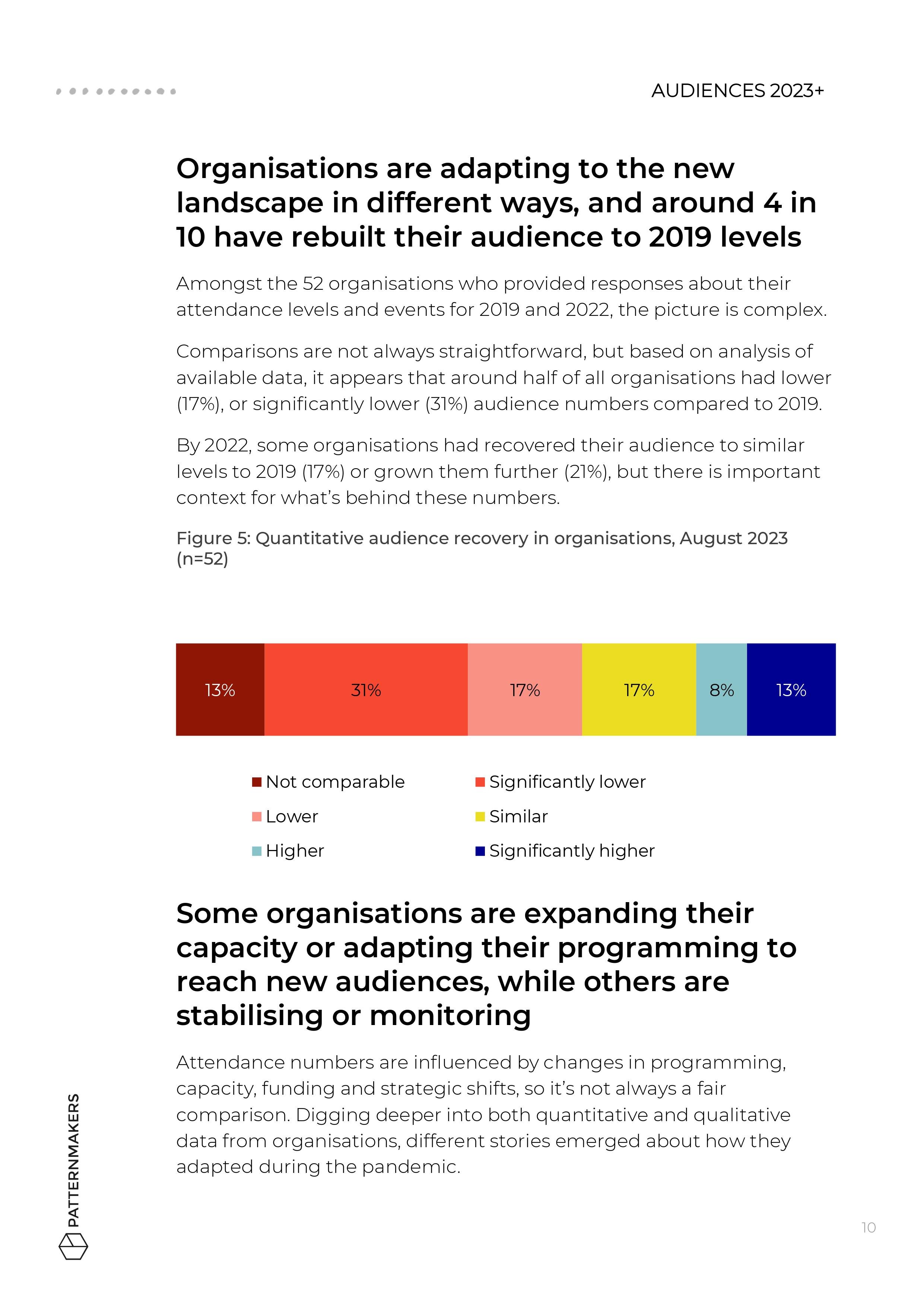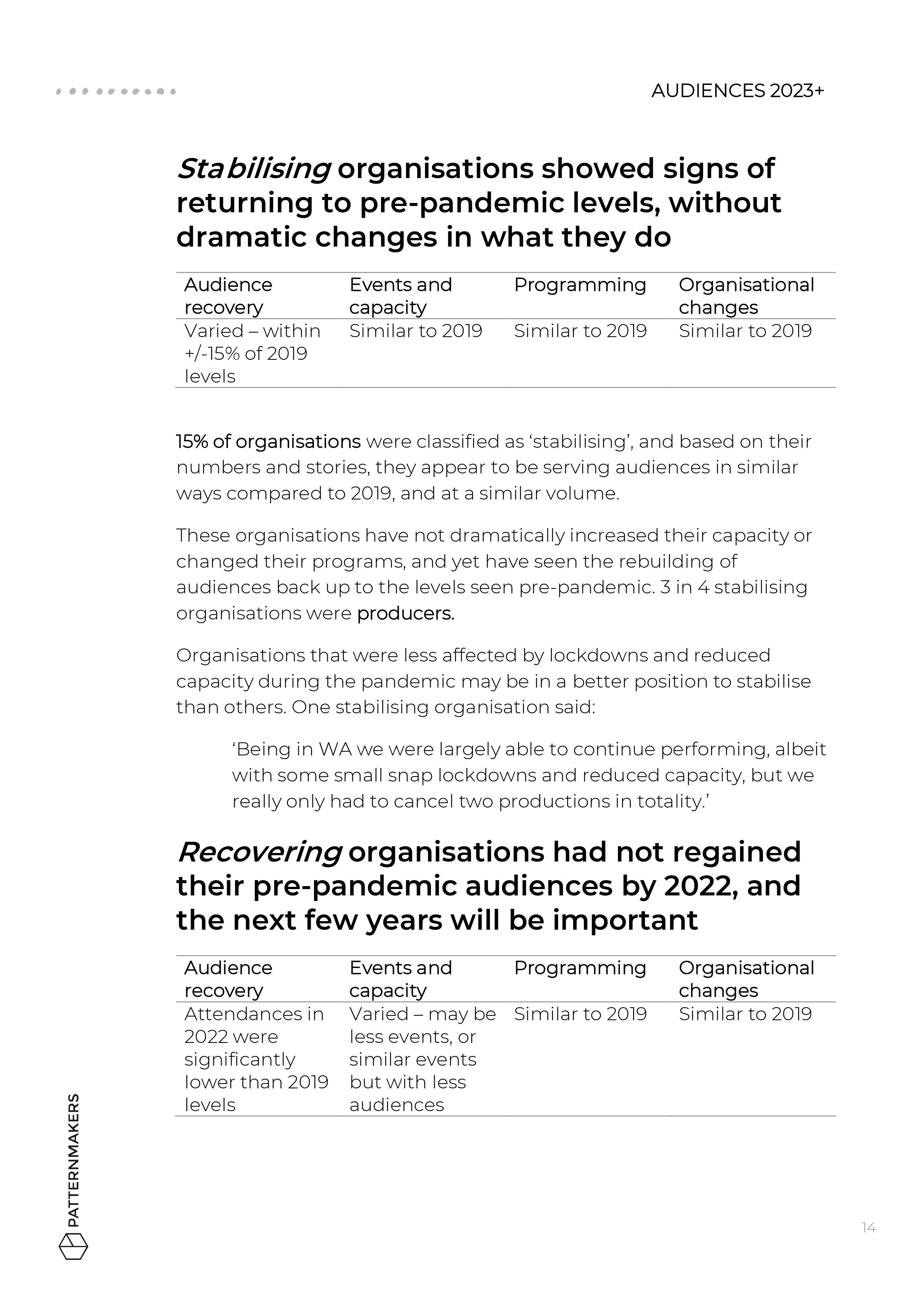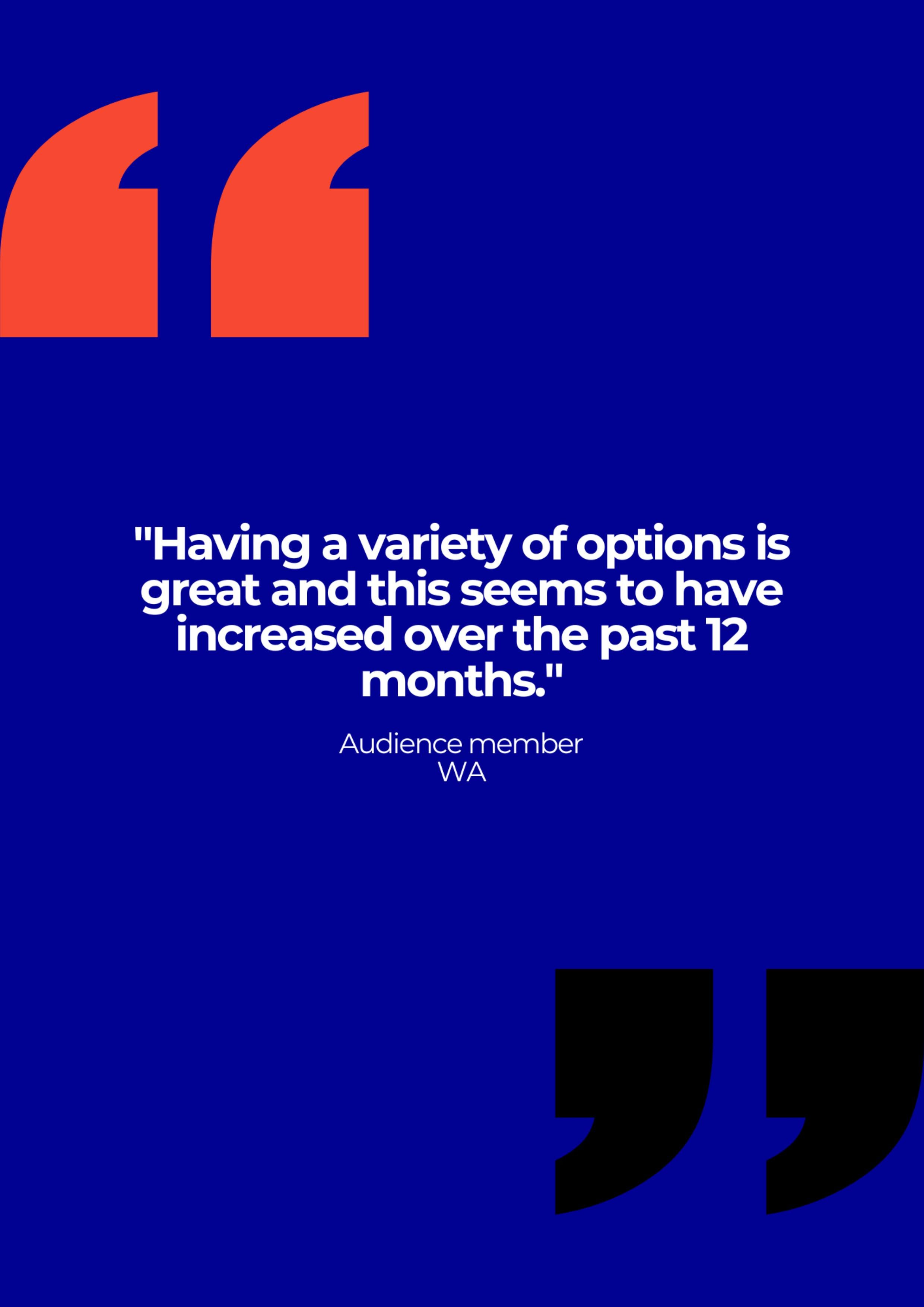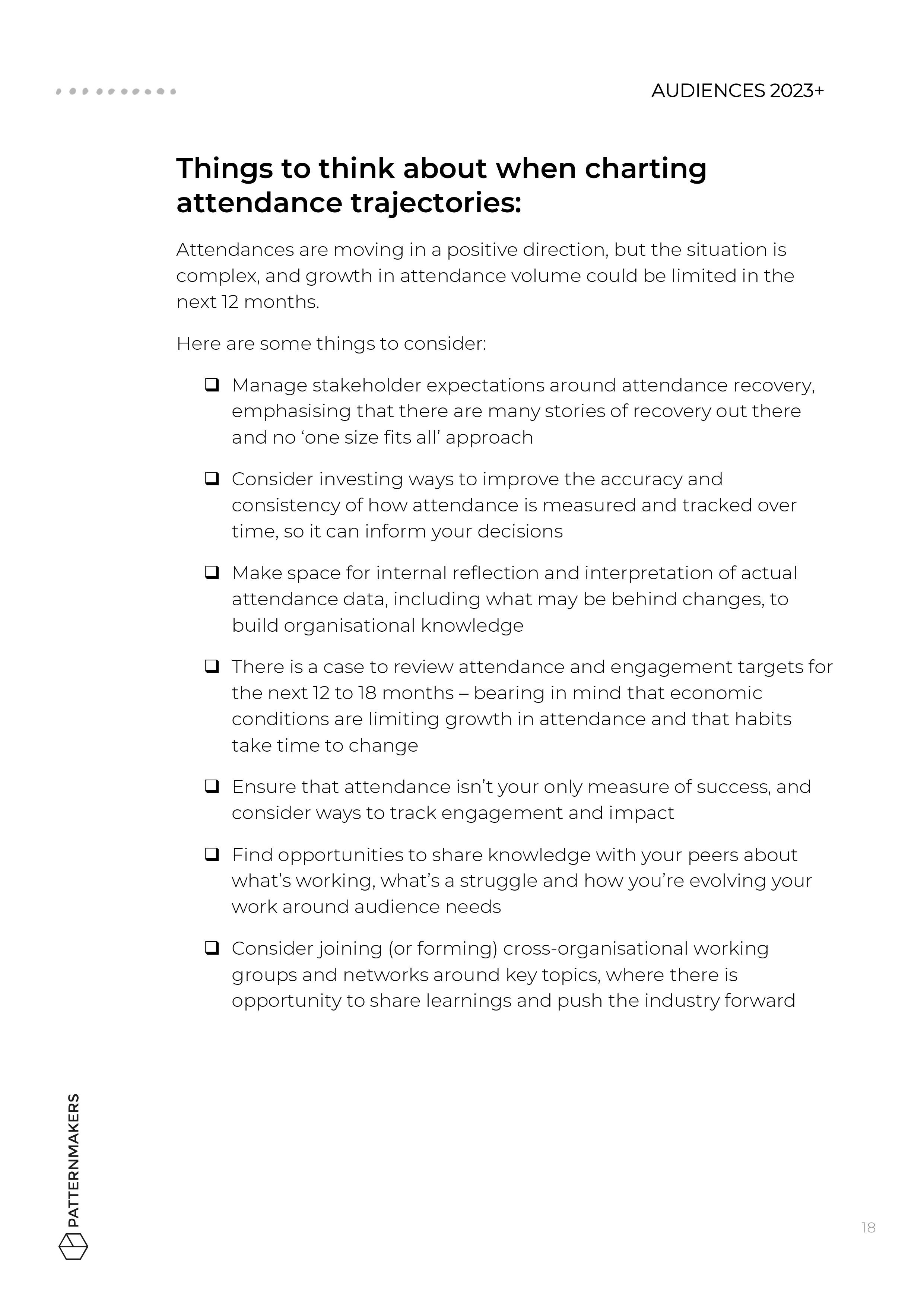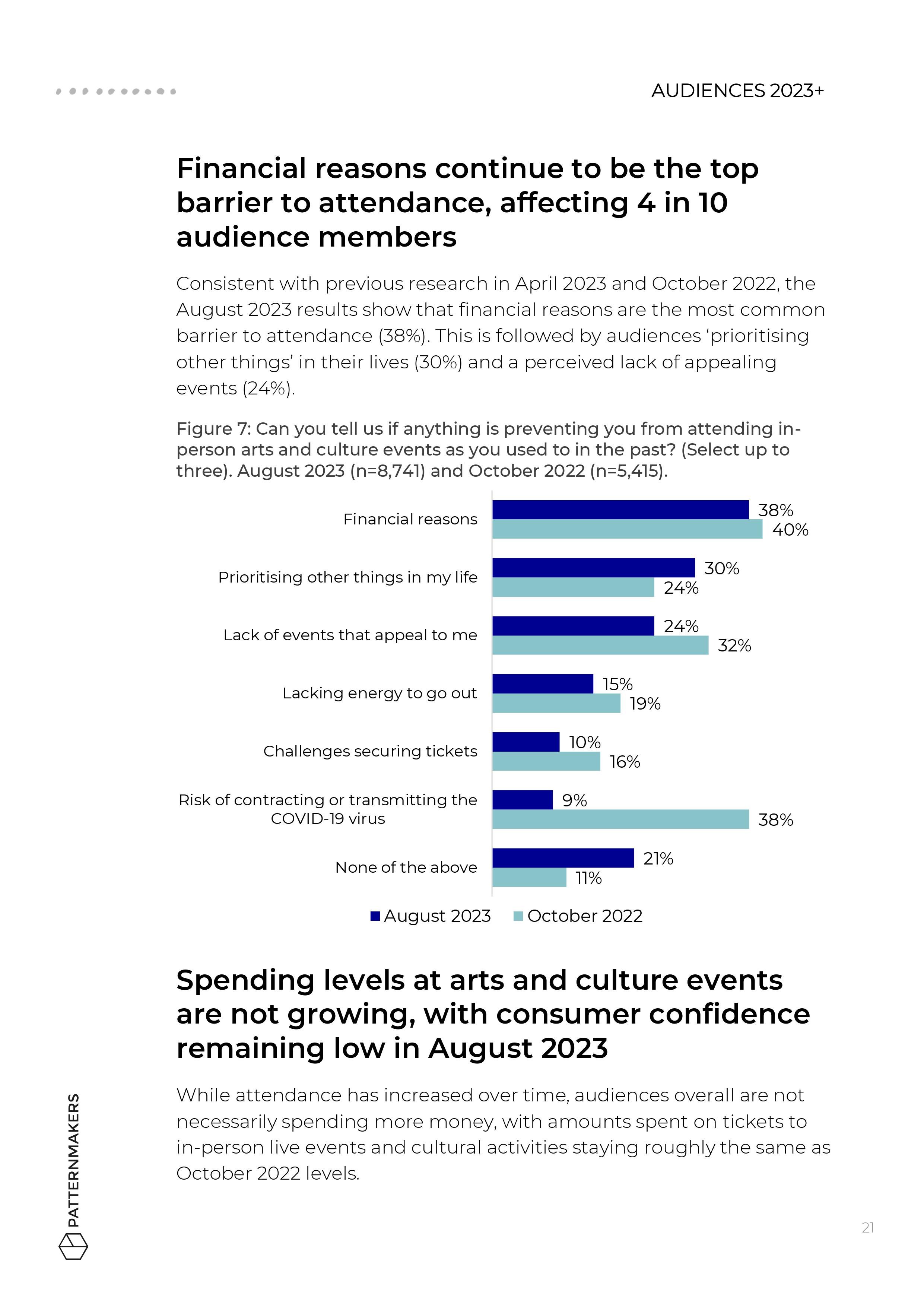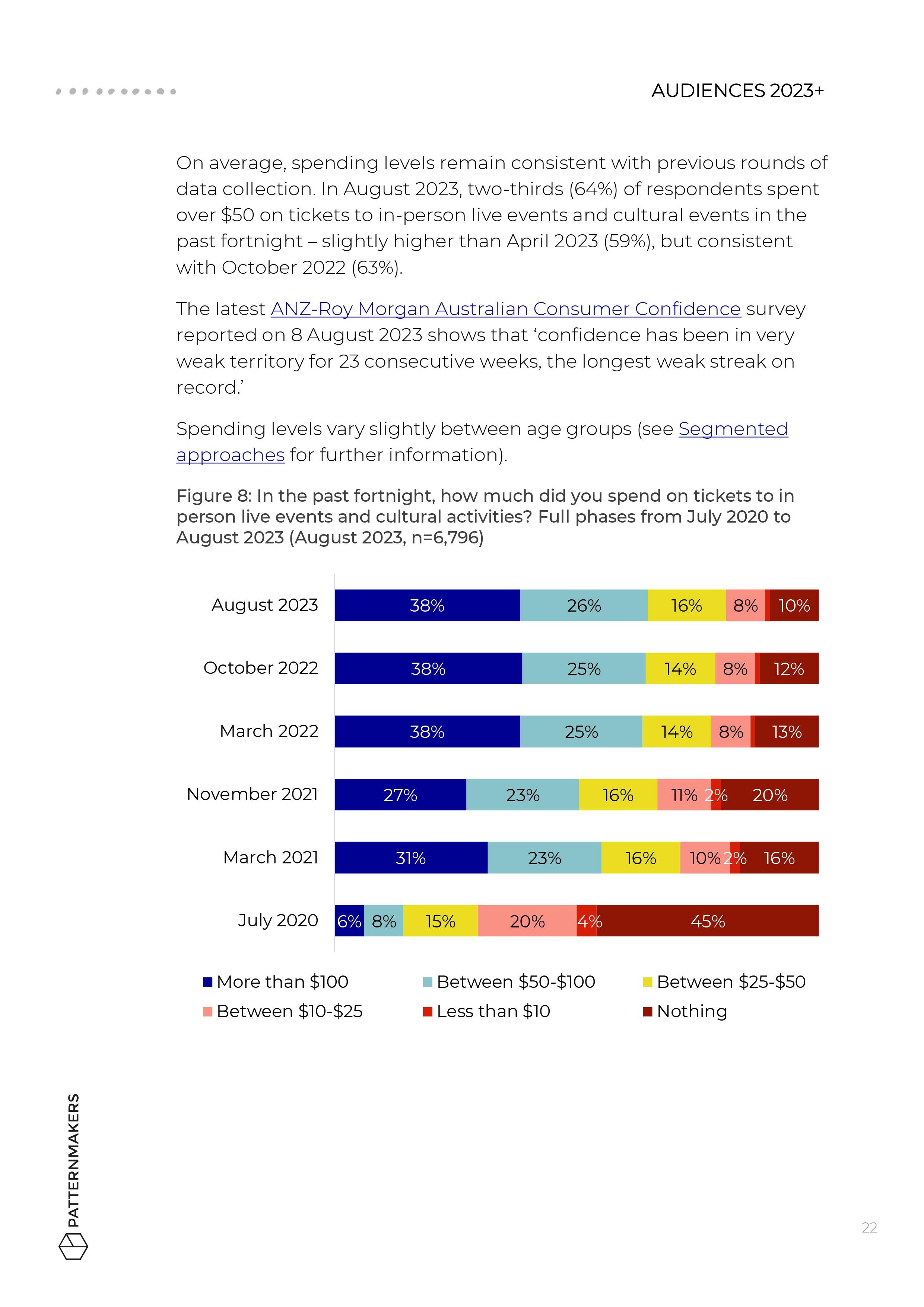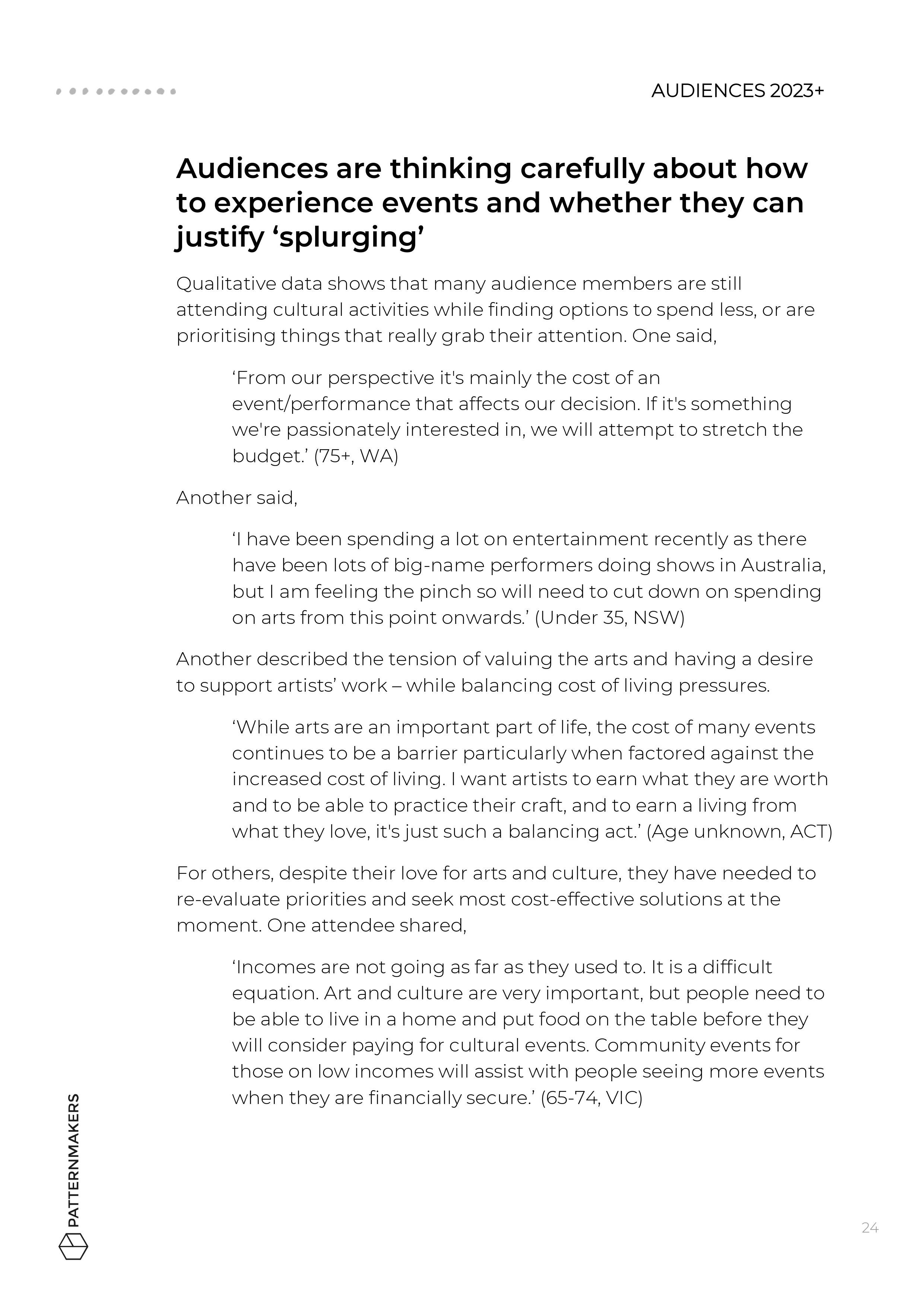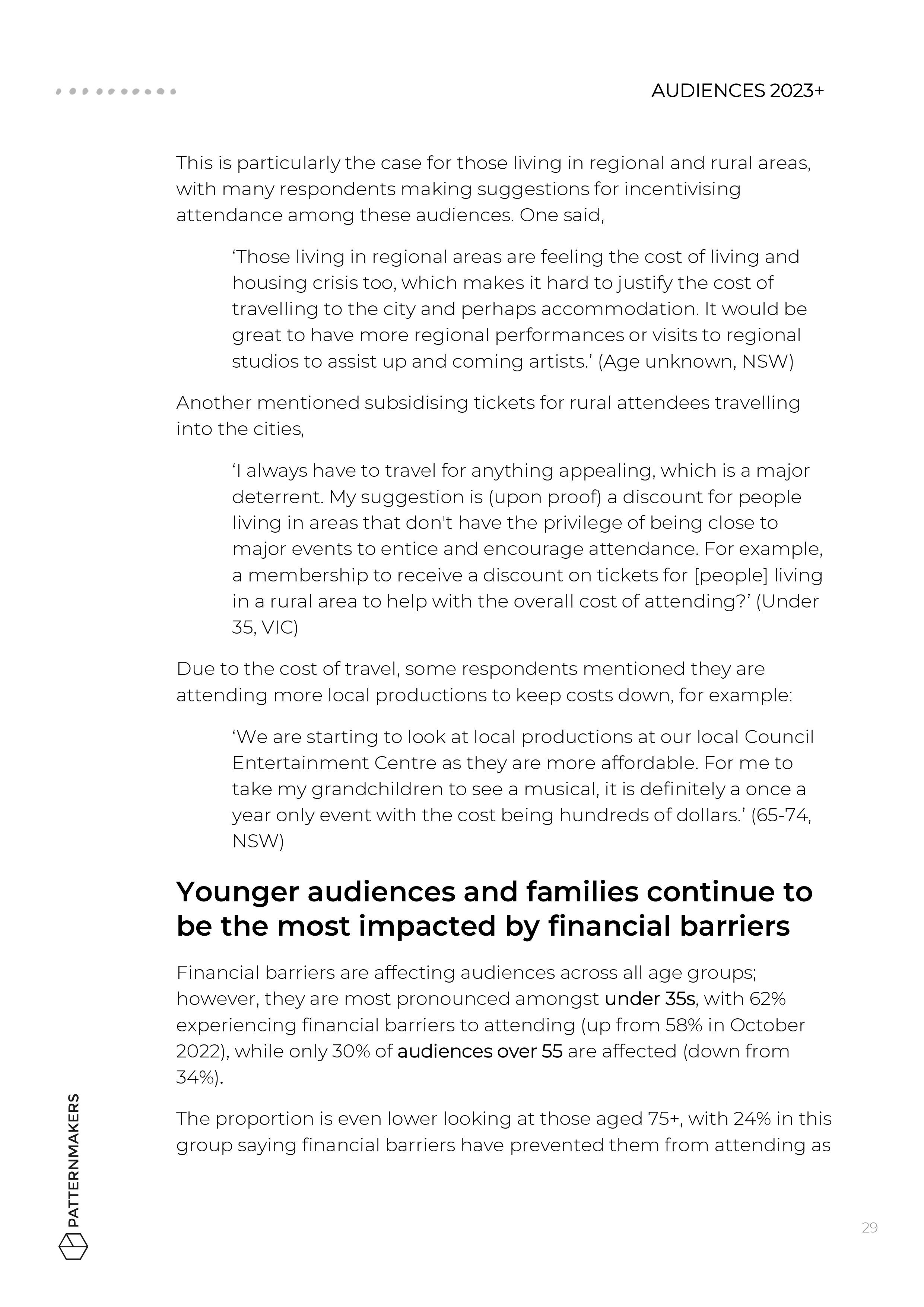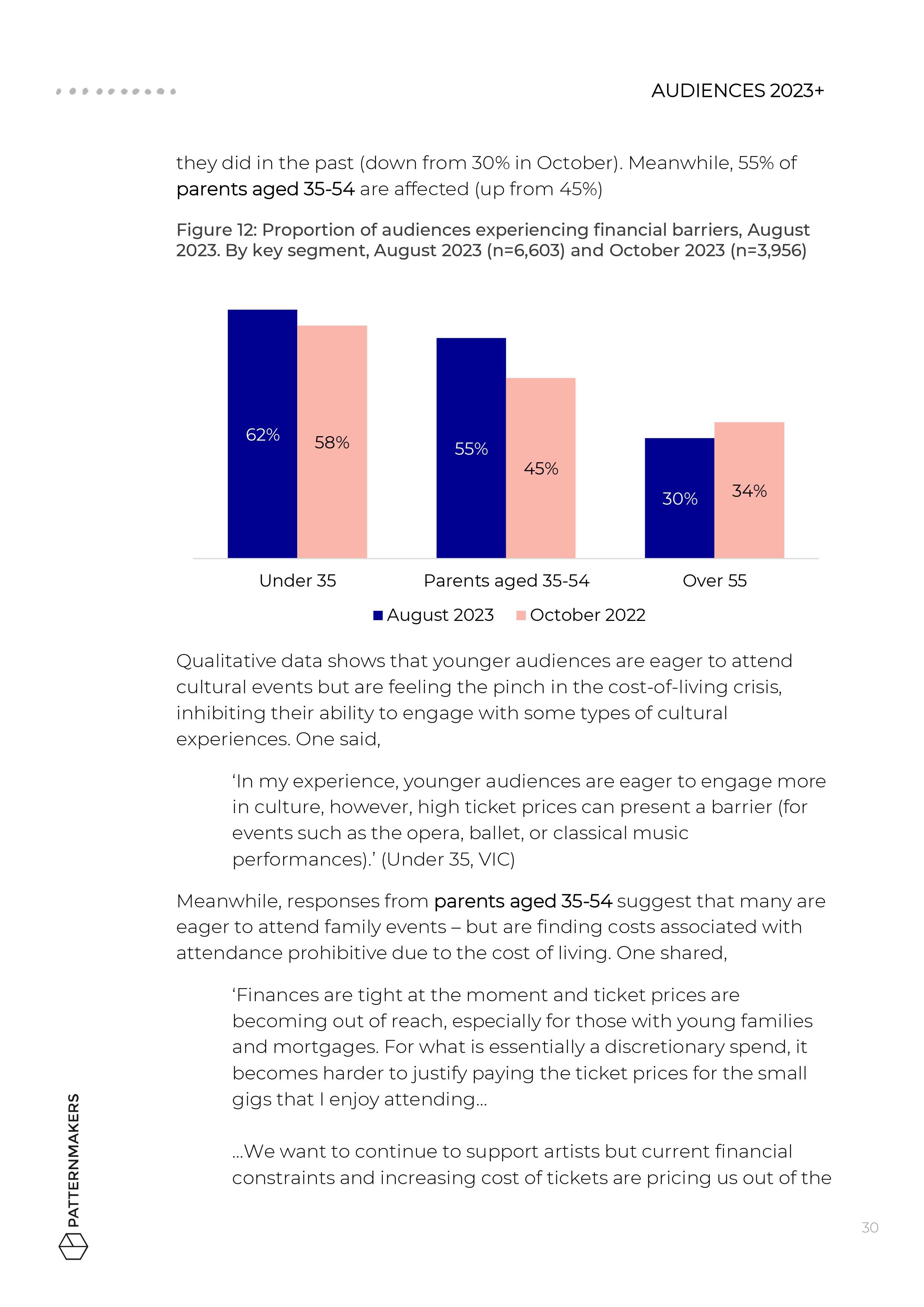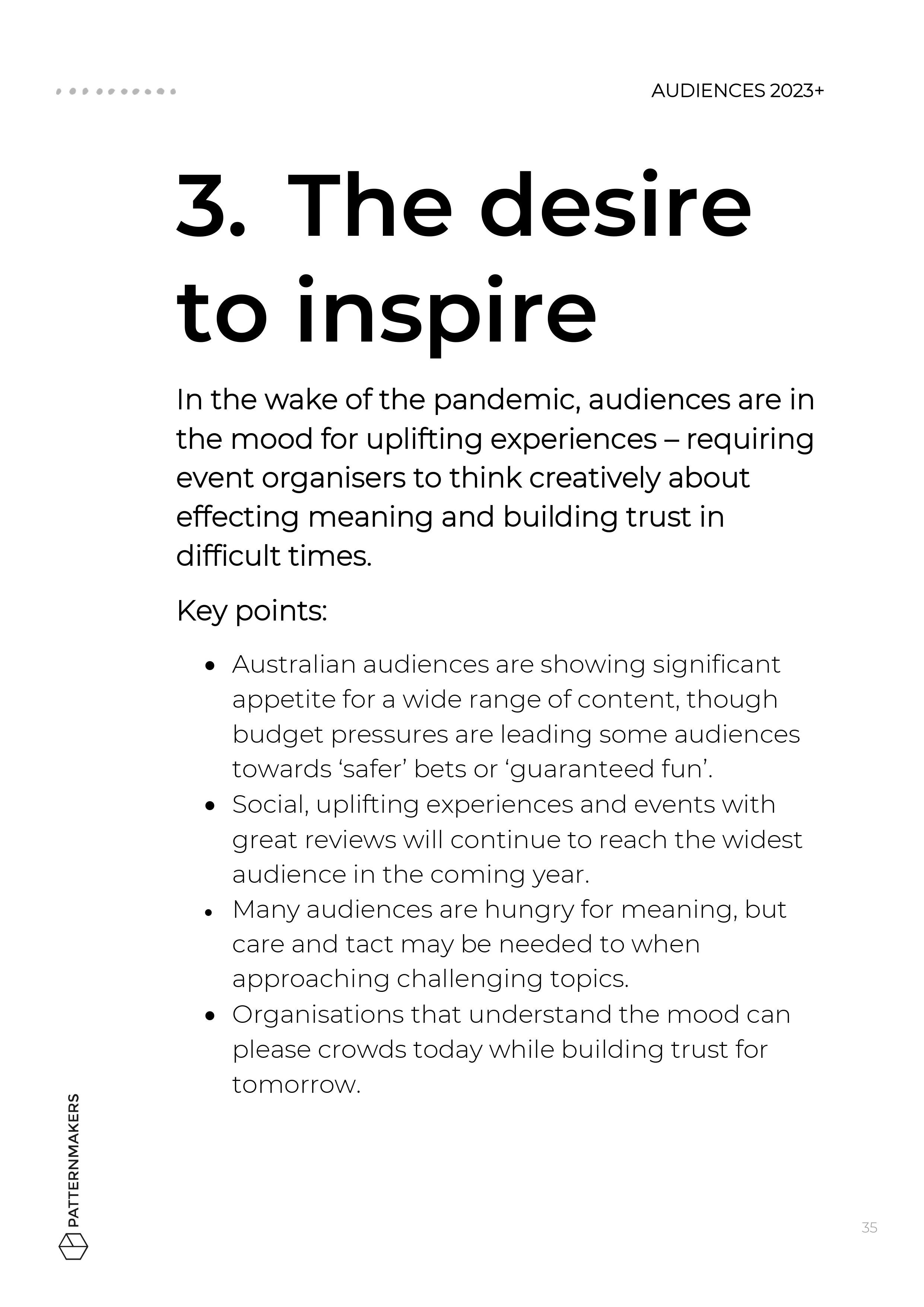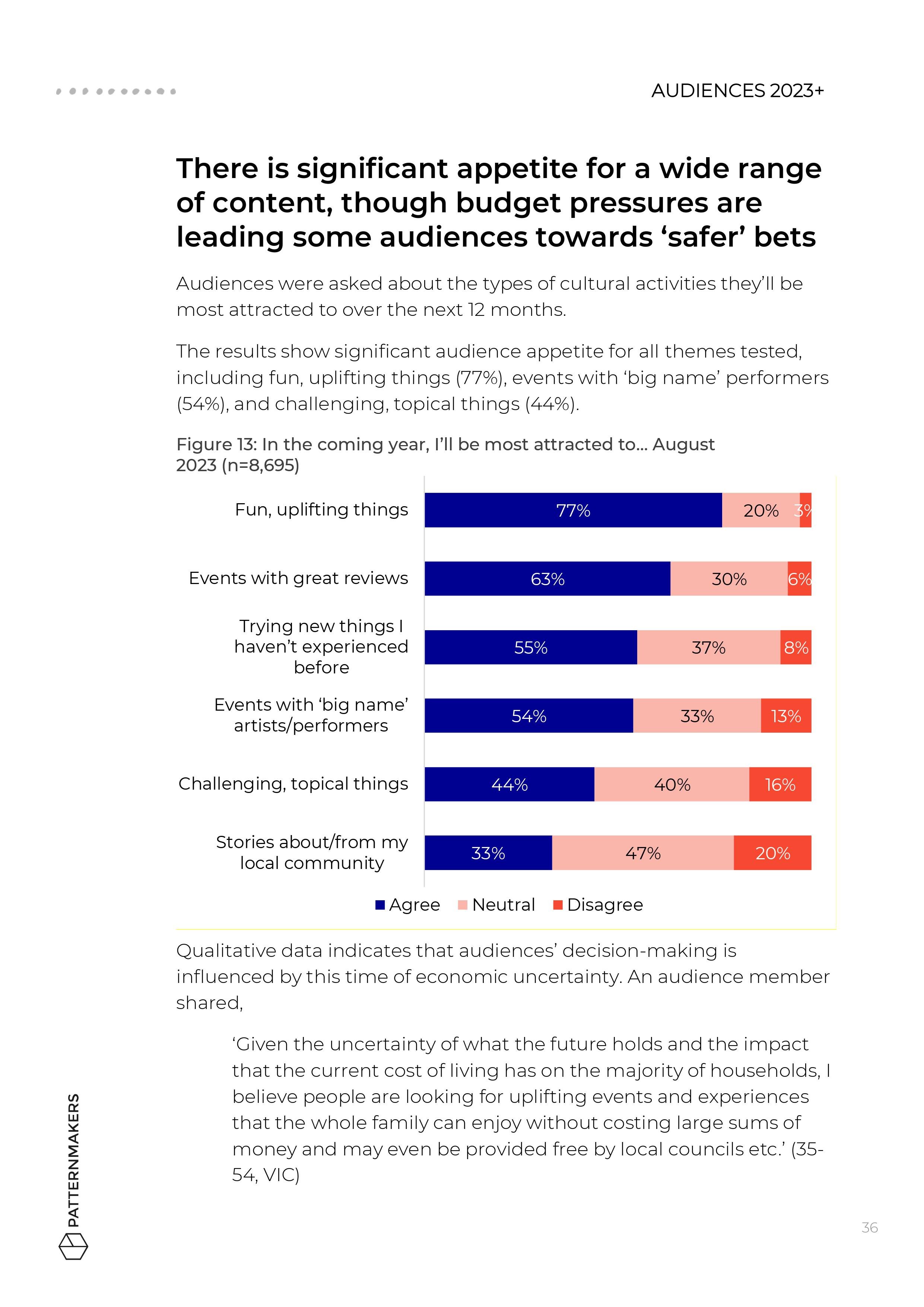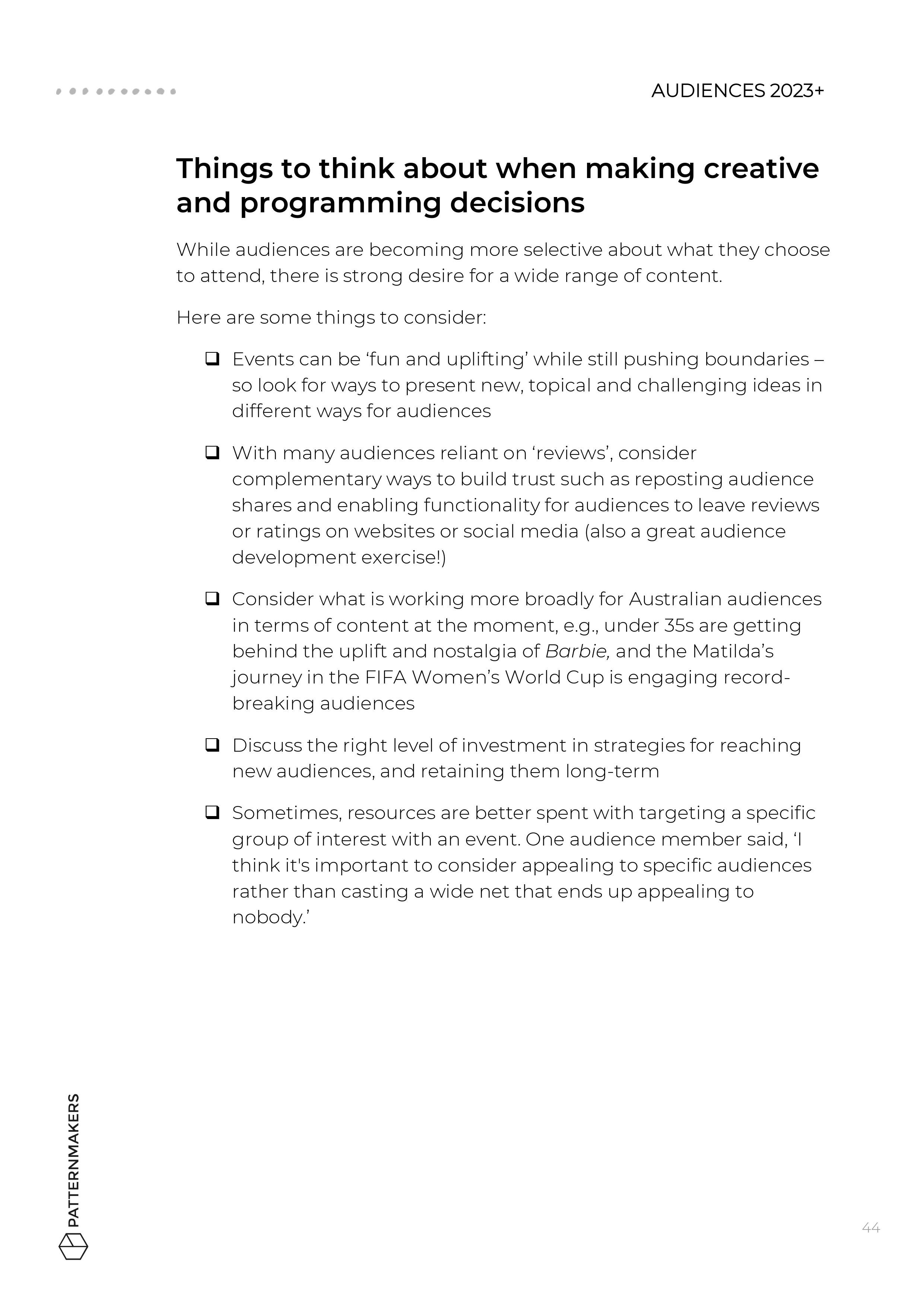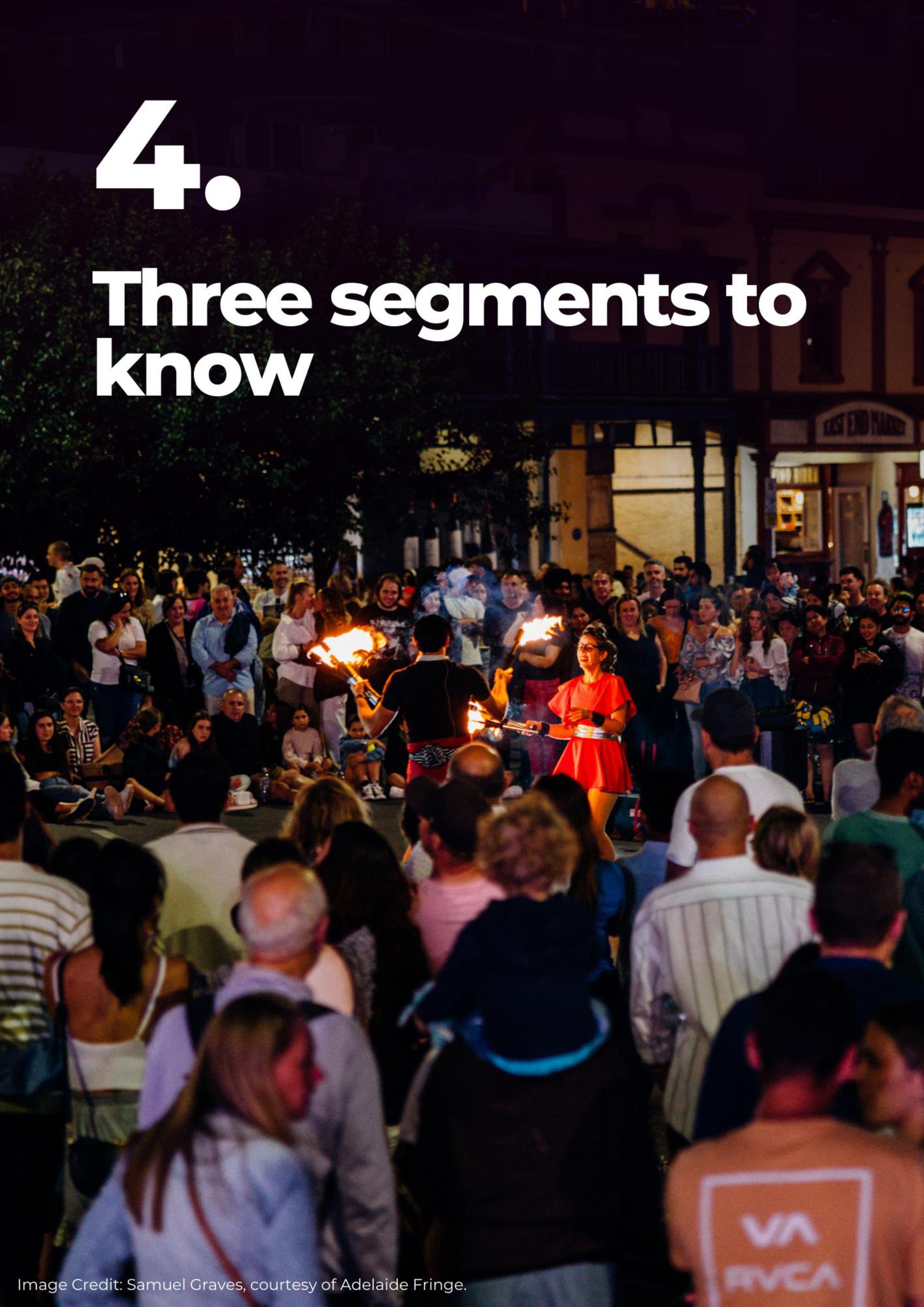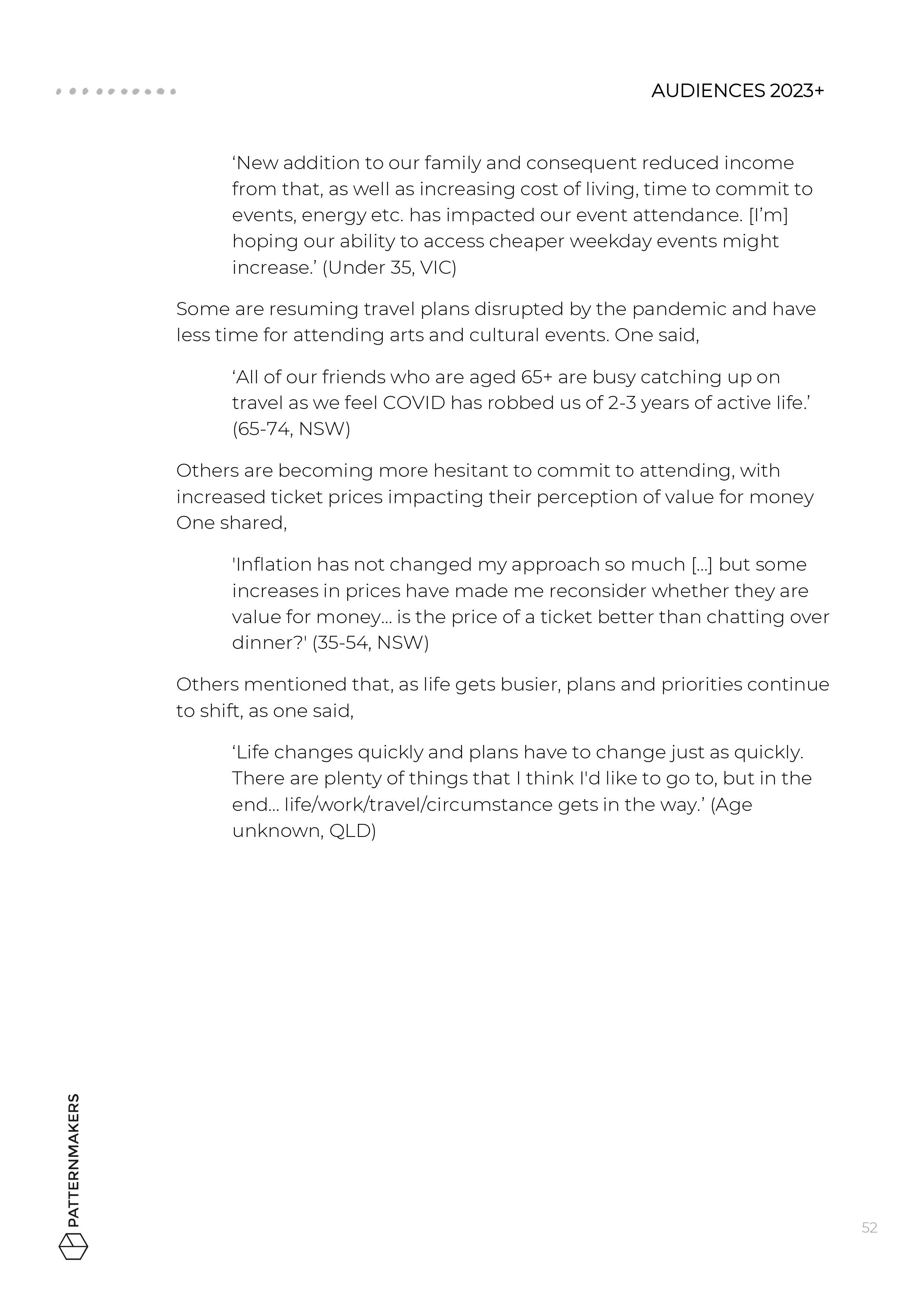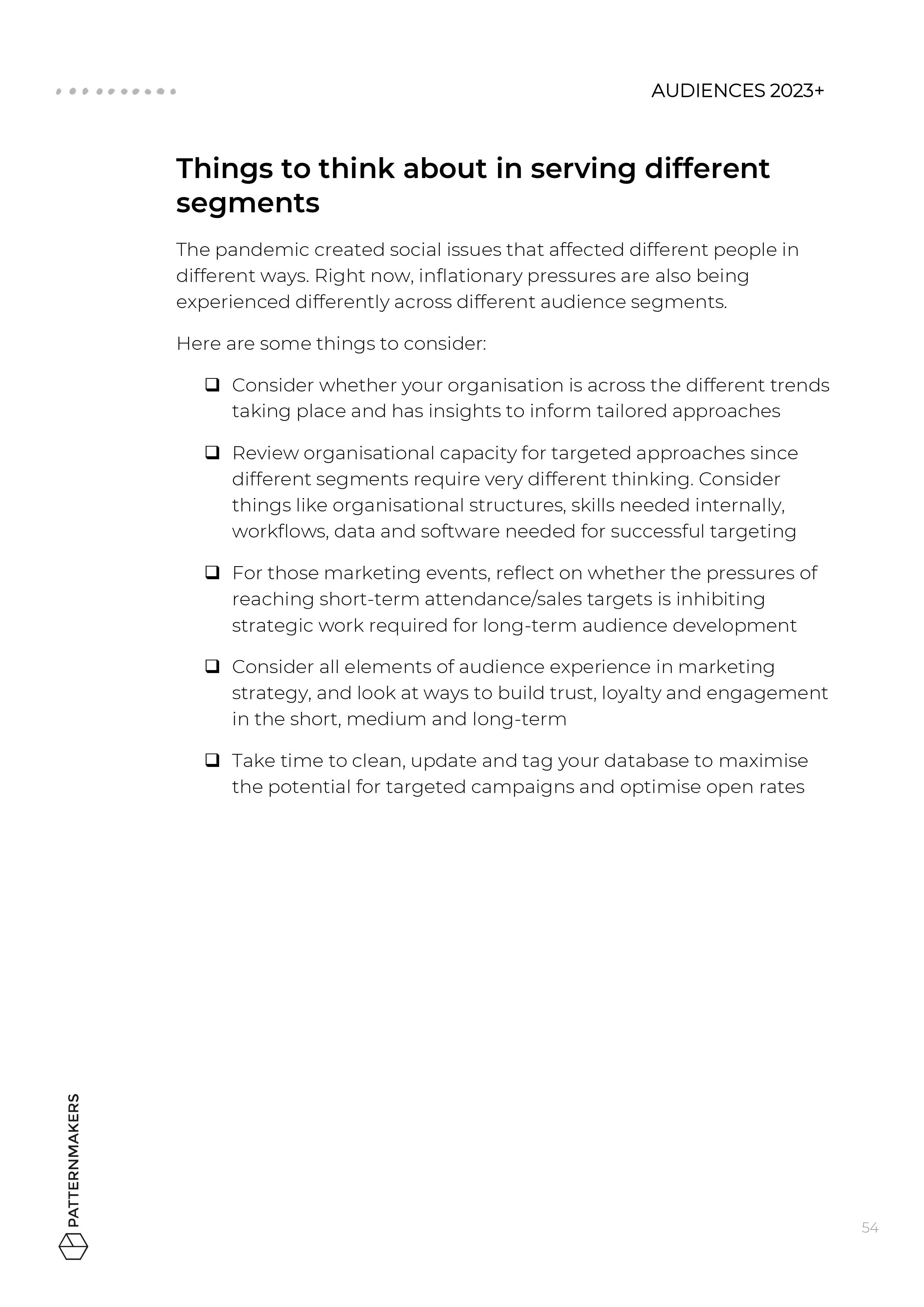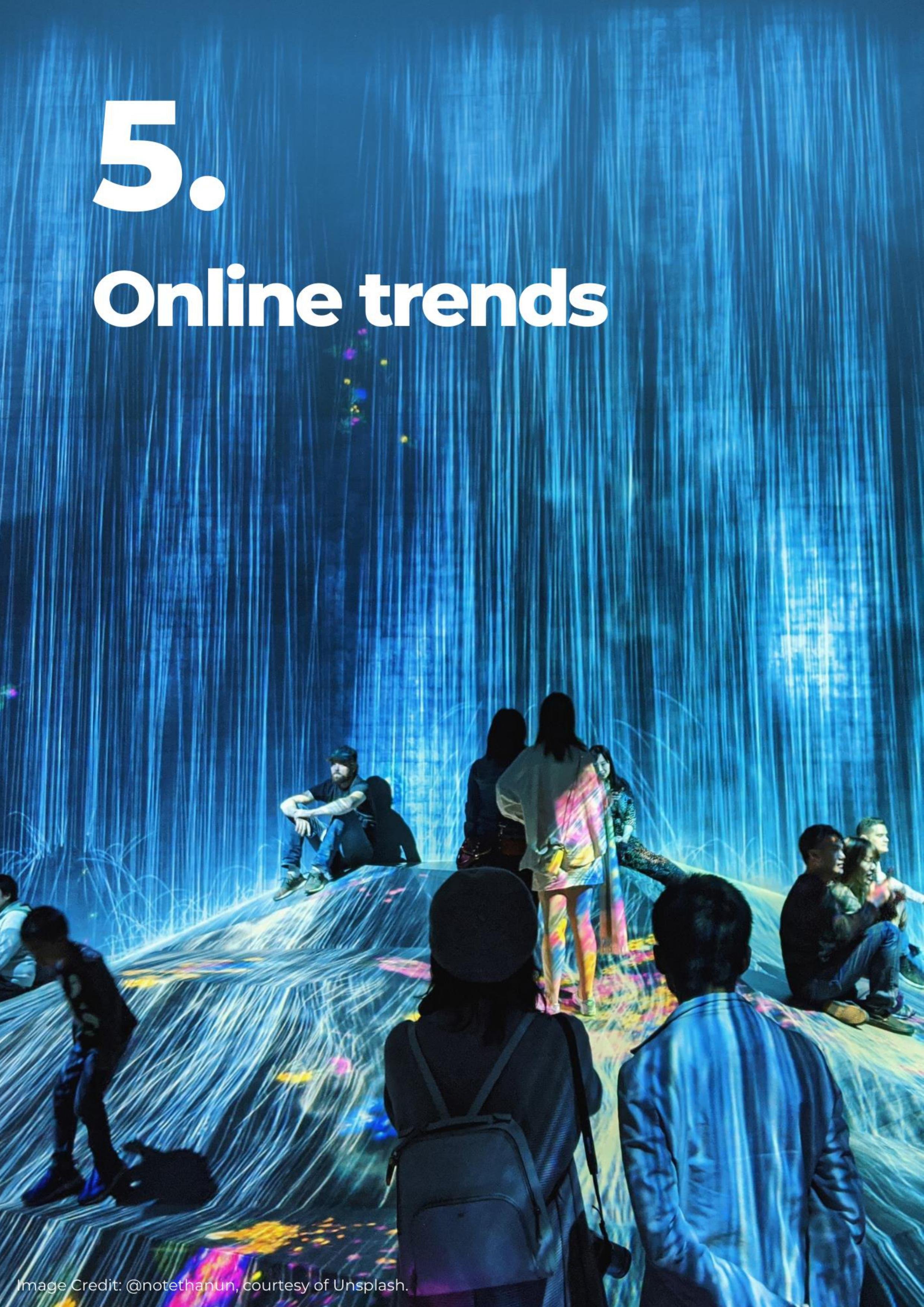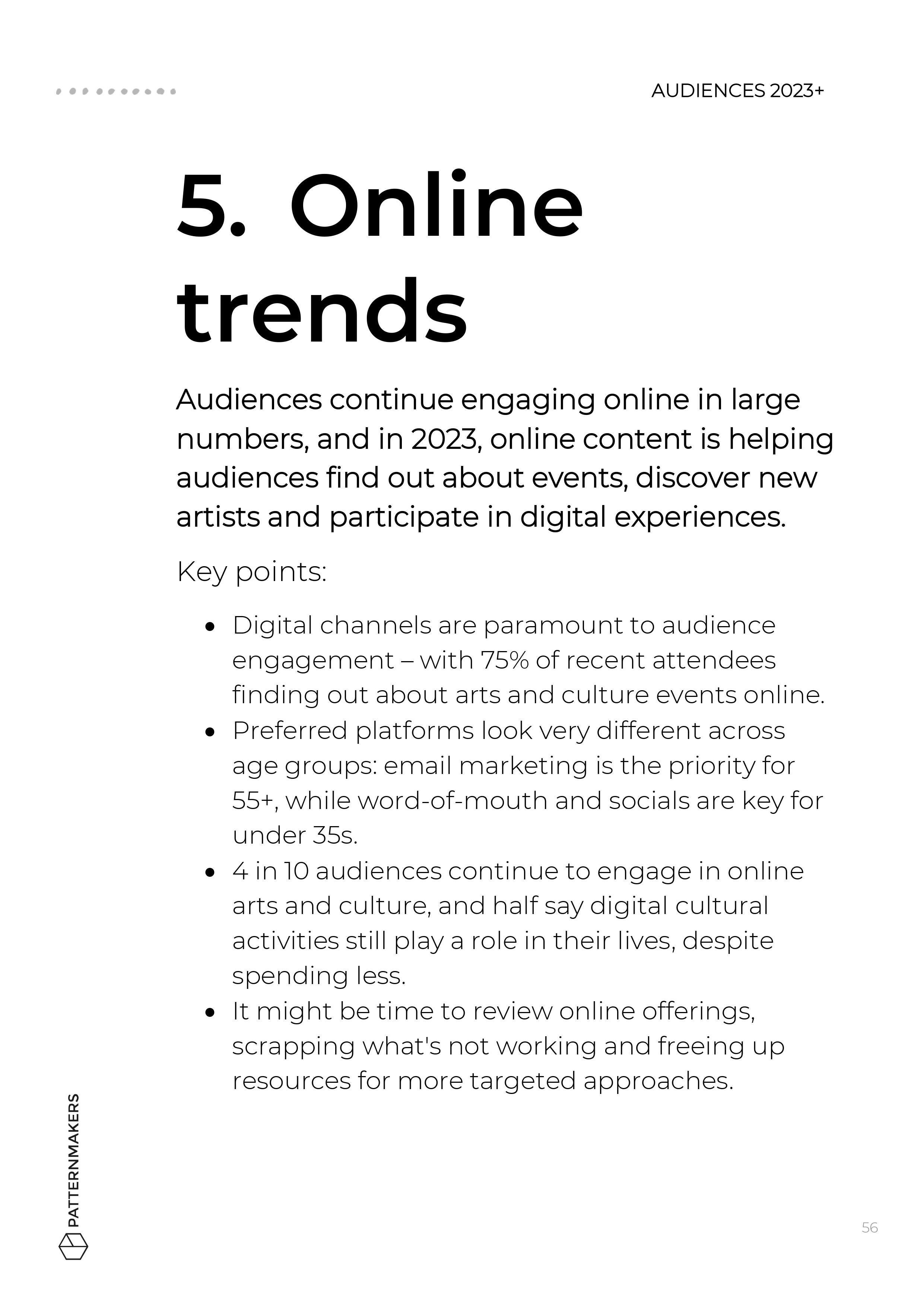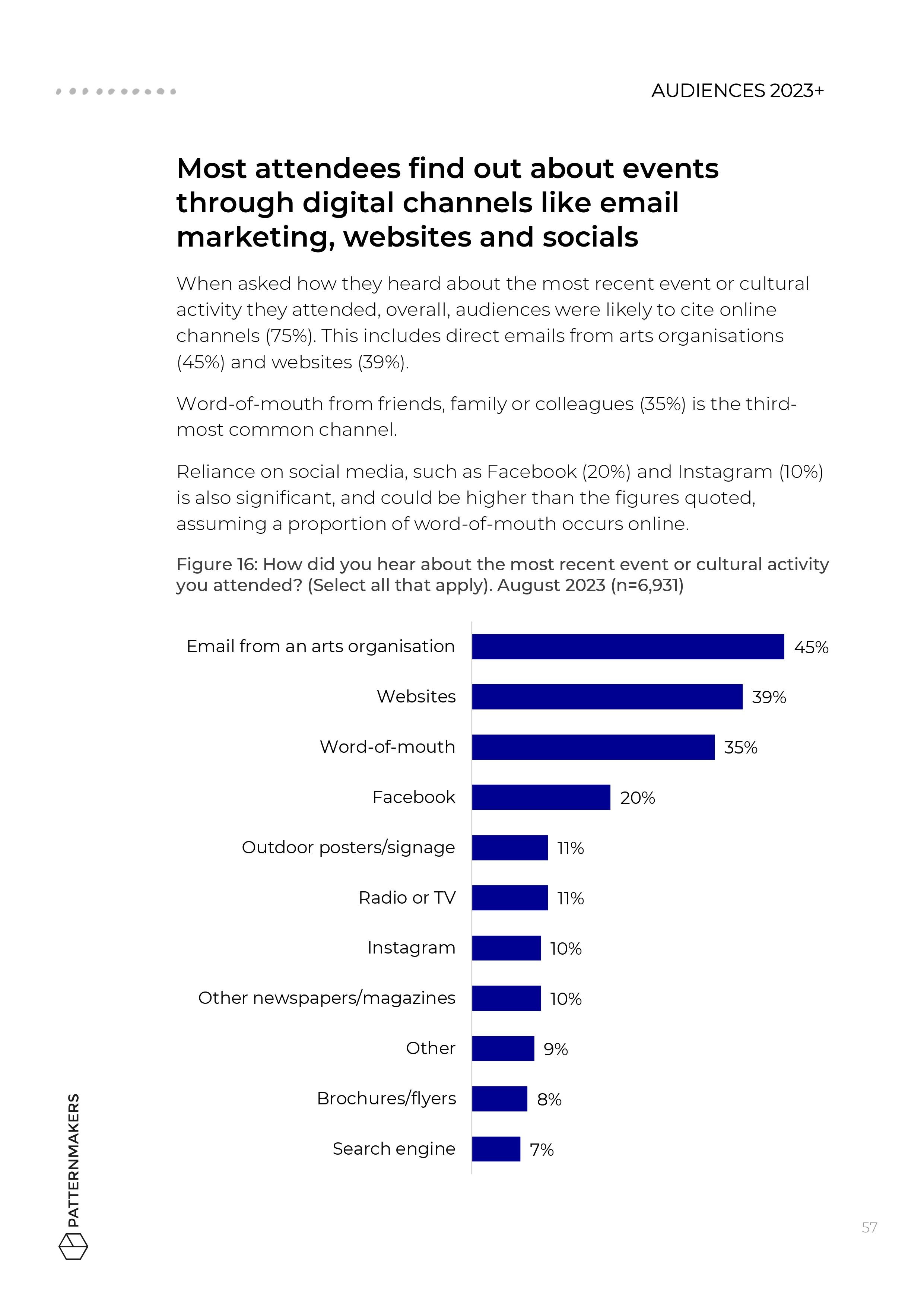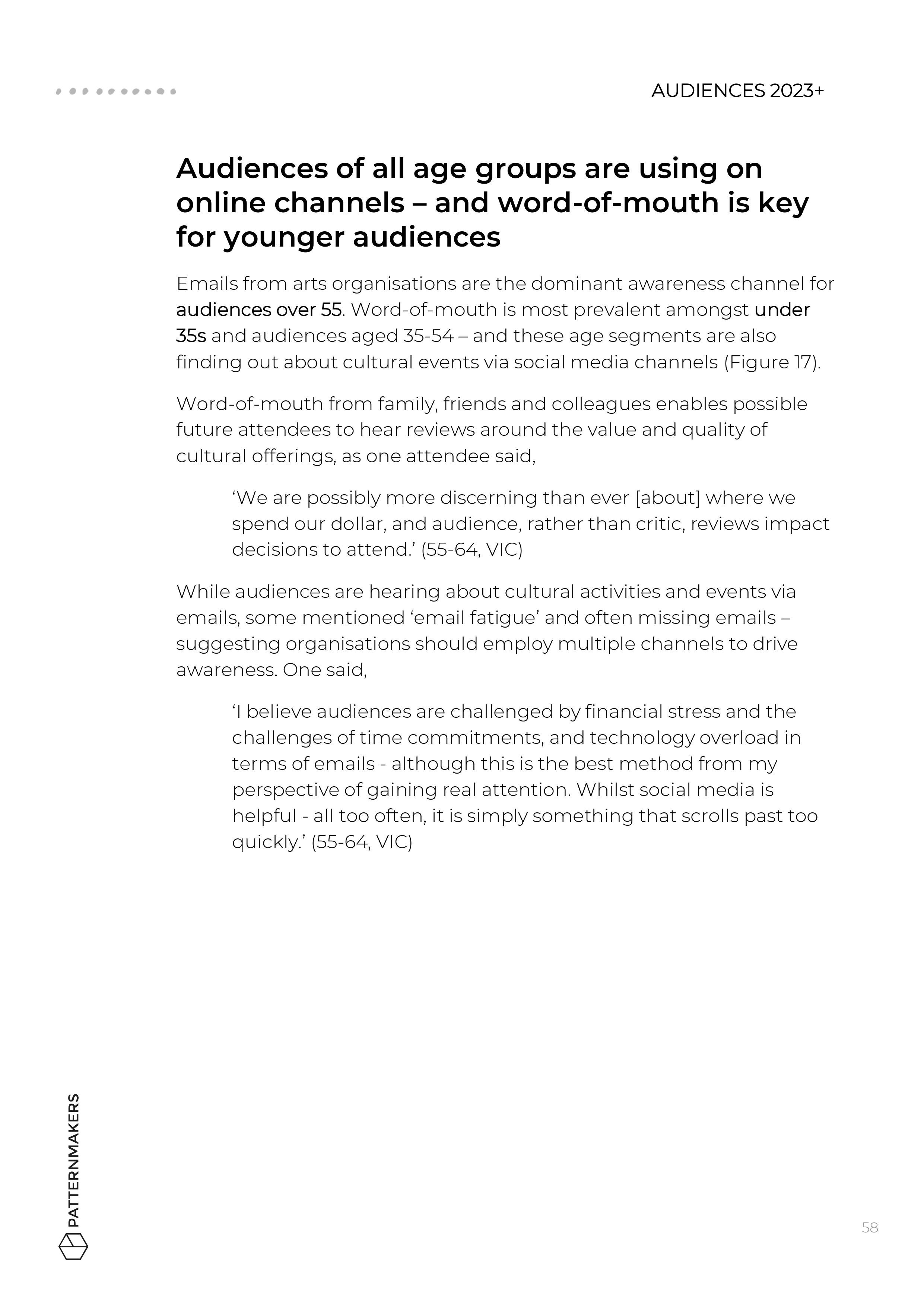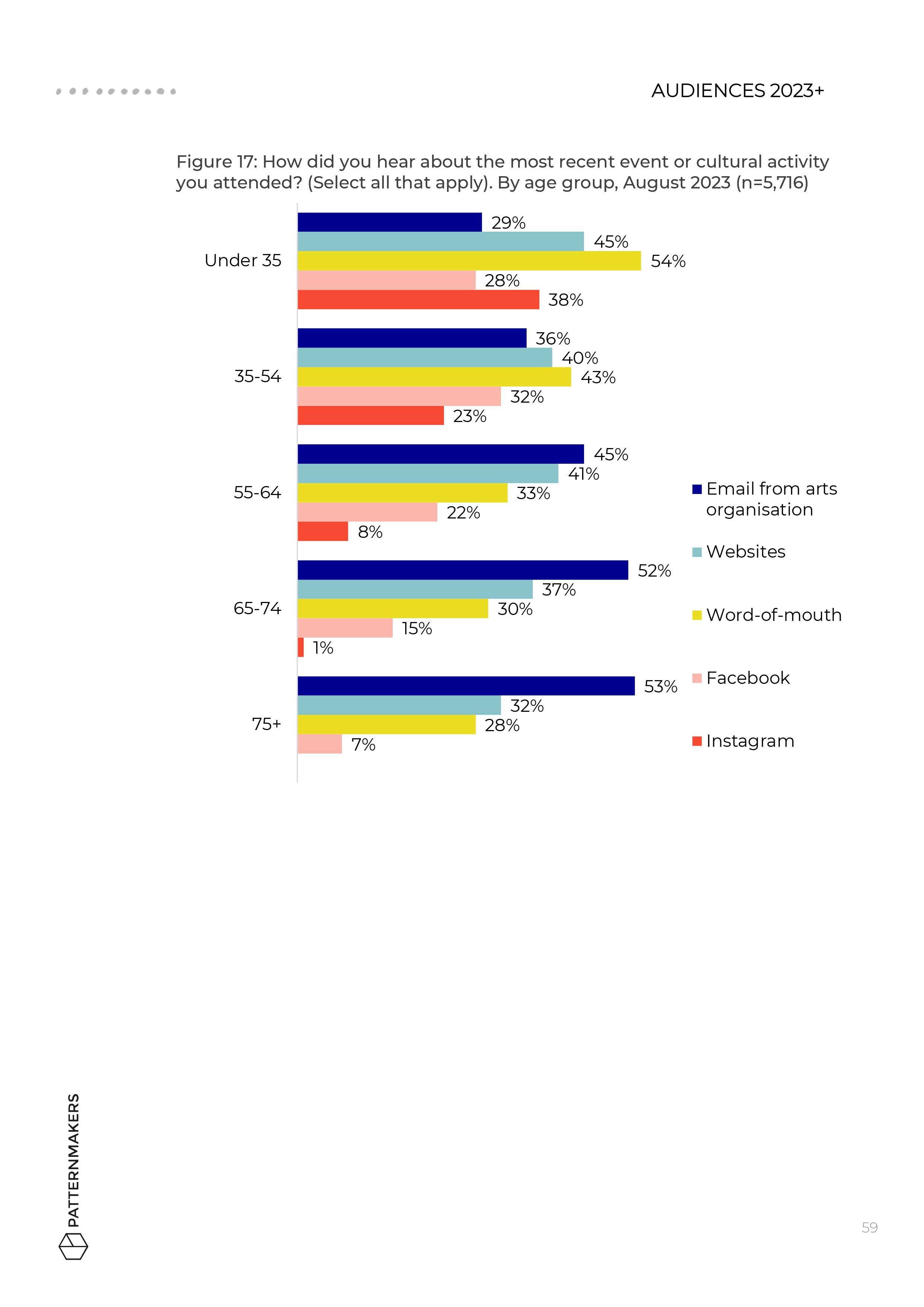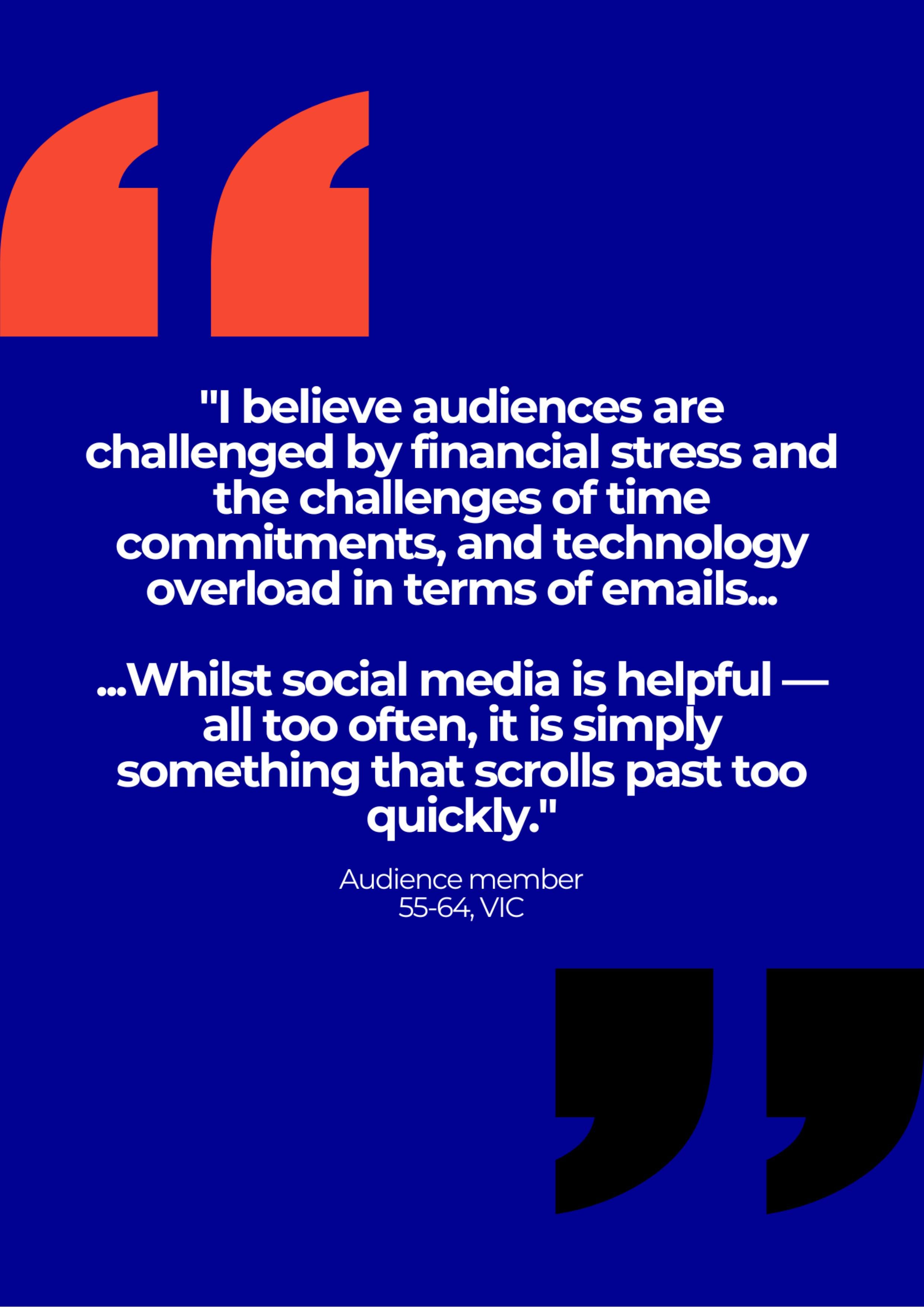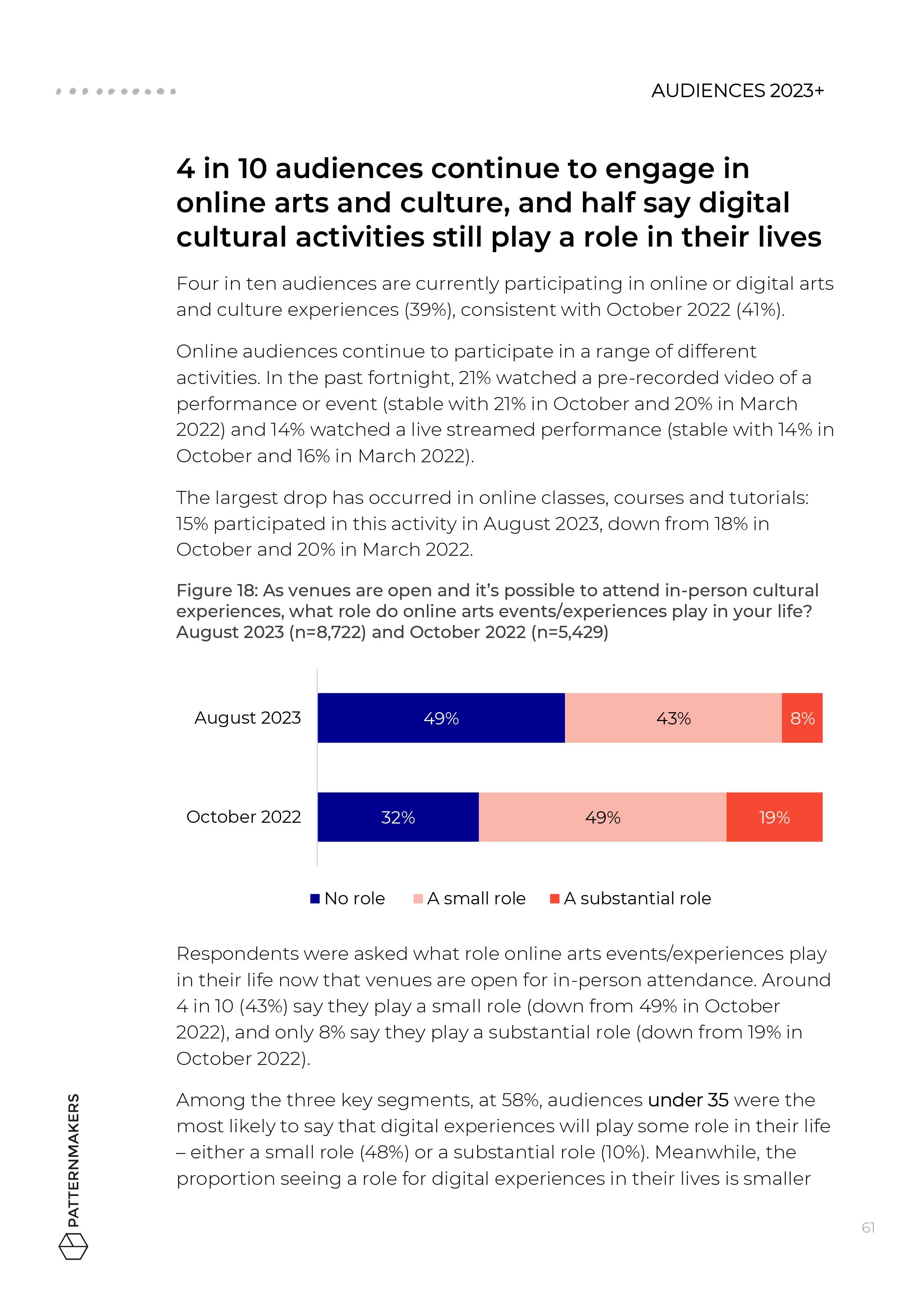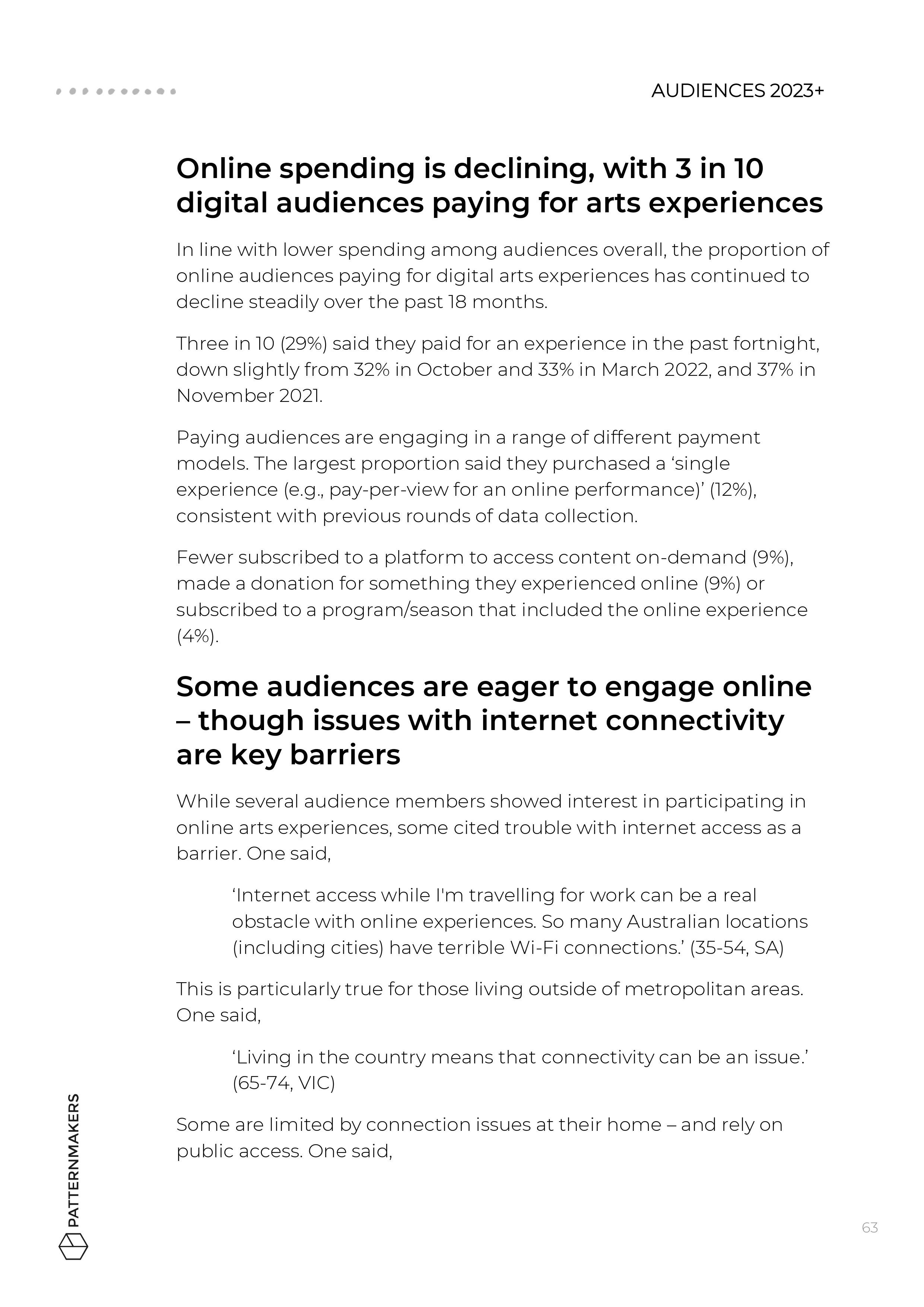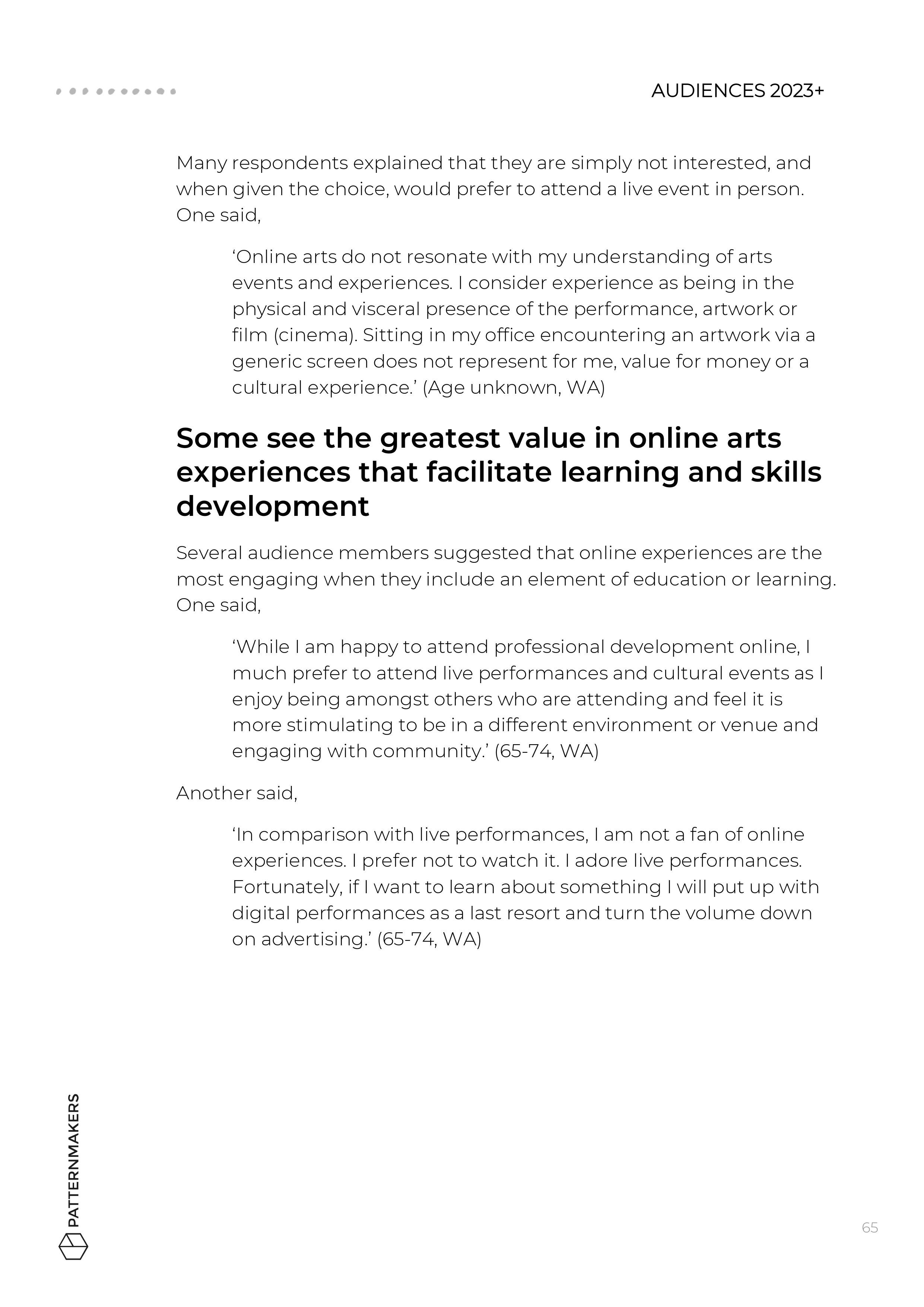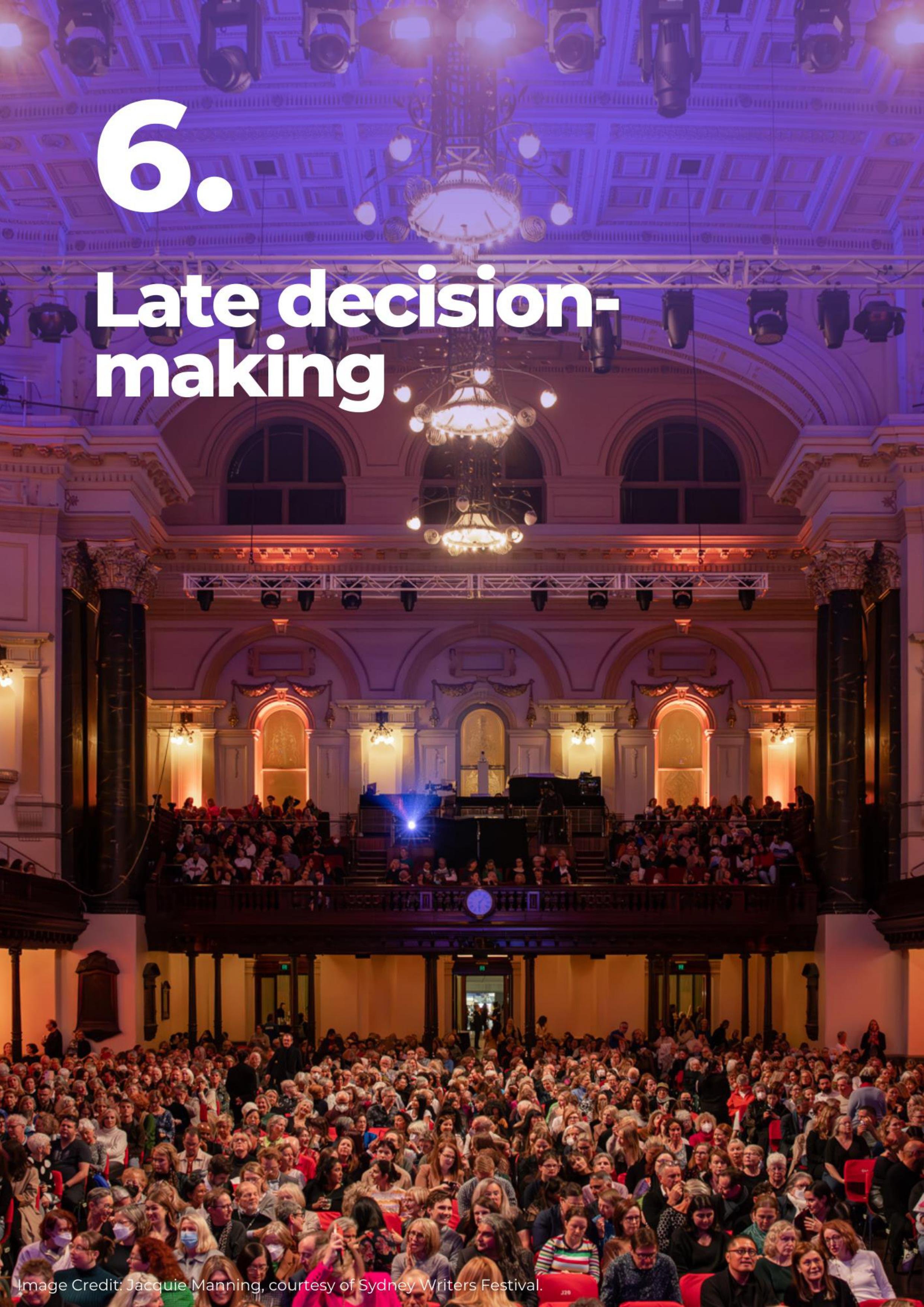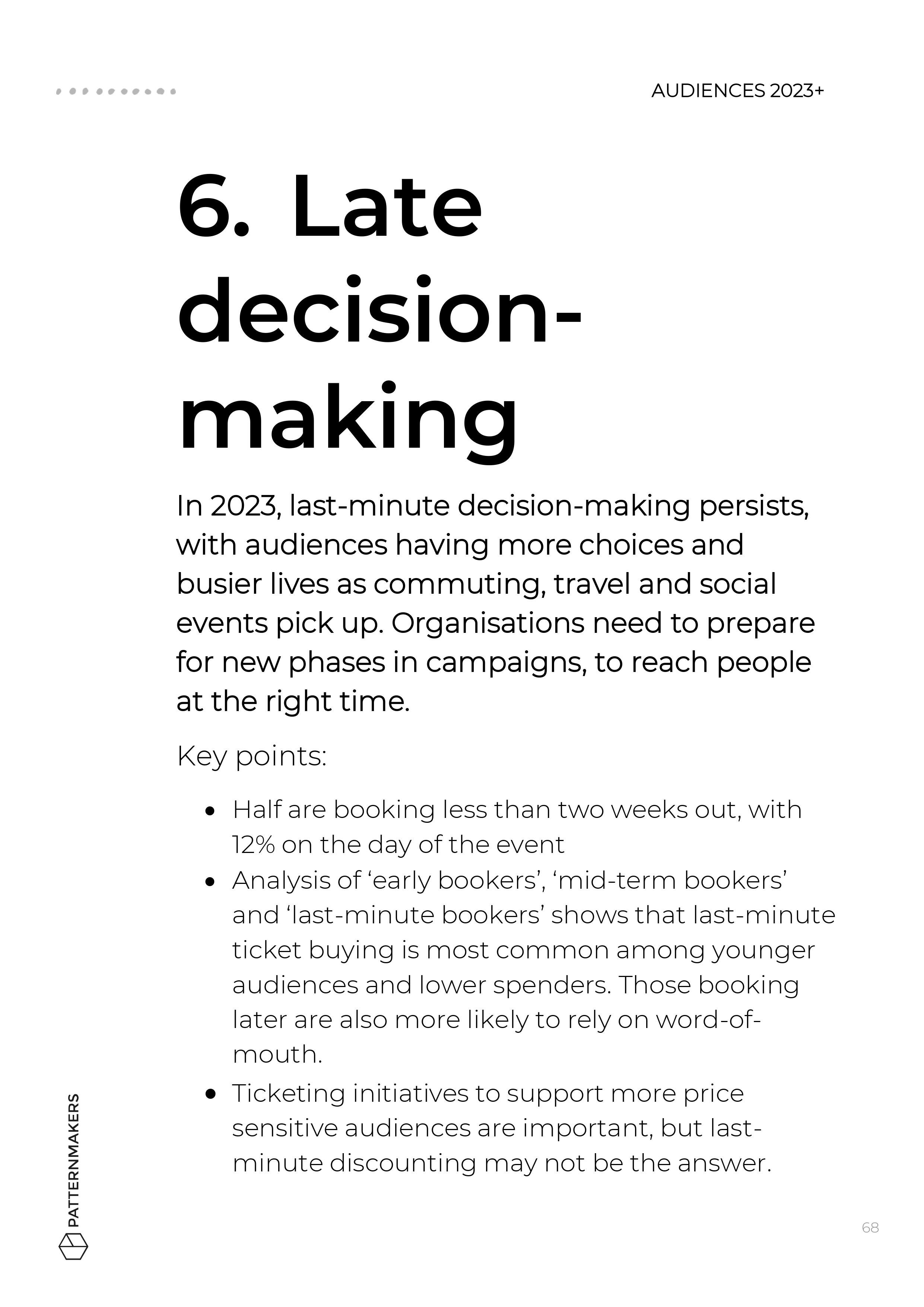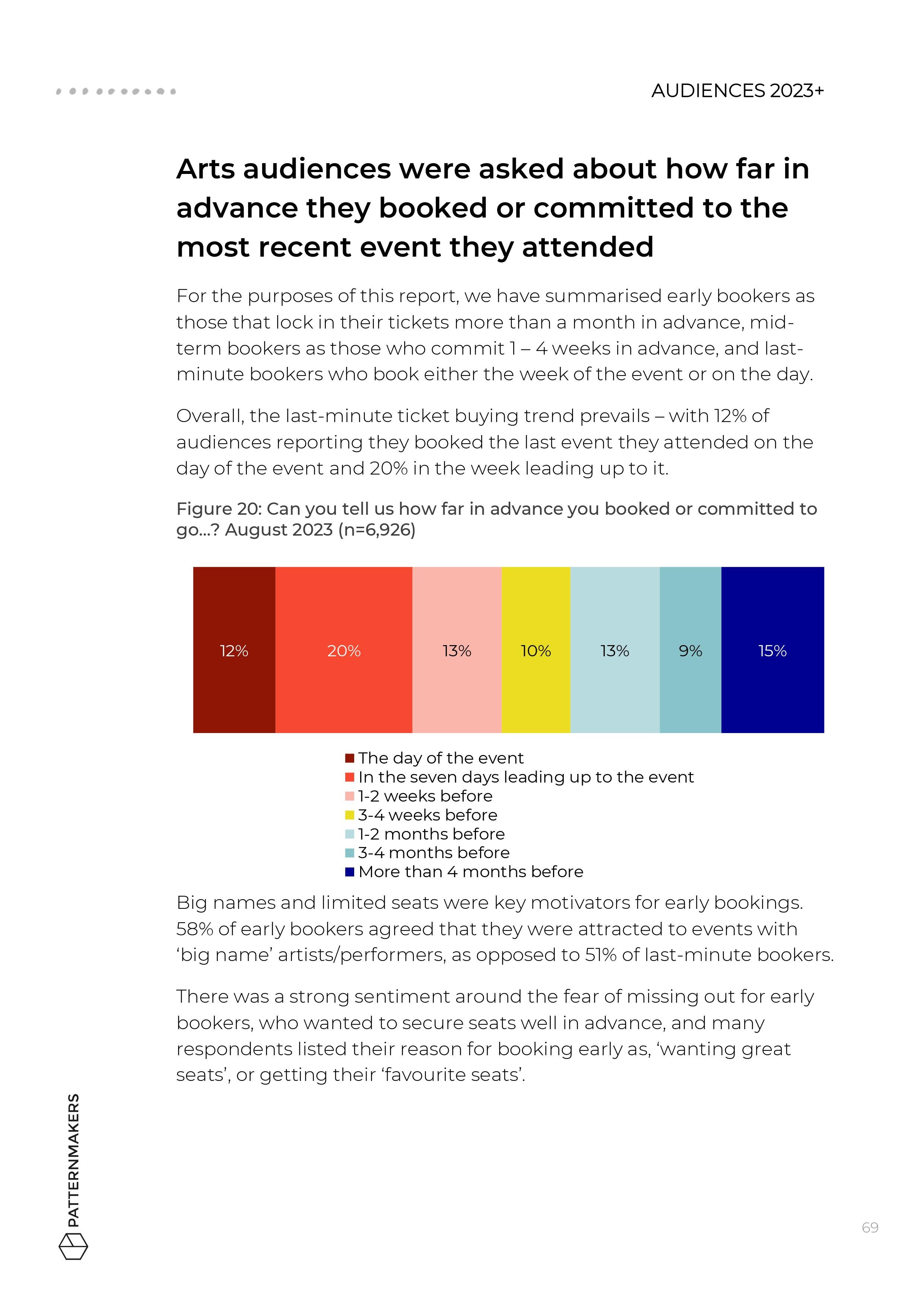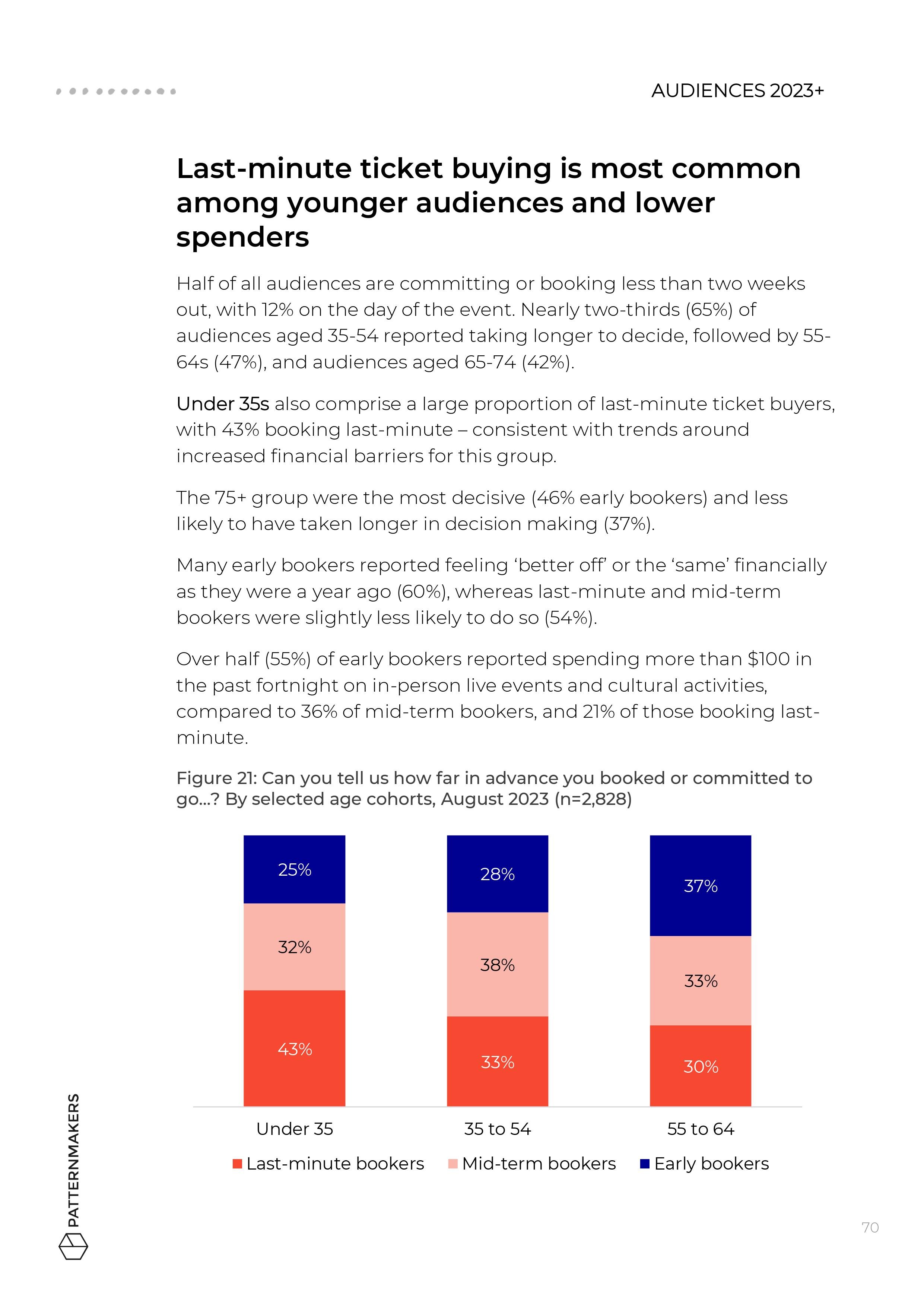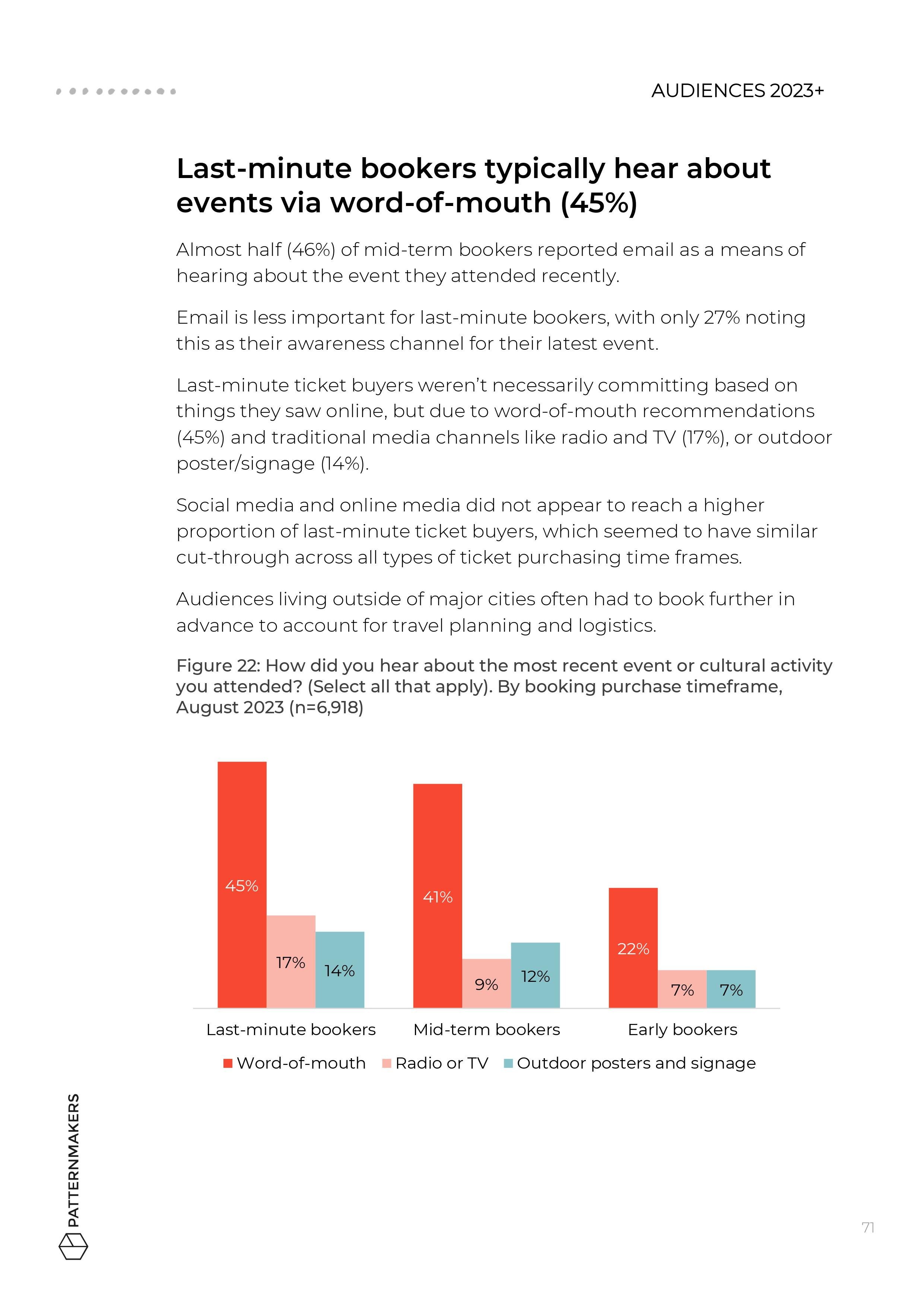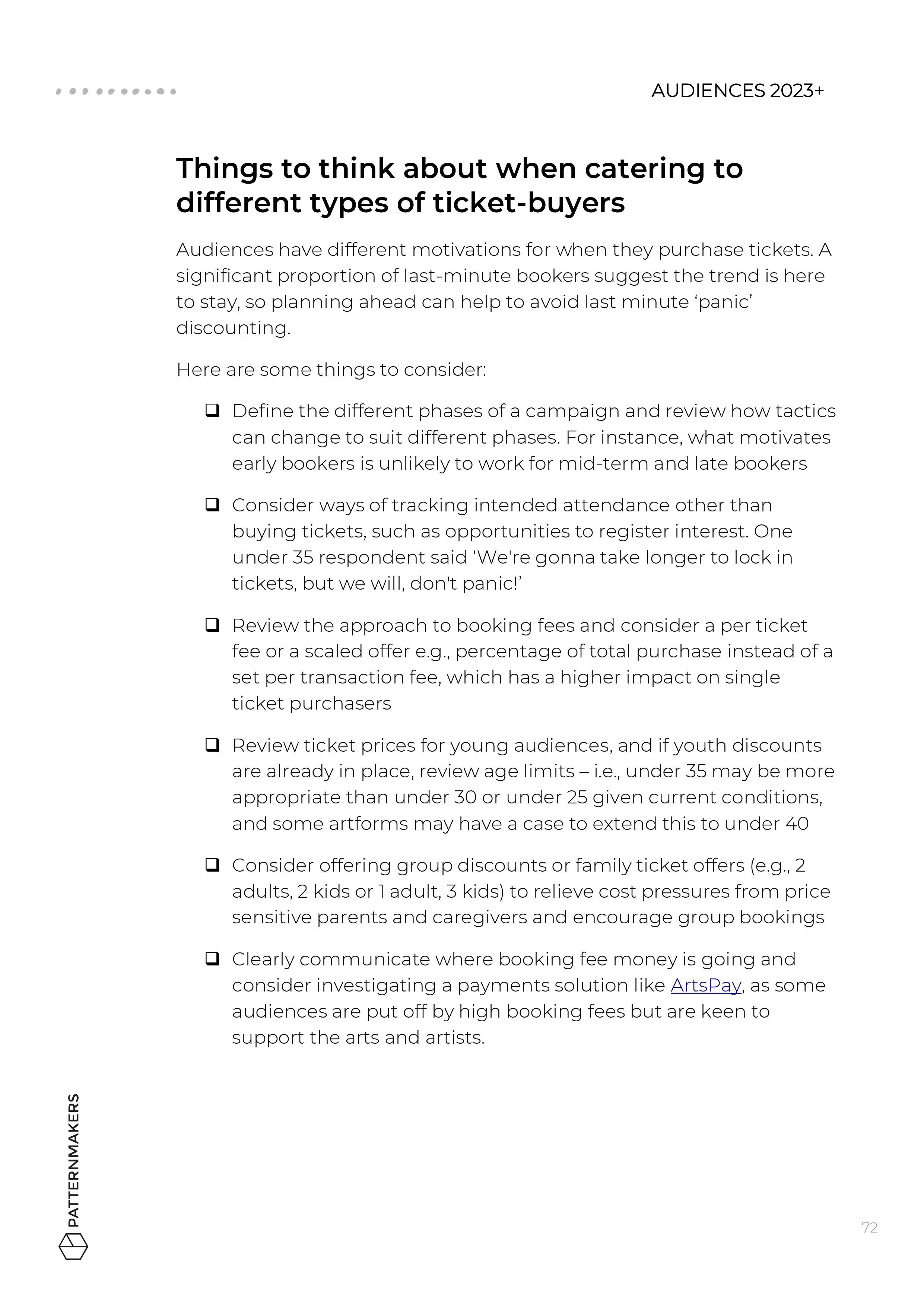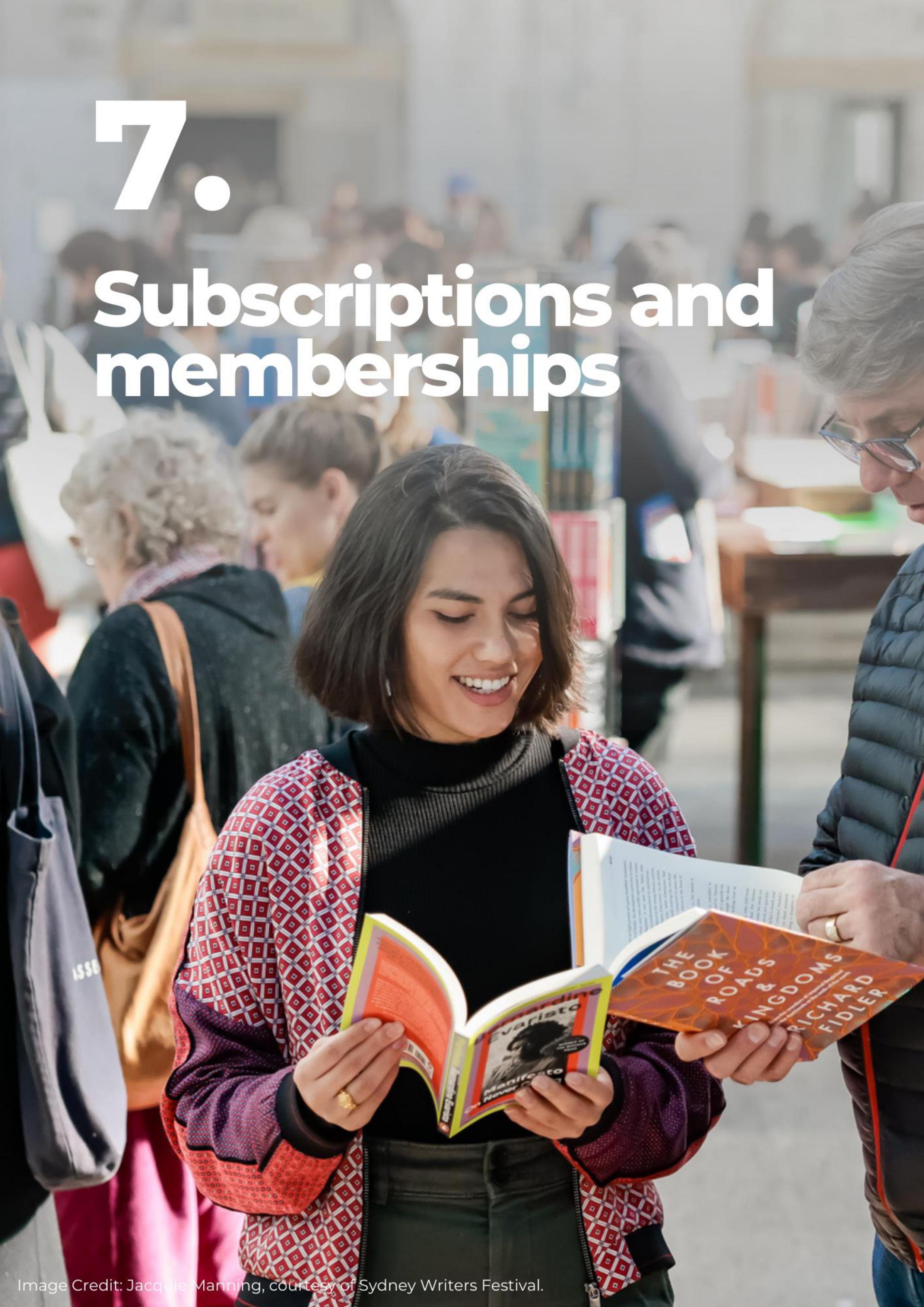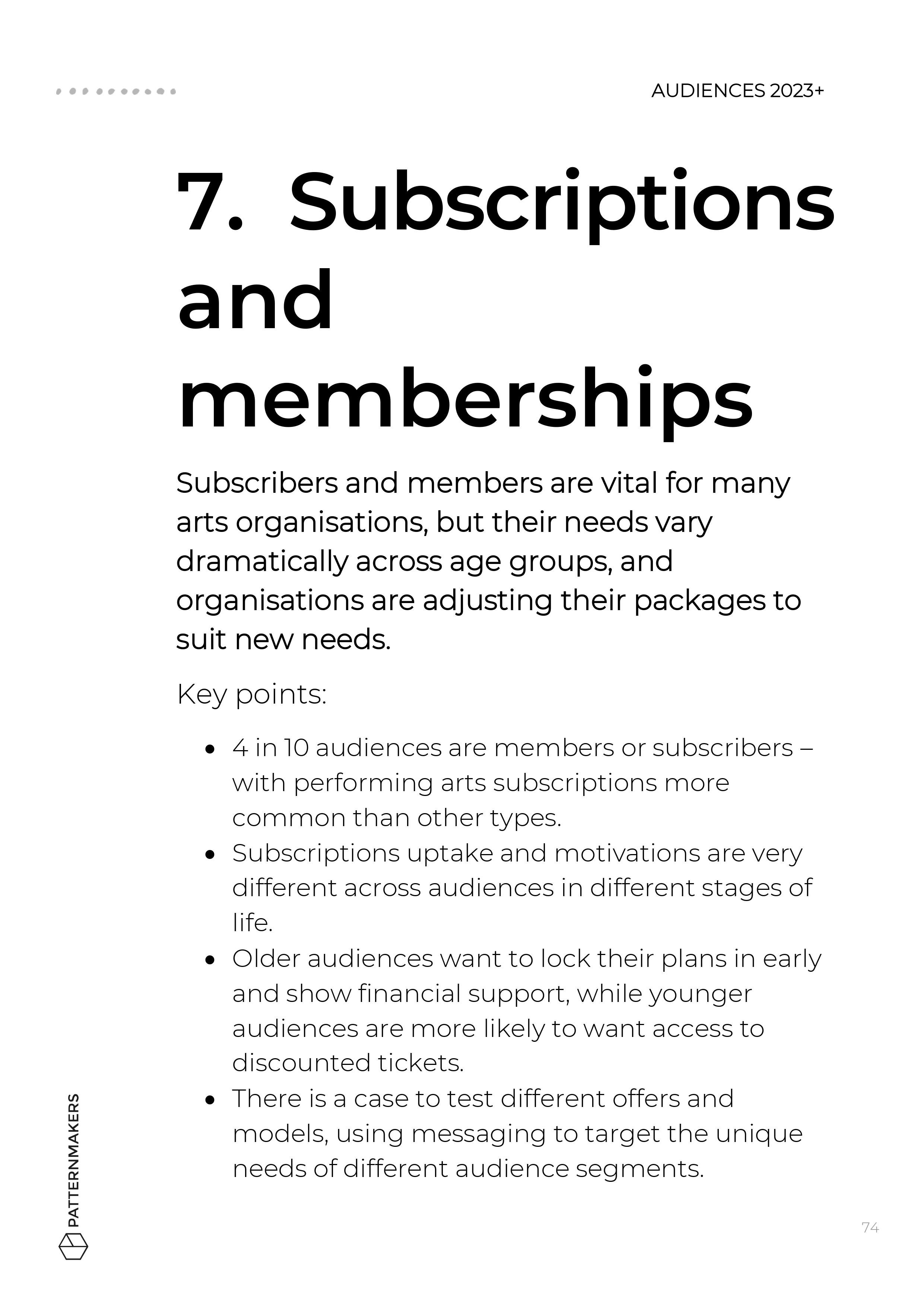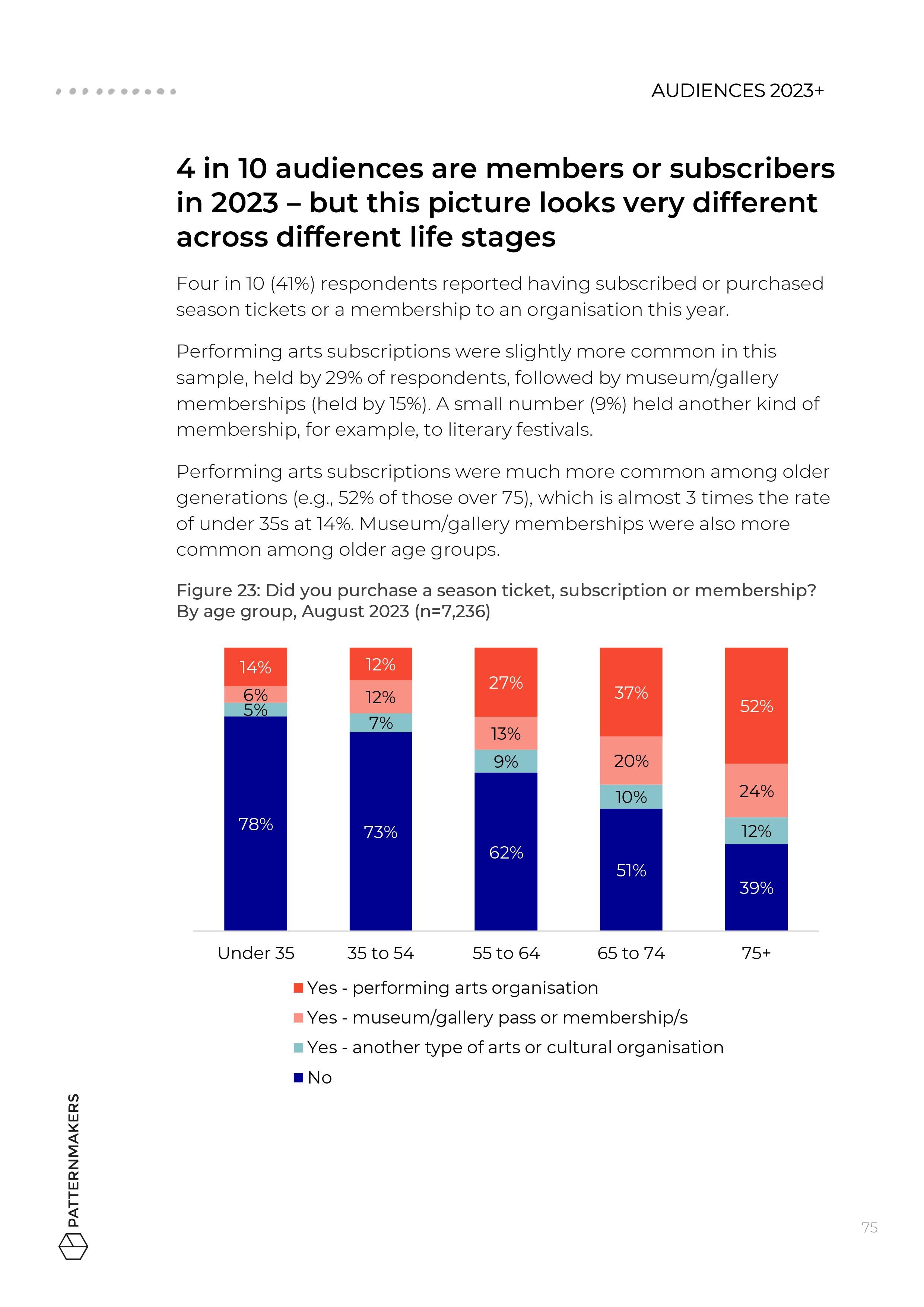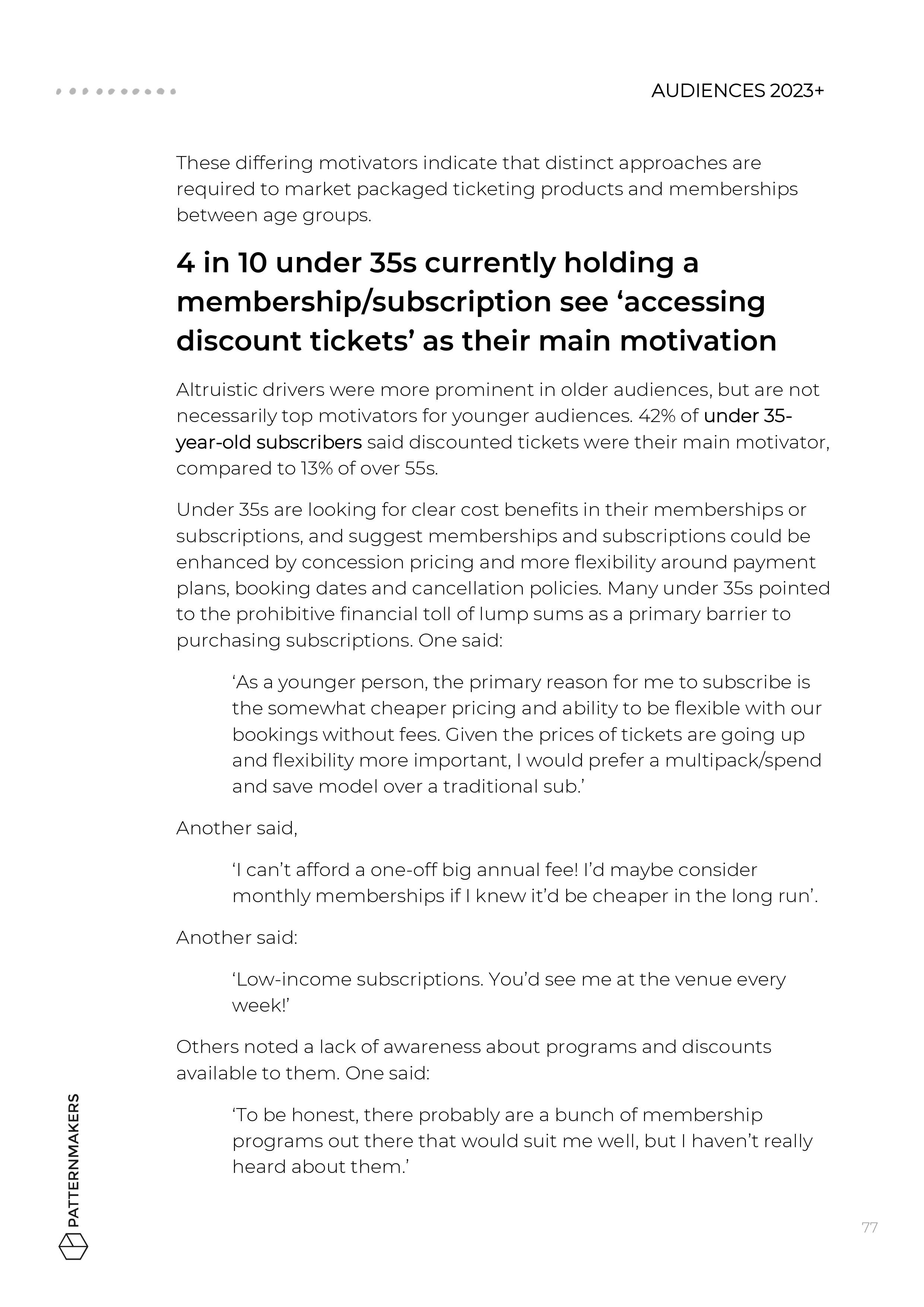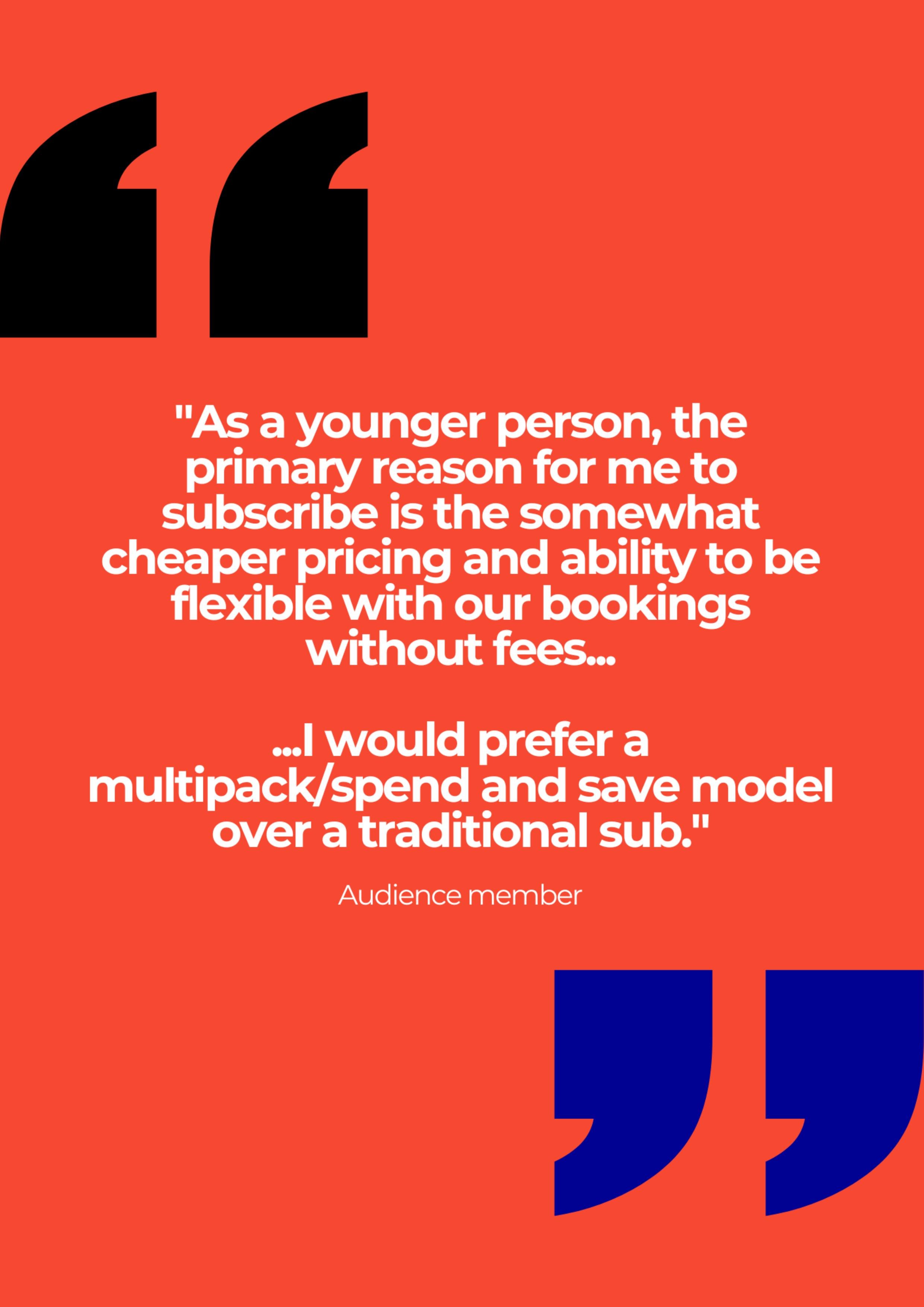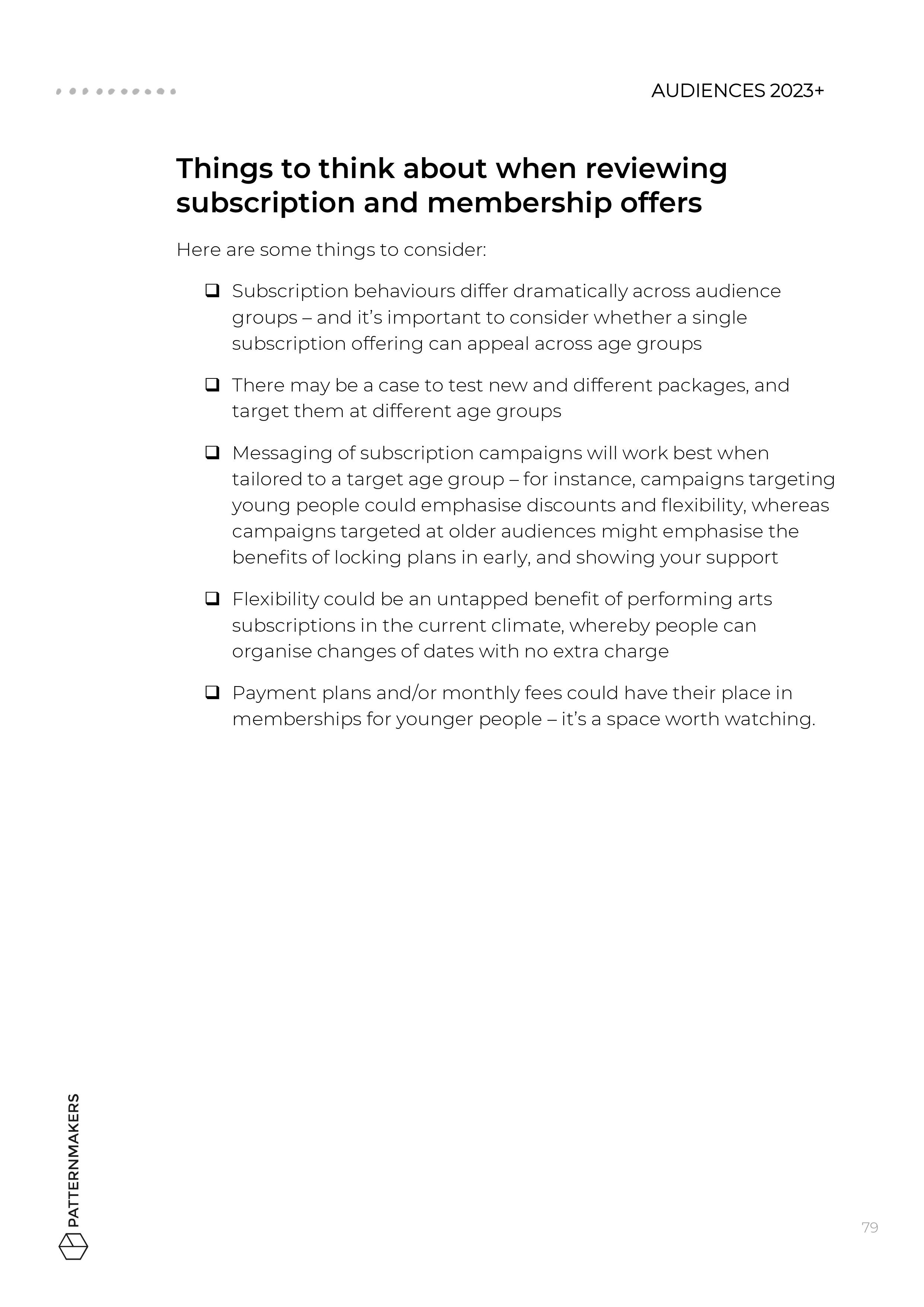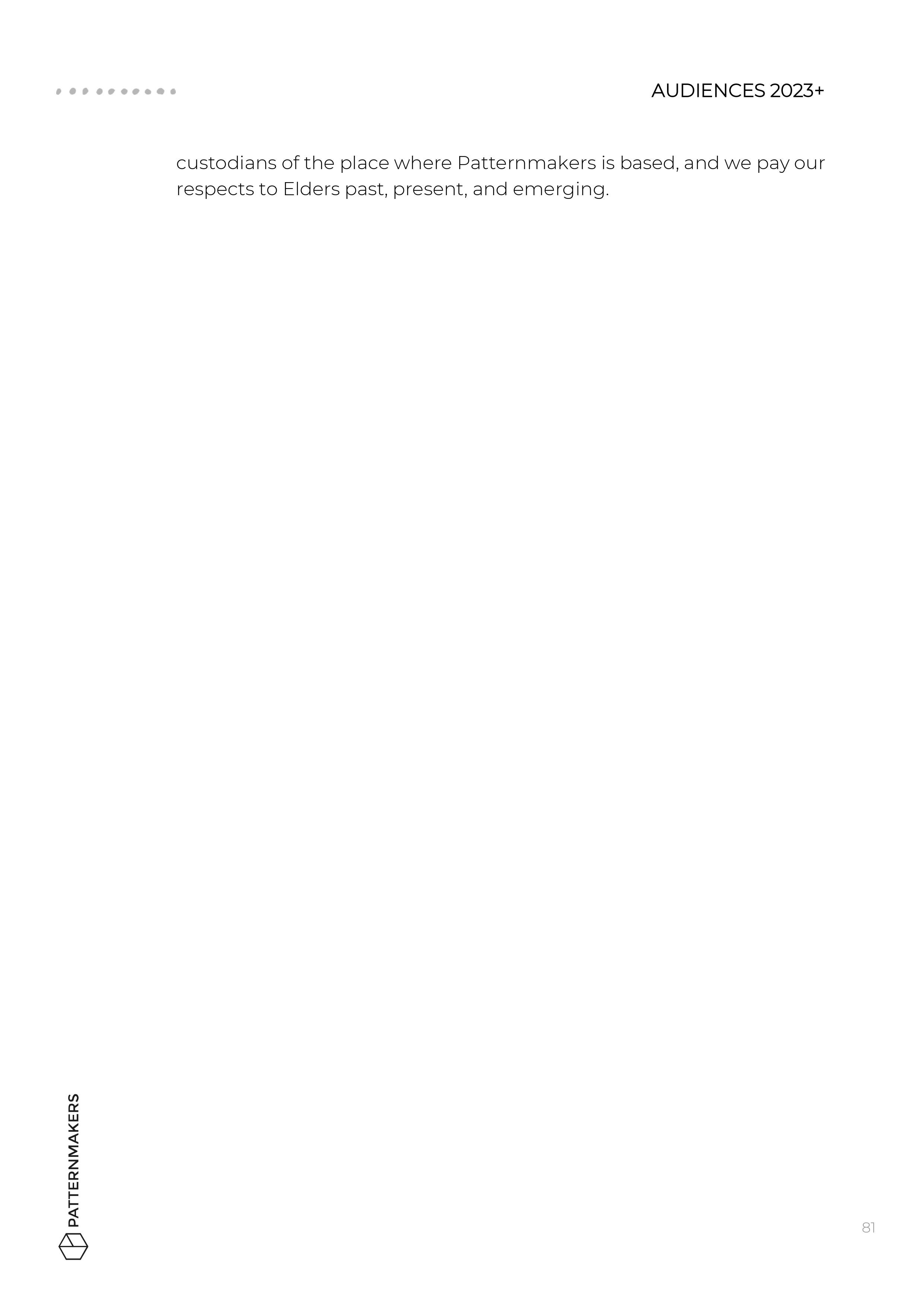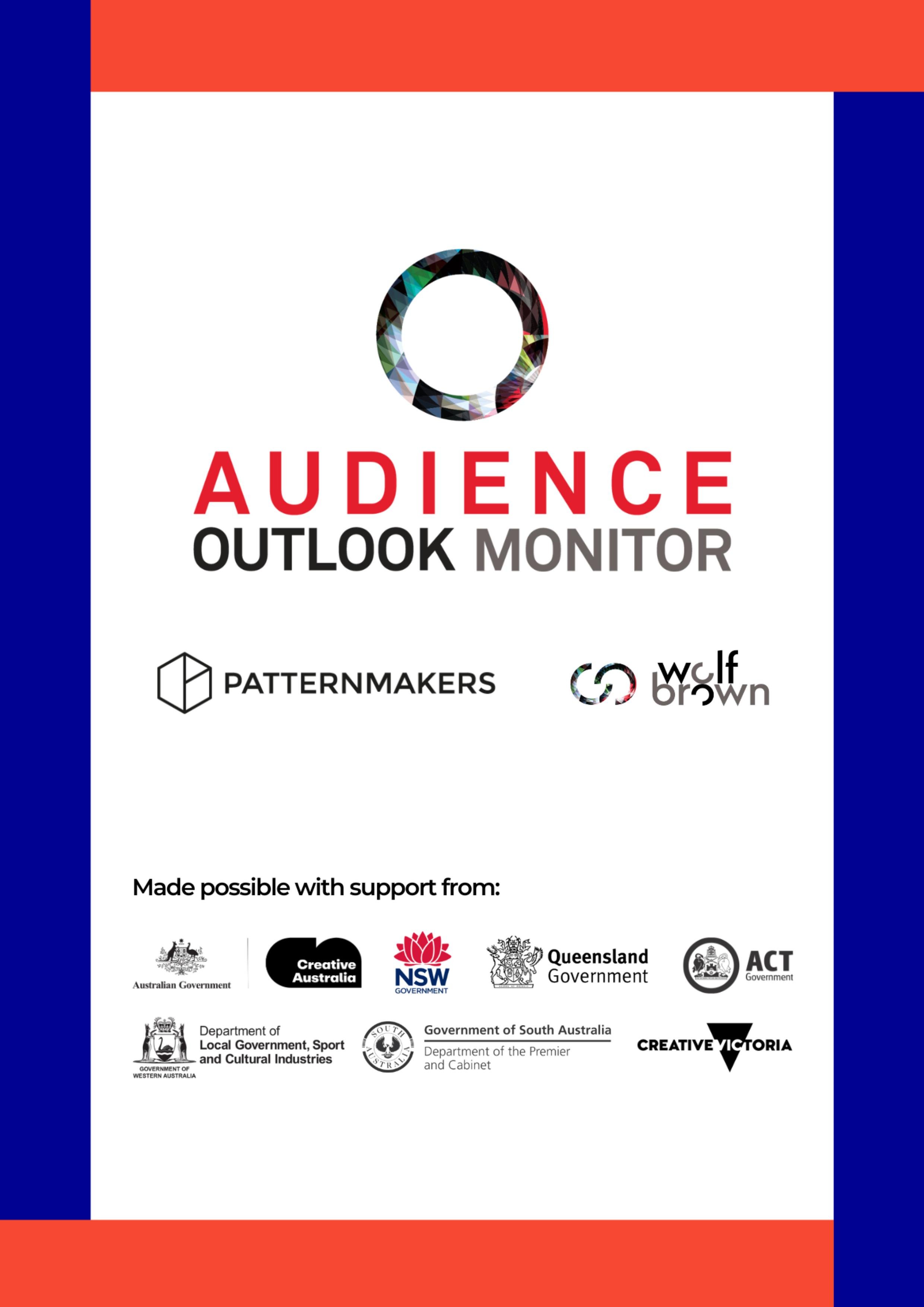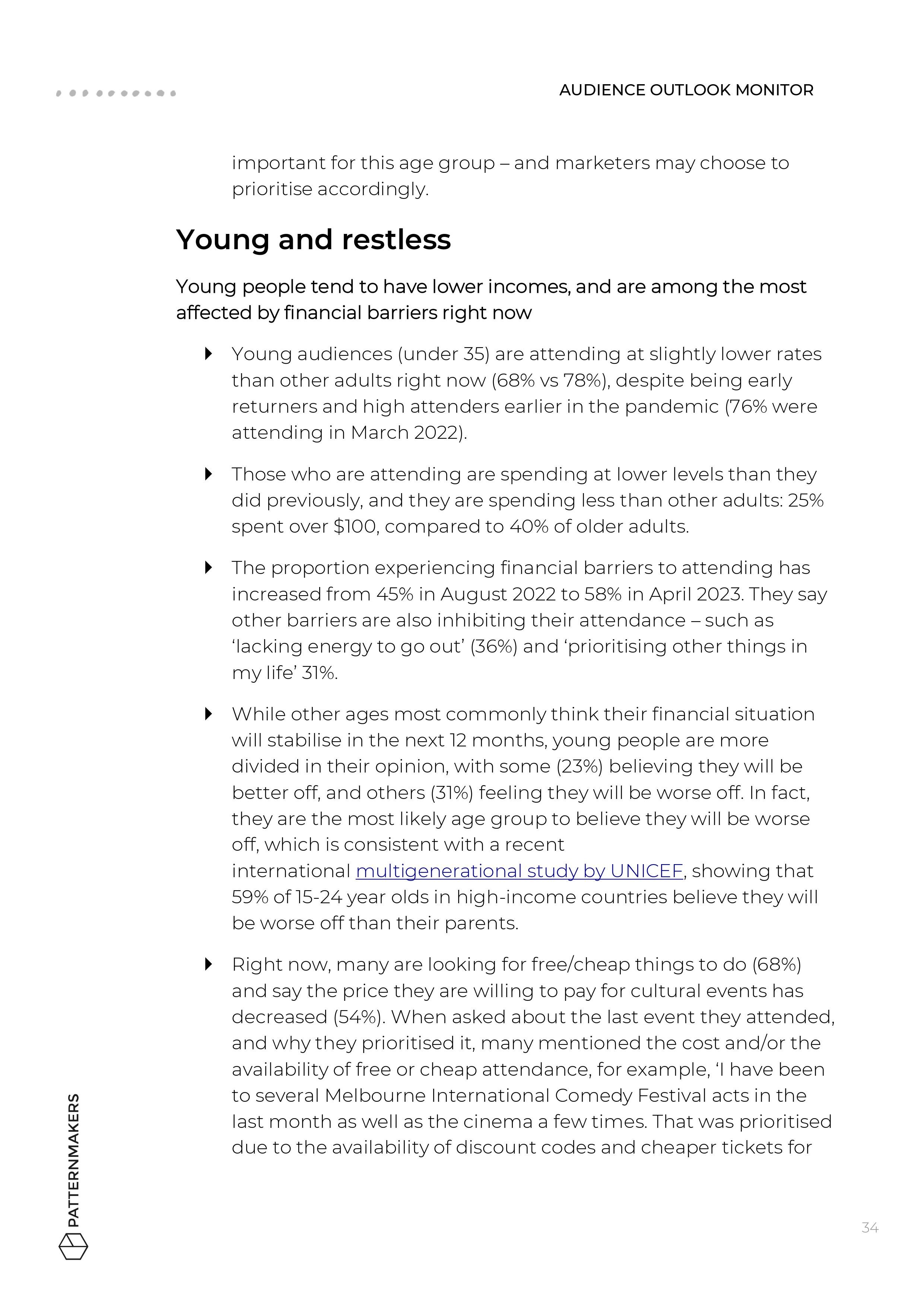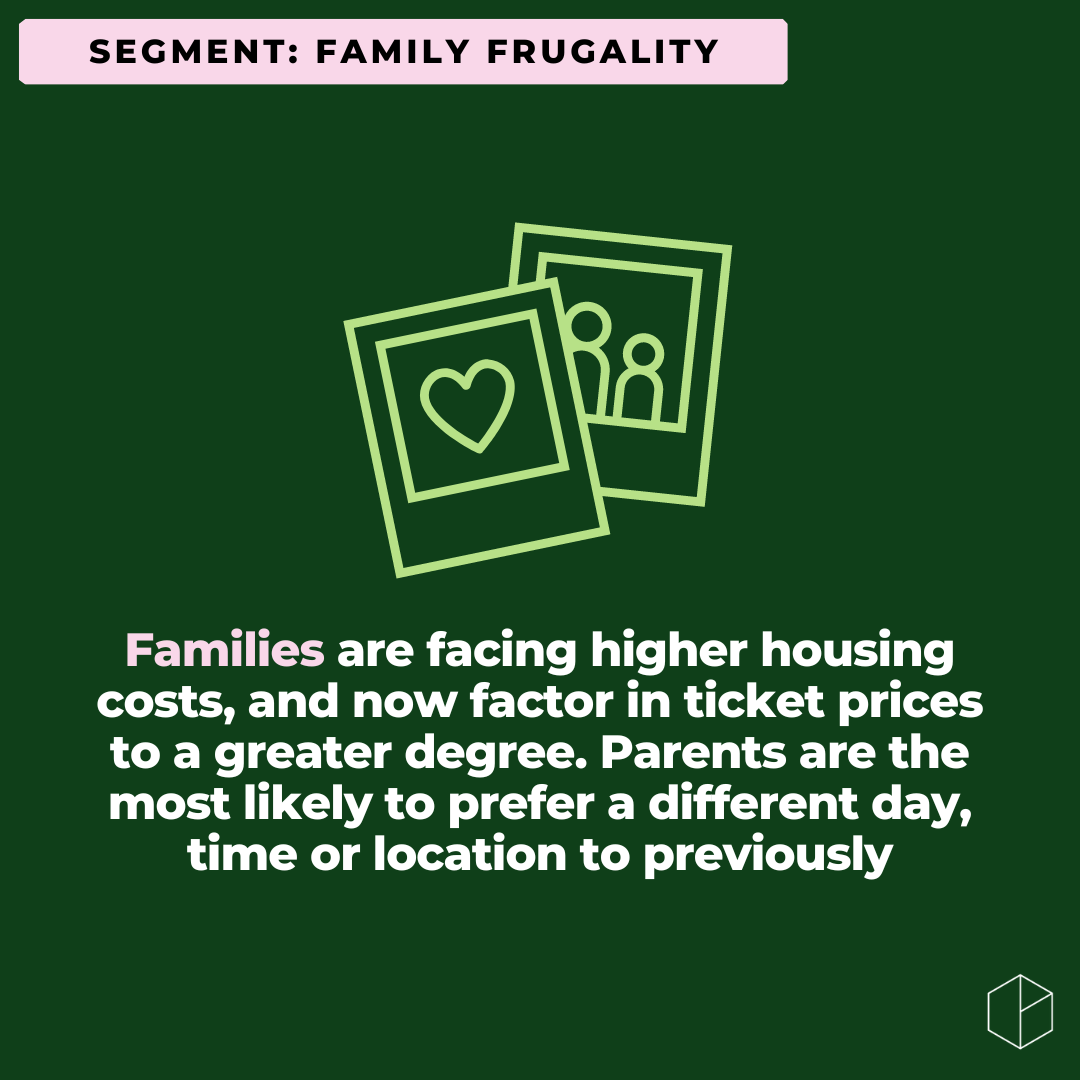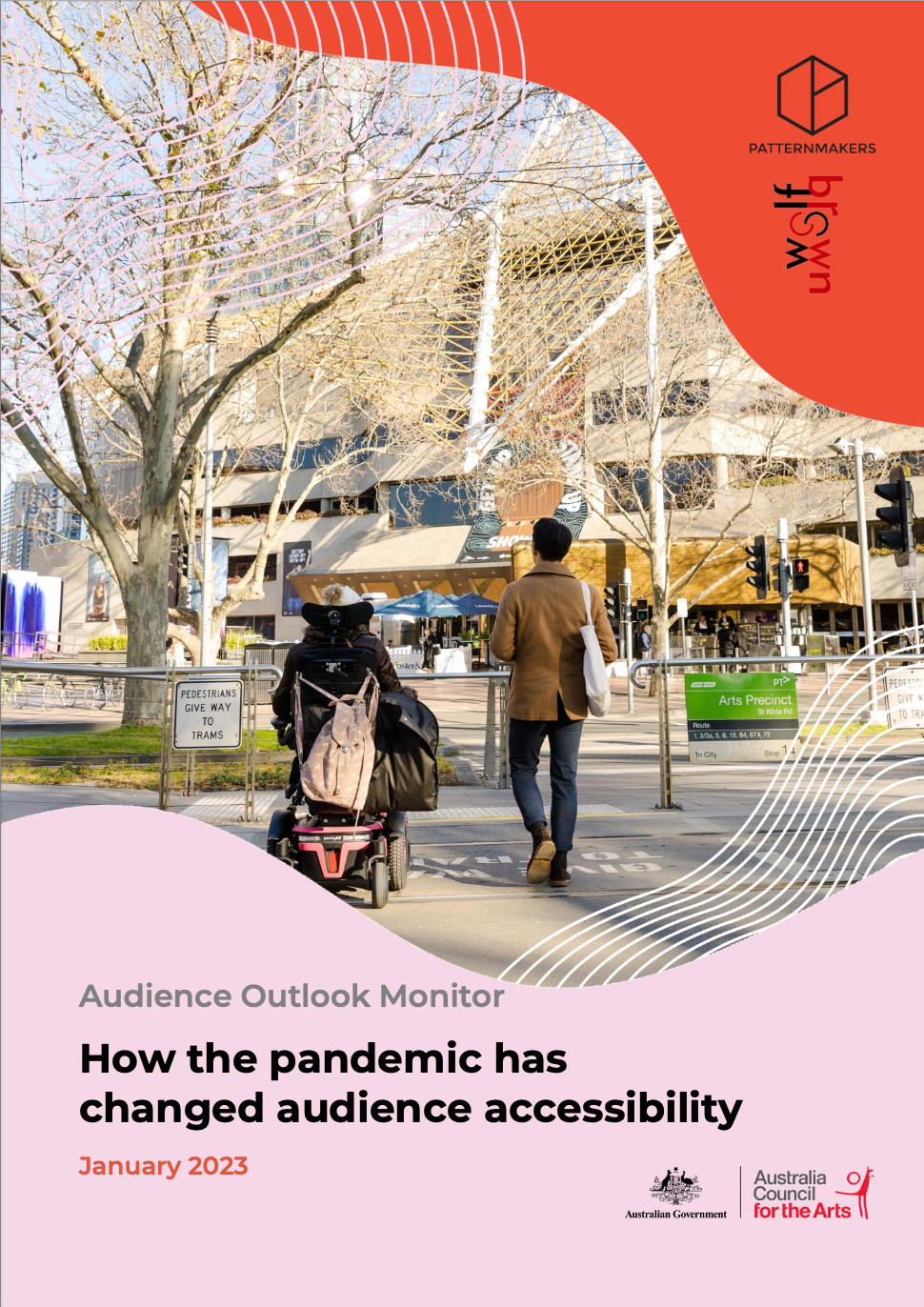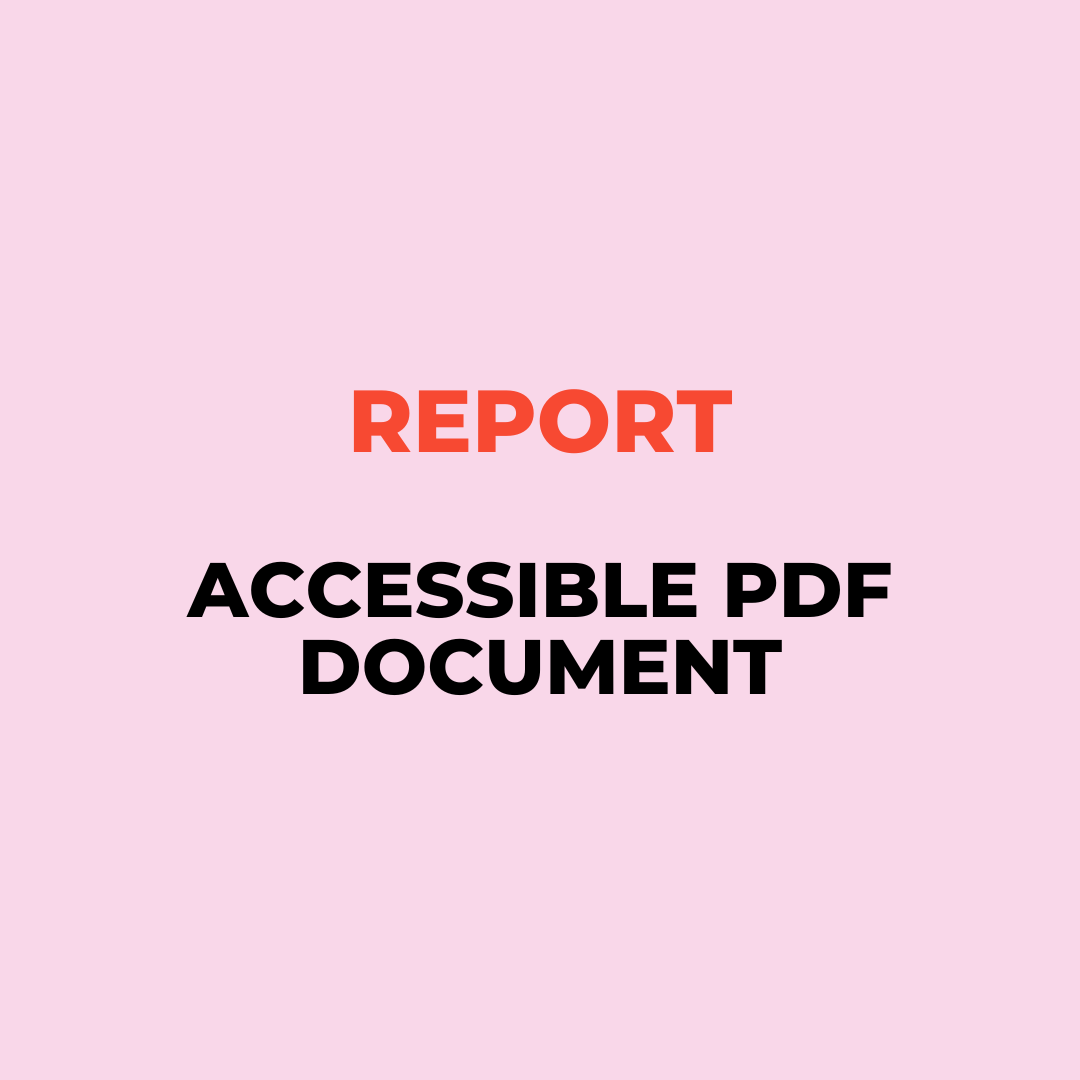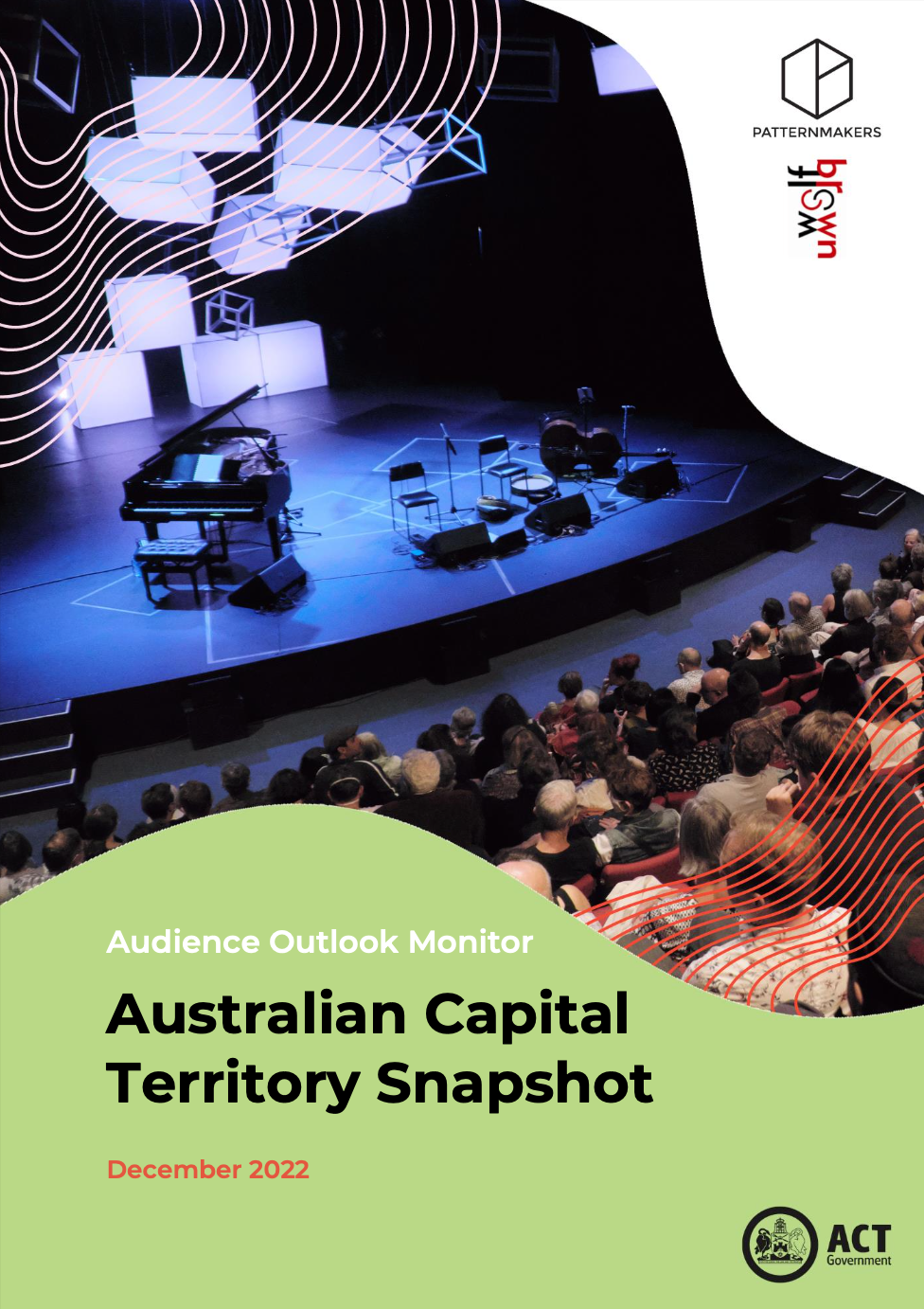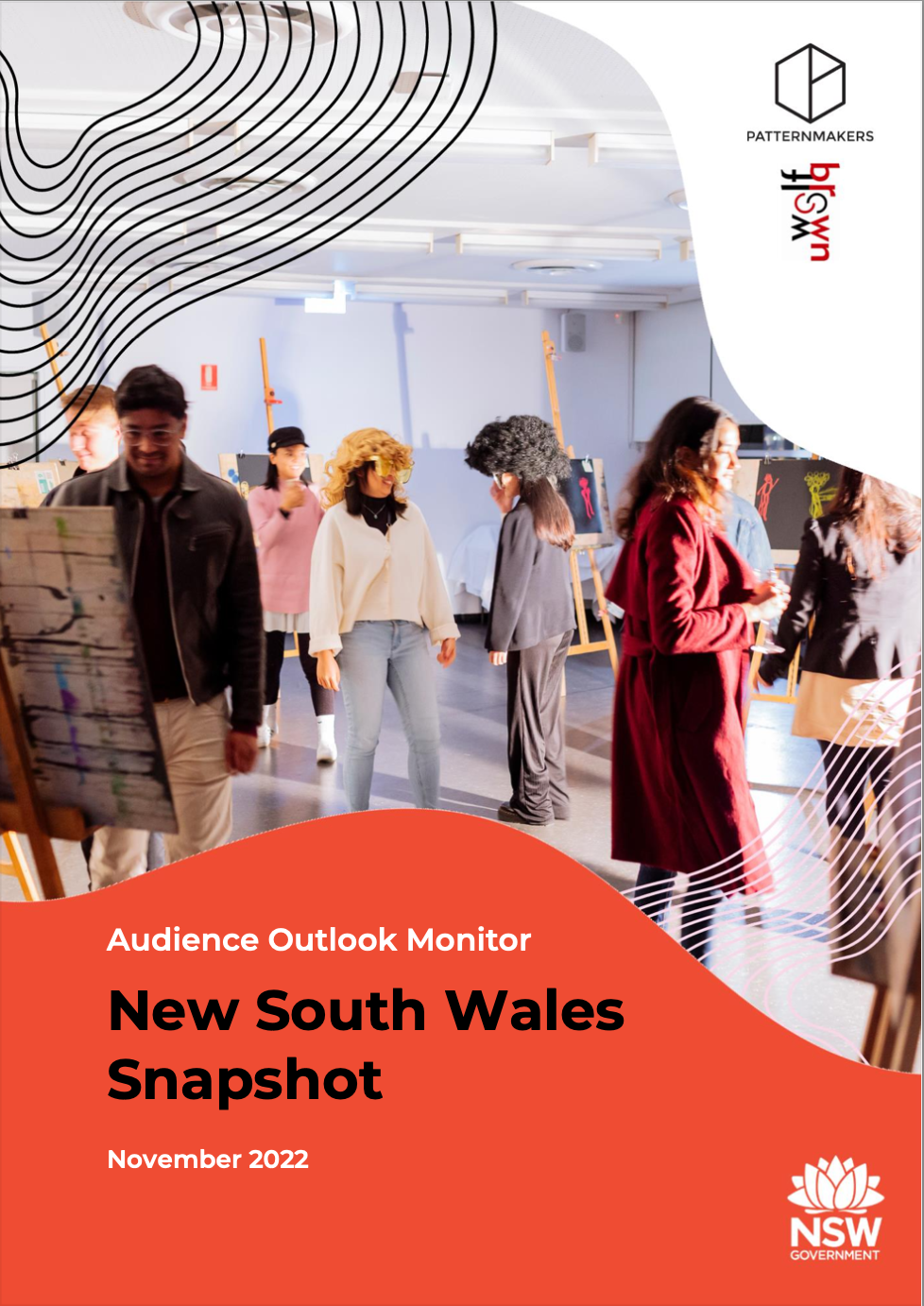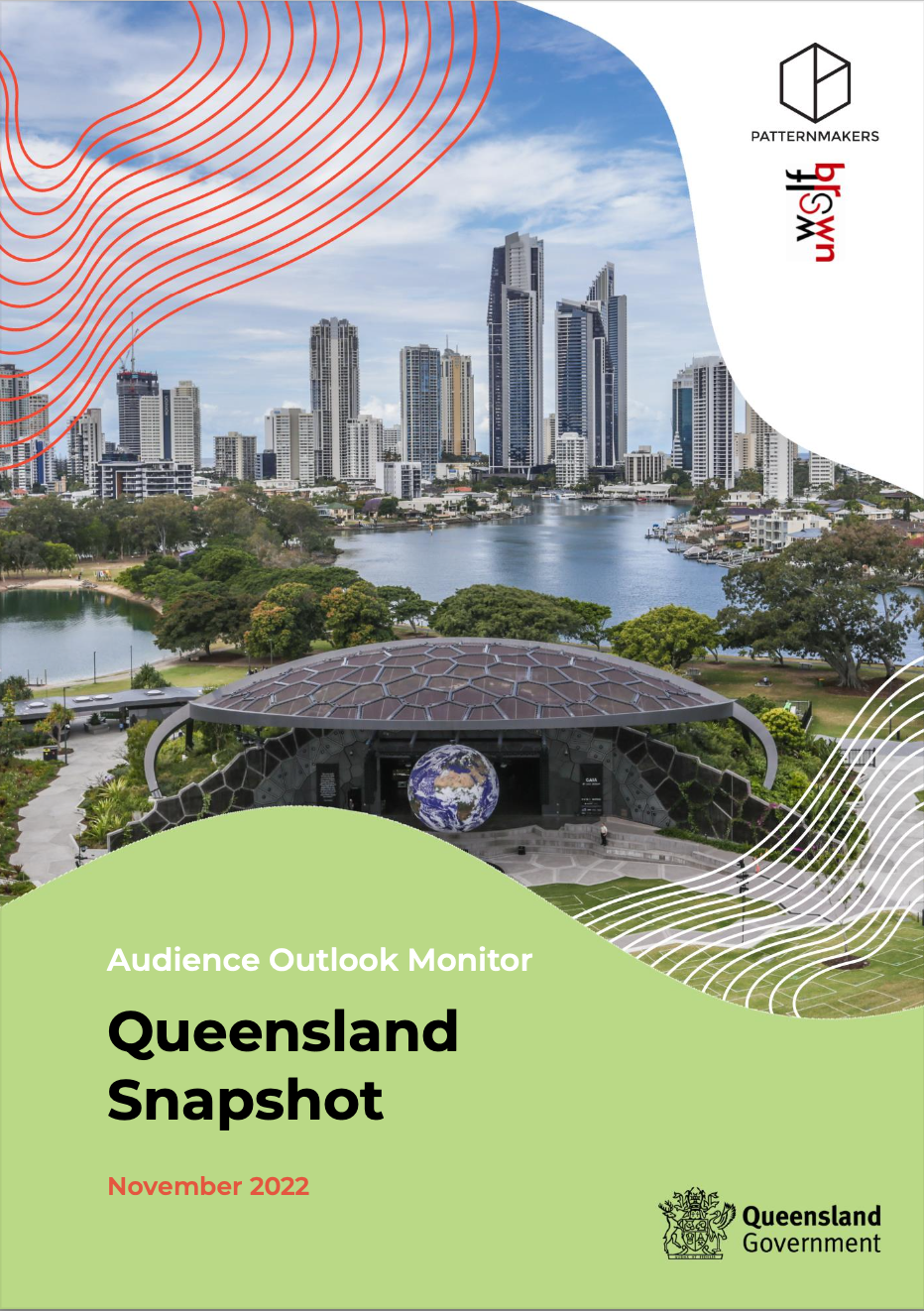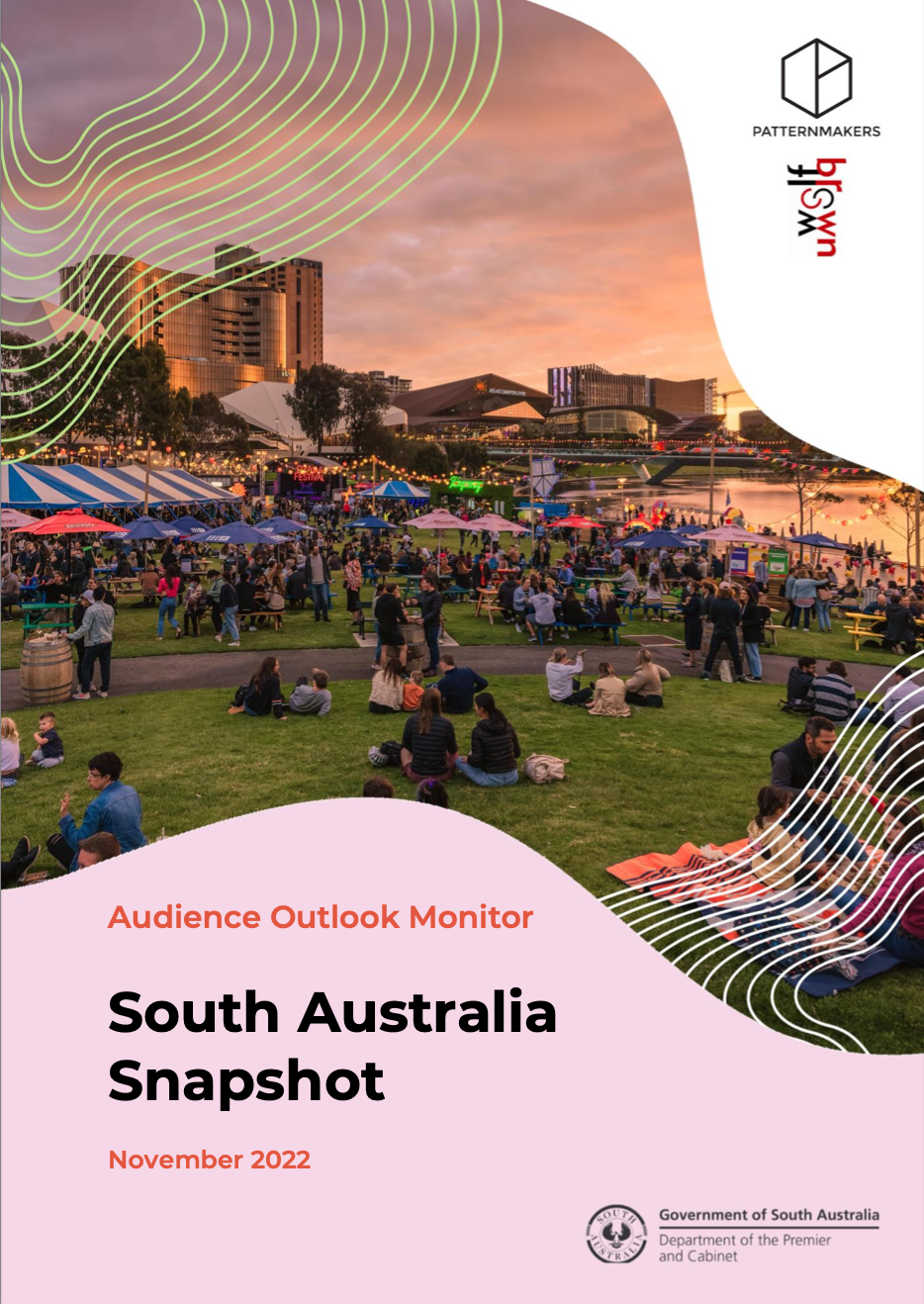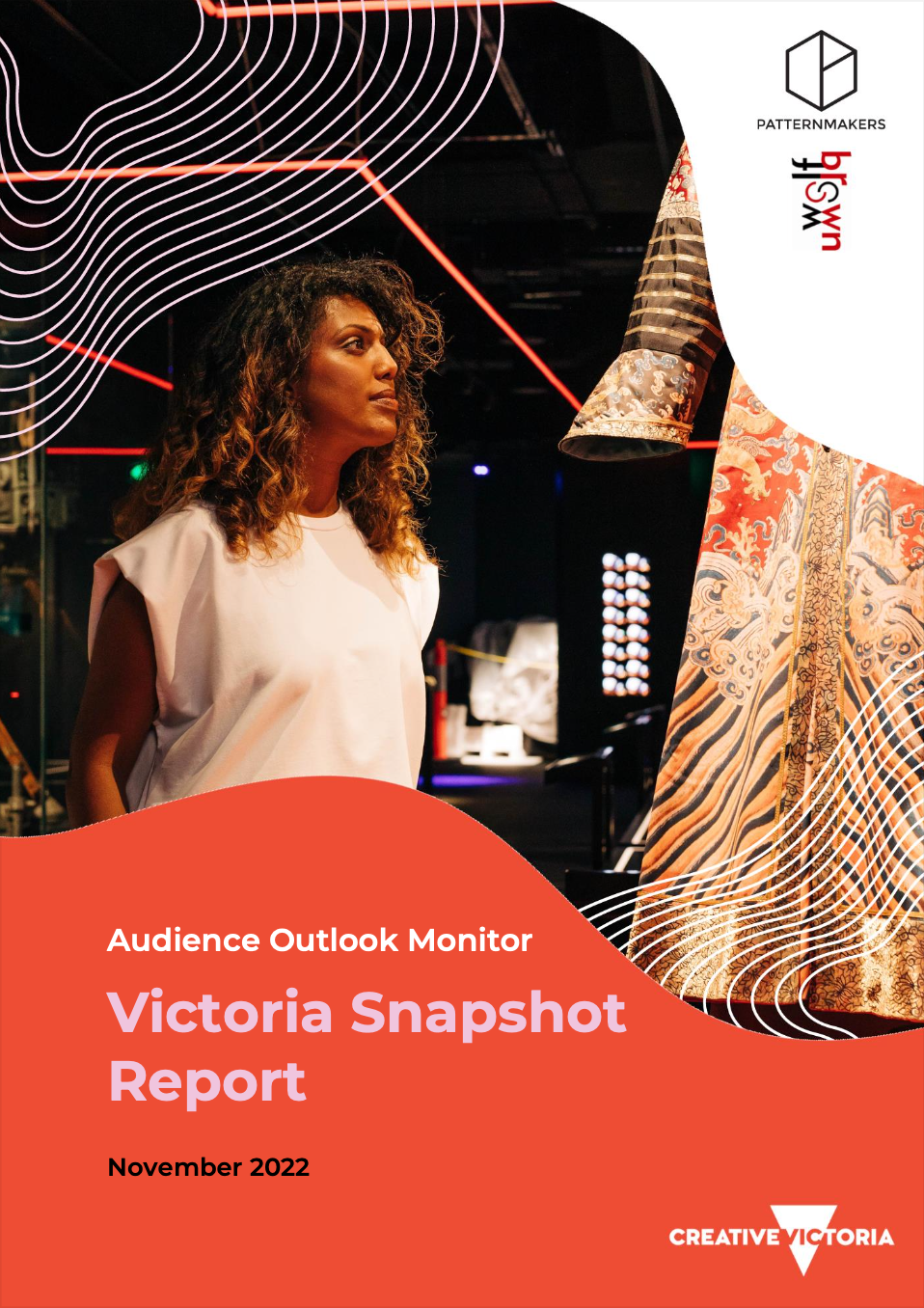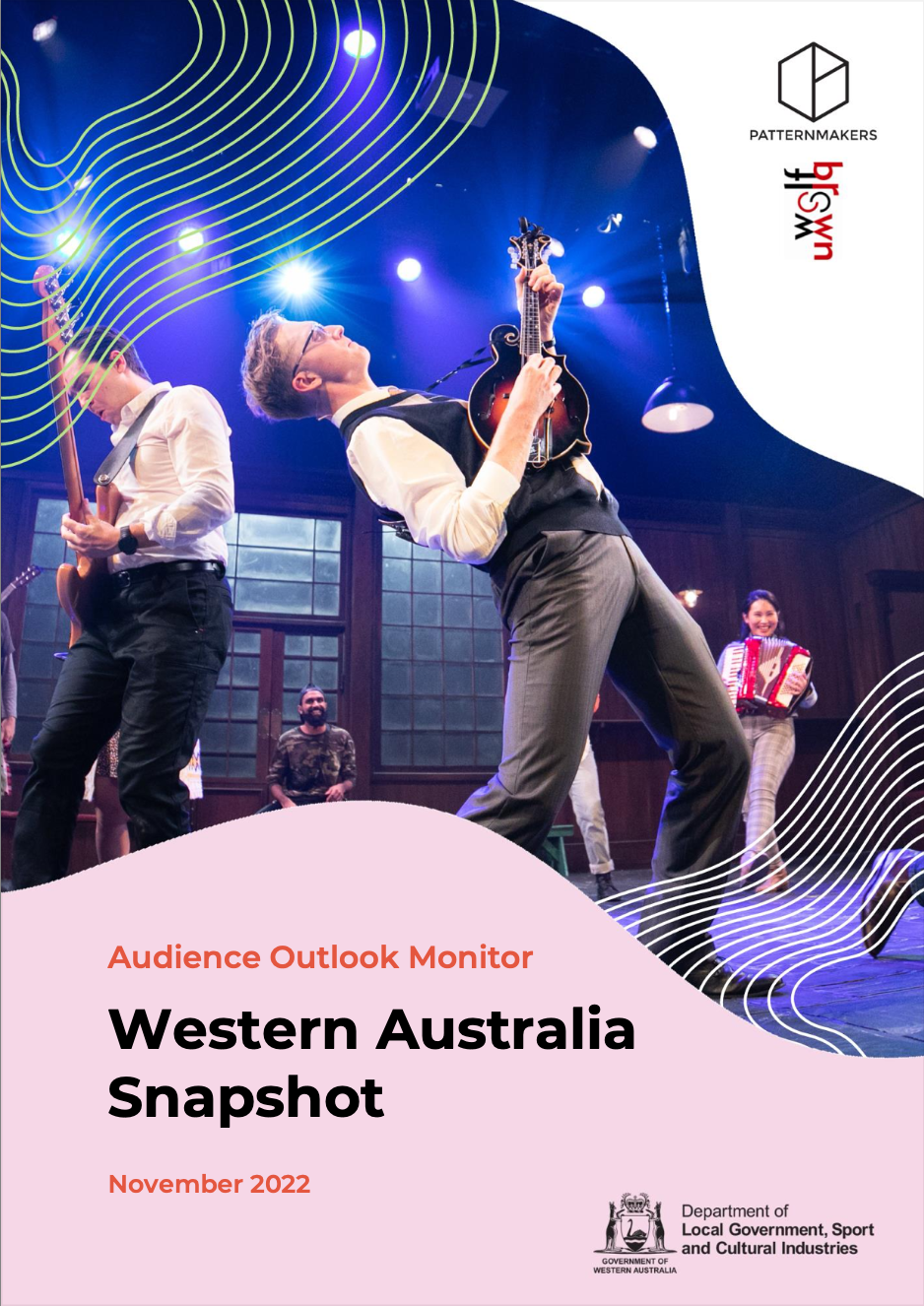From stadium gigs to screen-time: Looking back at the top audience moments of 2023
In this article, we cast our mind back to the sell-out stadiums, packed movie theatres, and record-breaking festivals of 2023, to bring you the biggest moments shared by Australian audiences.
We cast our mind back to the sell-out stadiums, packed movie theatres, and record-breaking festivals of 2023, to bring you the biggest moments shared by Australian audiences.
As 2023 was nearing its close, our team got chatting about the top audience moments of the year — and what we learned along the way.
It seems obvious but it’s actually pretty special: many of us have loved being in crowds again. After the awkwardness and isolation of the pandemic, 2023 was about having that collective experience: the feeling of being 100% in the moment alongside thousands of other people.
In this article, we take a look back at a year marked by sell-out stadium performances, shock cancellations, packed movie theatres, and record-breaking festivals.
The Matildas didn’t win the World Cup but, instead, changed women’s sport for good
The Matildas drew in record-breaking viewership for their incredible run at the Women’s World Cup - capturing the hearts of audiences around the globe but especially here at home.
Our team has some insight into the complex funding decisions behind major events (hint: they ain’t cheap), but this one set a new precedent for the enormous intangible value that results from hosting global events like the World Cup.
Cost-benefit ratios aside, the iconic semi-finals shootout cemented Sam Kerr’s legendary status, and the Matildas keen following saw the team become Australia’s most valuable brand in sports. The start of a new chapter, not just for women in sport, but for Australian society, period.
Barbenheimer brought us back to the cinema, on the double!
Perhaps the biggest comeback in 2023 saw audiences returning to the big screen in swathes, driven by Barbie and Oppenheimer’s competing release dates (as well as an unprecedented marketing effort and press tour by Warner Bros.).
Like other kinds of cultural events, cinema attendances took a big hit during the pandemic, but things began looking a lot rosier as these two films approached our shores.
Fuelled by the viral ‘Barbenheimer’ meme, a new phenomenon emerged, leading audiences across the globe to purchase tickets to both films as a double feature. This unlikely combo showed that, when done right, audiences are up for both uplifting and challenging stories.
We loved seeing people dressing up again for a new release (who doesn’t love an excuse to wear head-to-toe pink?) and sharing their experience on socials. It was also interesting to see movie-goers purchasing tickets pre-release. Some research showed that 43% of Barbie audiences were infrequent moviegoers, meaning they hadn’t been to the movies in the last 6 months.
Blockbuster stadium tours showed us how to make friends with strangers
After a patchy 2022, demand for concert tickets was back in full force, with international acts taking centre stage (and emptying wallets everywhere).
There are signs this hasn’t been good news for everyone – with indie gigs hurting at box offices across the country – and continuing the tough times for many small and medium companies.
Most newsworthy was the internet-breaking presales for Taylor Swift’s 2024 ERAS Tour (some of our team were lucky to snap up tickets).
Beyoncé’s Renaissance World Tour was her highest-grossing tour yet, and Swift’s revenue surpassed the billion-dollar mark.
Putting the market distortion aside, we’ve been amazed by the stadium experiences these acts are putting on for the crowds – and how adorable is the friendship bracelet trend? Swifties are bringing new levels of sweet to concerts, and heralding in a new era of connection through shared experiences.
Disability activism inspired new levels of access at events
It’s been a long time coming but in 2023, it was great to see some incredible examples of accessibility at events.
We’ve watched as events outdid each other with new access and inclusion initiatives, welcoming broader audiences than ever before.
Our friend Morwenna Collett reported back from Ability Fest: ‘There were Auslan interpreters on both stages all day (including the incredible Mikey Webb), captioning on the Main Stage, Bindi Maps for site navigation, a nicely kitted out sensory room, a chill out space, two accessible viewing platforms, ample first aid, a well-being tent, a service animal toileting area, accessible buggies to move people between the two stage areas, loads of helpful volunteers, a fab access liaison contact officer with lived experience, good signage, loads of track matting, shaded areas, strobe warnings, an awesome disabled photographer documenting the event and of course multiple disabled musicians on the bill.’ Wow.
We’re seeing more and more great initiatives popping up, like Auslan Santa at Westfield – and amazing acts by disabled artists at festivals around the country.
In January, our team launched a new research report – showing that its not just disabled and immunocompromised audiences who benefit from these changes, but the friends, families, support workers and groups that accompany them, so hear hear!
A big thank you to all the tireless advocates who have championed change for a long time.
Festivals brought the fun (and crowds) back into cities
We’re still talking about Adelaide Fringe’s huge achievement in selling 1 million tickets for their 2023 festival and topping their pre-COVID ticket sales from 2019. In possibly the biggest ticketing comeback of 2023, Adelaide Fringe was able to swing a miracle through strategic coordination across updated databases, a healthy mix of free and cheap offerings, an optimised box office experience and a sponsor-backed ticket flash sale.
Sydney WorldPride 2023 drew over 1 million audience members to the festival (double what was expected), with around 70,000 people coming to NSW especially to attend. It was the first time WorldPride, the largest LGBTQIA+ festival in the world, was hosted in the Southern Hemisphere. This history-making event was the biggest in Sydney since the 2000 Olympics!
It’s not all roses in festival world, with Dark Mofo breaking news as they announced a fallow year in 2024. They say absence makes the heart grow fonder so we’ll be watching with interest to see what audiences do when it returns to Hobart in 2025.
Major institutions turned up the volume on free events
In August, our major report Audiences 2023+ showed that cost is now the top barrier limiting people’s attendance at cultural events. Luckily, the arts sector is responding with an amazing array of free events.
The beloved Sydney Opera House celebrated it’s 50th birthday in 2023, and hosted a month-long Birthday Festival in October where audiences were treated to a broad range of ticketed and free events from theatre to contemporary music and lectures. They produced ‘Play It Safe’, a 50th Anniversary film showcasing dance, music and theatre, and shared 50 iconic Sydney Opera House film recordings for free over 3 months to celebrate 5 iconic decades.
The history-making Melbourne Now returned for the first time since 2013 at The Ian Potter Centre: NGV Australia. The exhibition took over NGV’s Fed Square gallery and included more than 200 Victorian practitioners across disciplines. The exhibition and programming saw audience attendance records break, with success factors from the unique mix of local creatives on show as well as the breadth of public programming – all enjoyed for free!
Thank you to all of the amazing artists, event organisers and cultural venues that worked so hard to make 2023 such a special year for audiences.
May the good times roll in 2024!
Categories
Archive
- 2023 21
- Dance 3
- Research 99
- Audience development 79
- Arts 73
- COVID-19 70
- Culture 72
- Data culture 69
- Evaluation 75
- Innovation 78
- Thought leadership 16
- About Patternmakers 35
- Privacy 6
- Project updates 25
- Culture Panel 1
- Resources 6
- Toolkit 5
- Beyond the Bio 8
- 2022 23
- Career Advice 9
- Opportunities 4
- Tips & Tricks 13
- 2021 7
- 2024 1
- First Nations 3
- Indigenous 2
- Strategic Planning 5
- Trends 3
- Performing Arts 5
- Manifesto 1
- Education 2
- Capacity building 3
- Digital art 4
- Interviews 3
- Coronavirus 2
- 2020 3
- Tandi Palmer Williams 7
- Theory of Creativity Podcast 1
- 2019 11
- Top 5 2
- 2018 12
- Case Studies 2
- Our services 4
- Postcode Analysis 1
- Accessibility 4
- Touring 3
- Publications 1
- 2017 8
- Data art 2
- 2016 5
Be in the loop
City lights to red dirt: Connecting with audiences across Australia
In this Audience Outlook Monitor report, ‘City Lights to Red Dirt’, we look at the geographic trends in data collected from past attendees to cultural events, comparing audiences in big cities, outer suburbs and the regions.
Our cities, suburbs and regions are different places today and audiences are responding in interesting ways.
Attendees of arts and cultural events are feeling the pressure of the housing crisis, changing work and commuting patterns, navigating weather events and approaching travel and leisure differently.
In this new report, ‘City Lights to Red Dirt’, we look at the geographic trends in data collected from past audiences of cultural events.






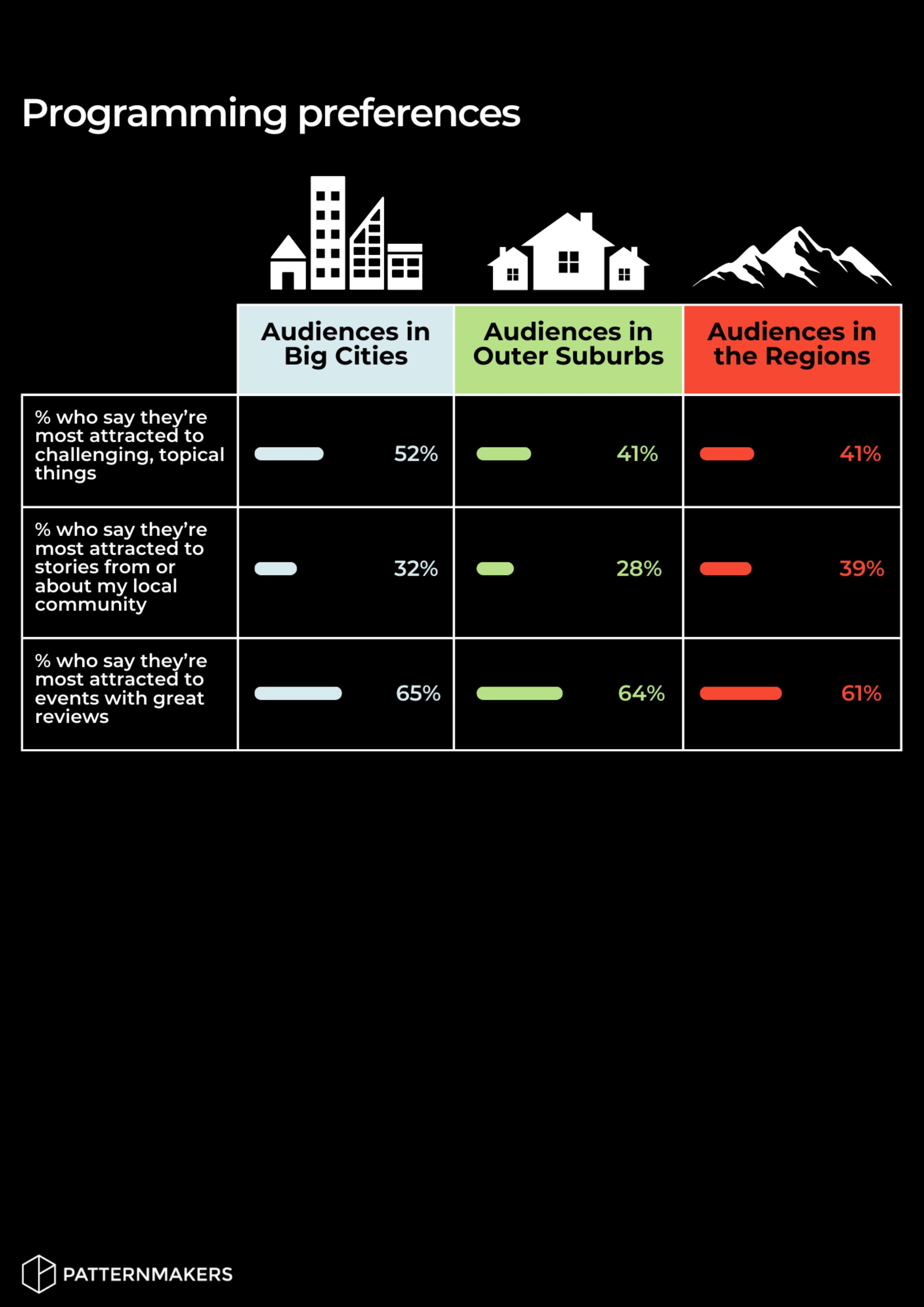
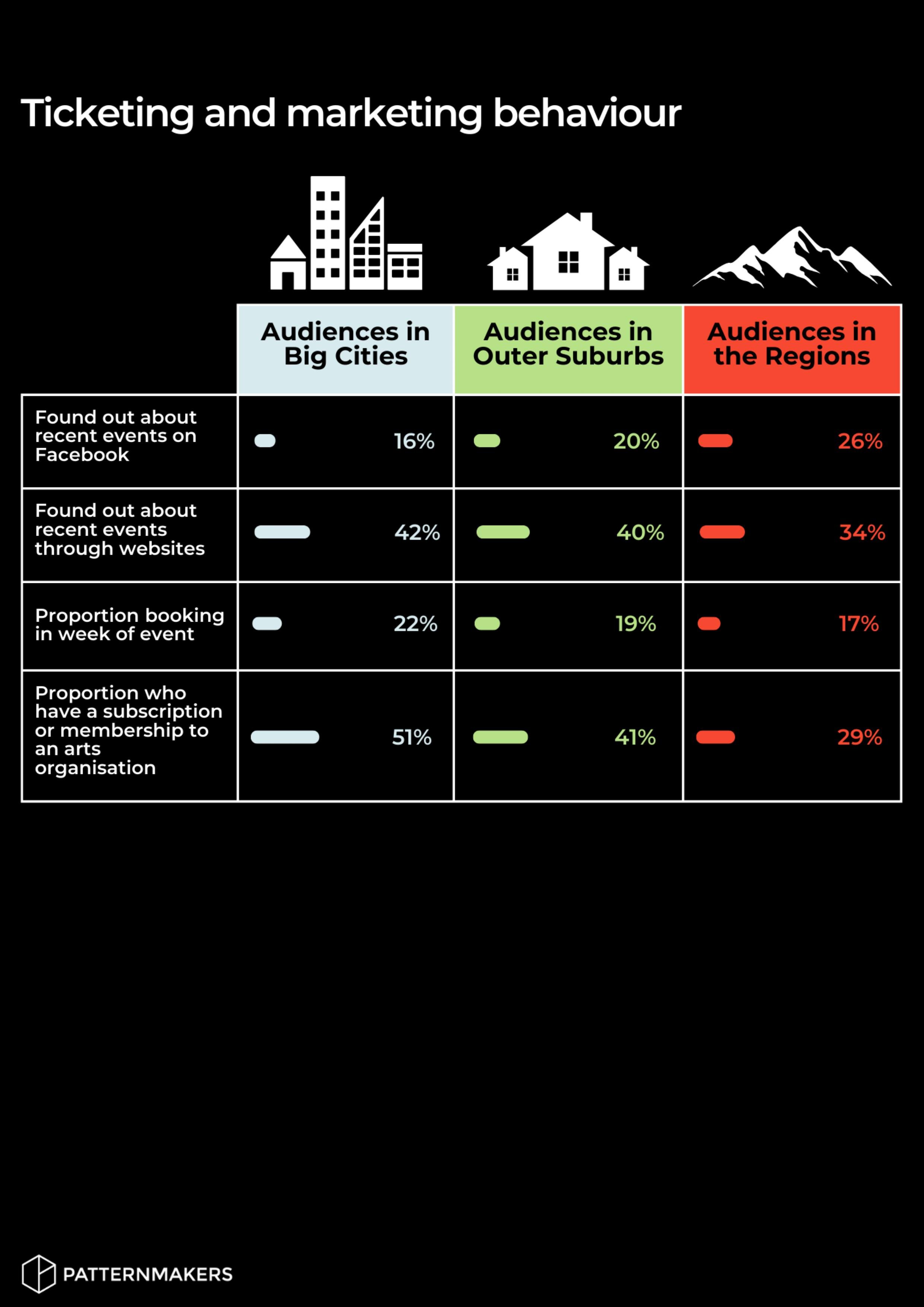
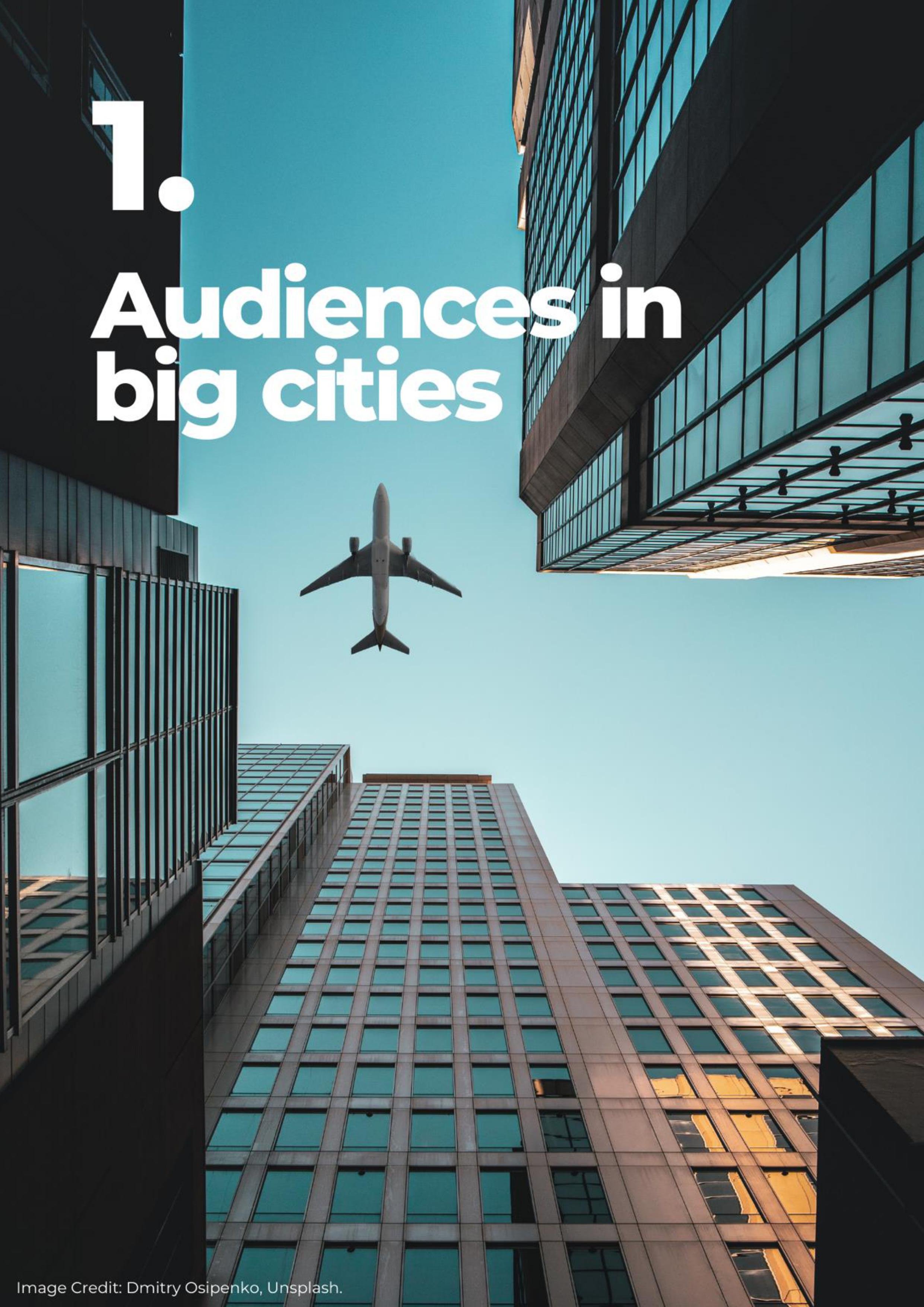


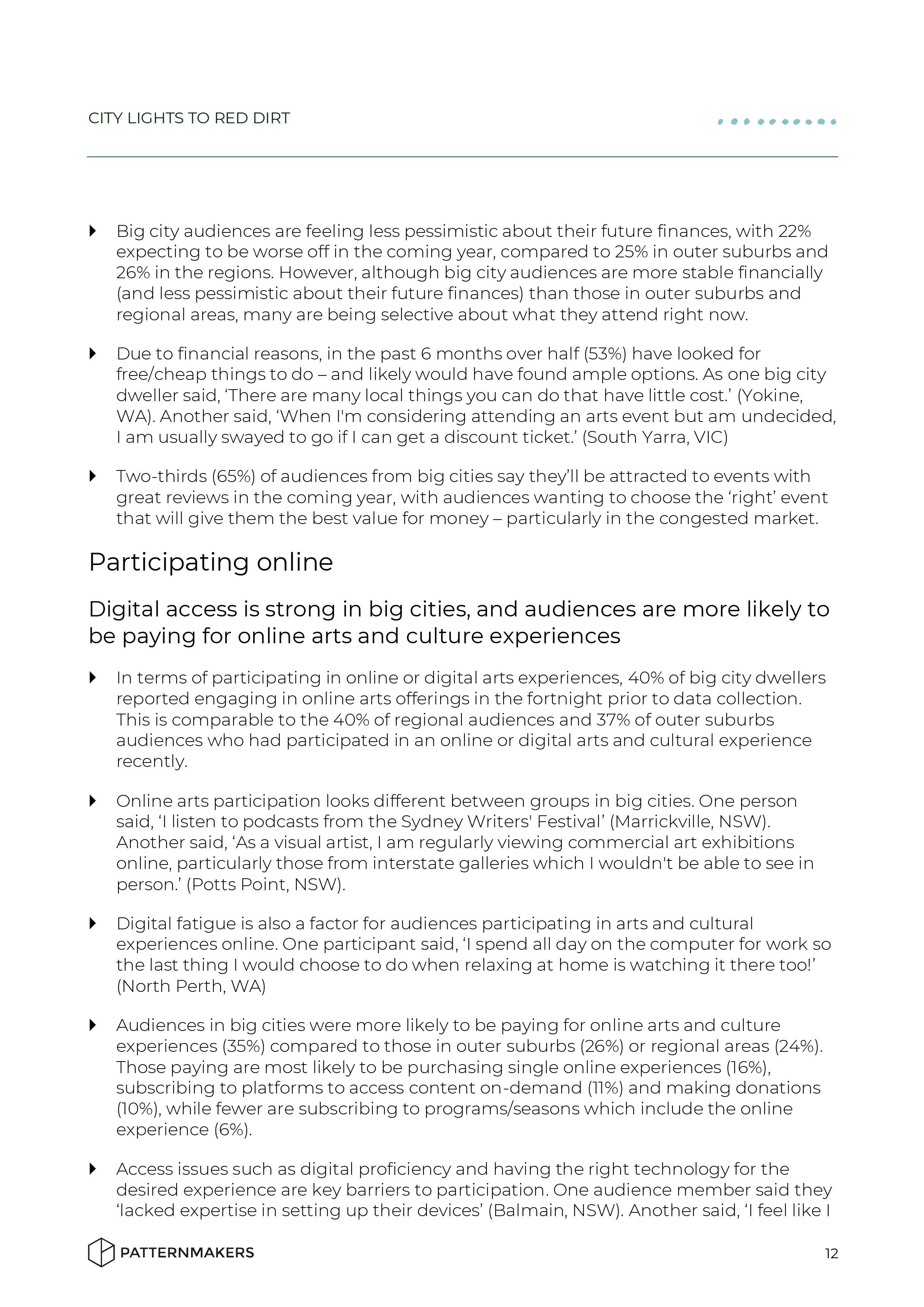
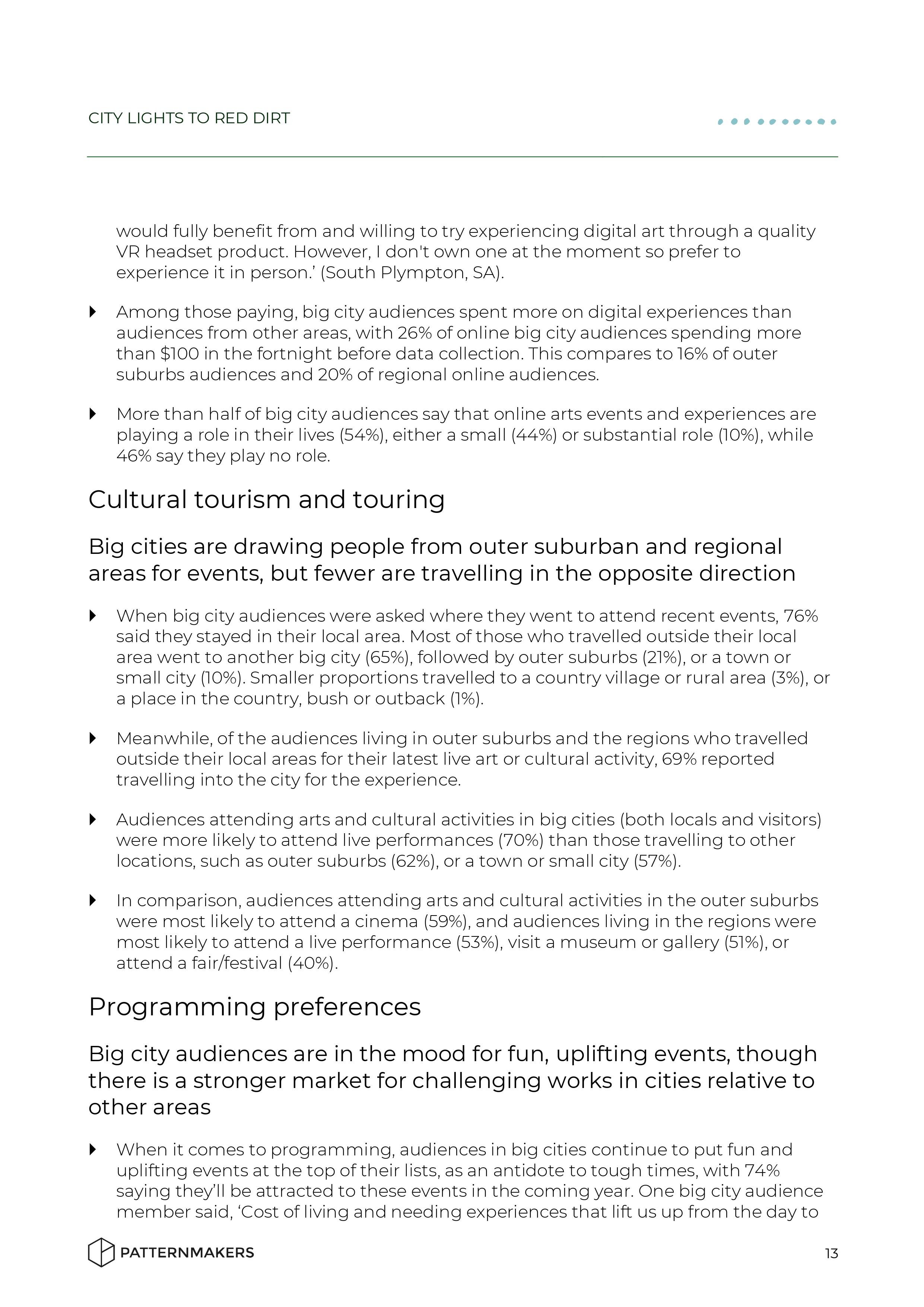

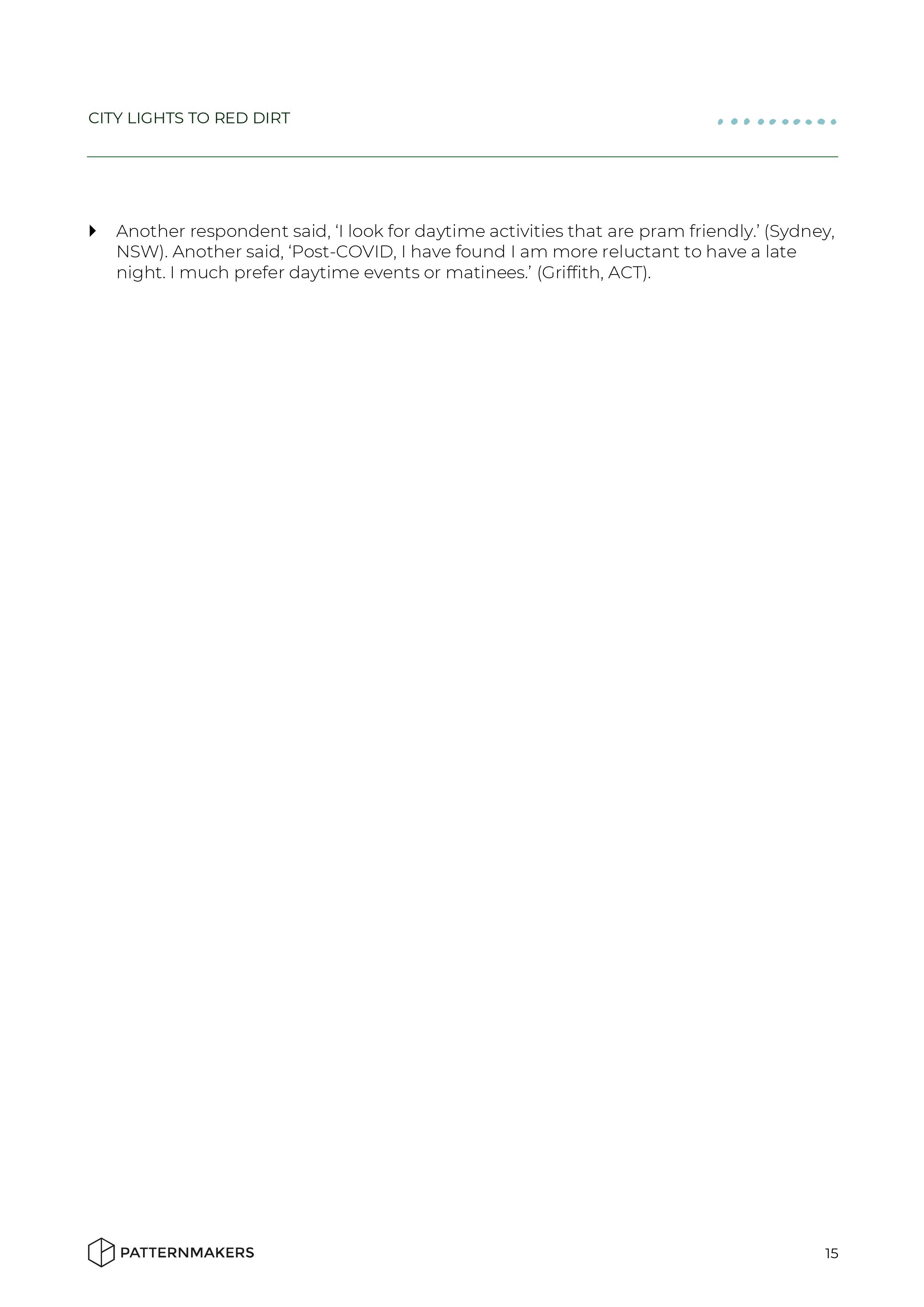
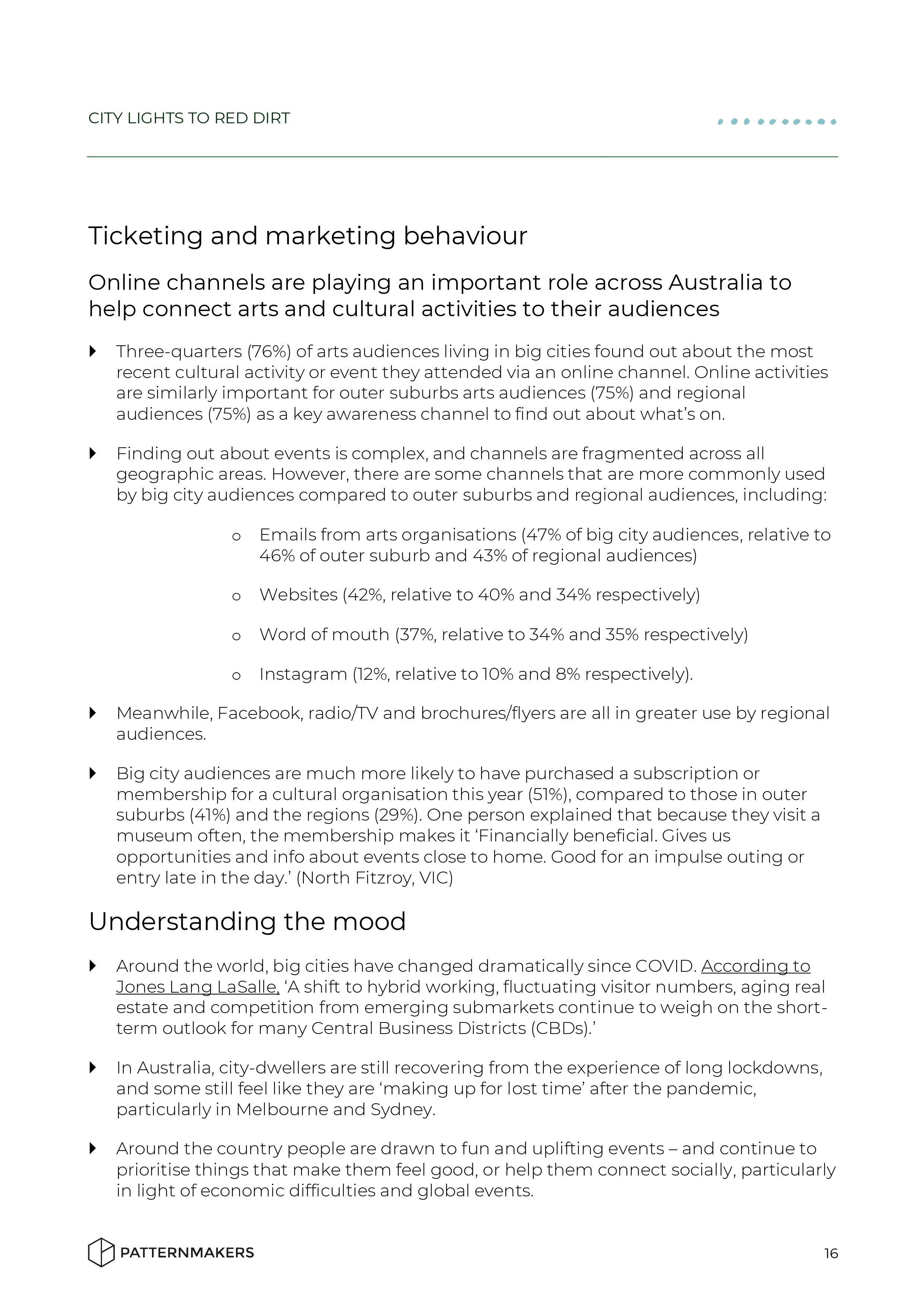


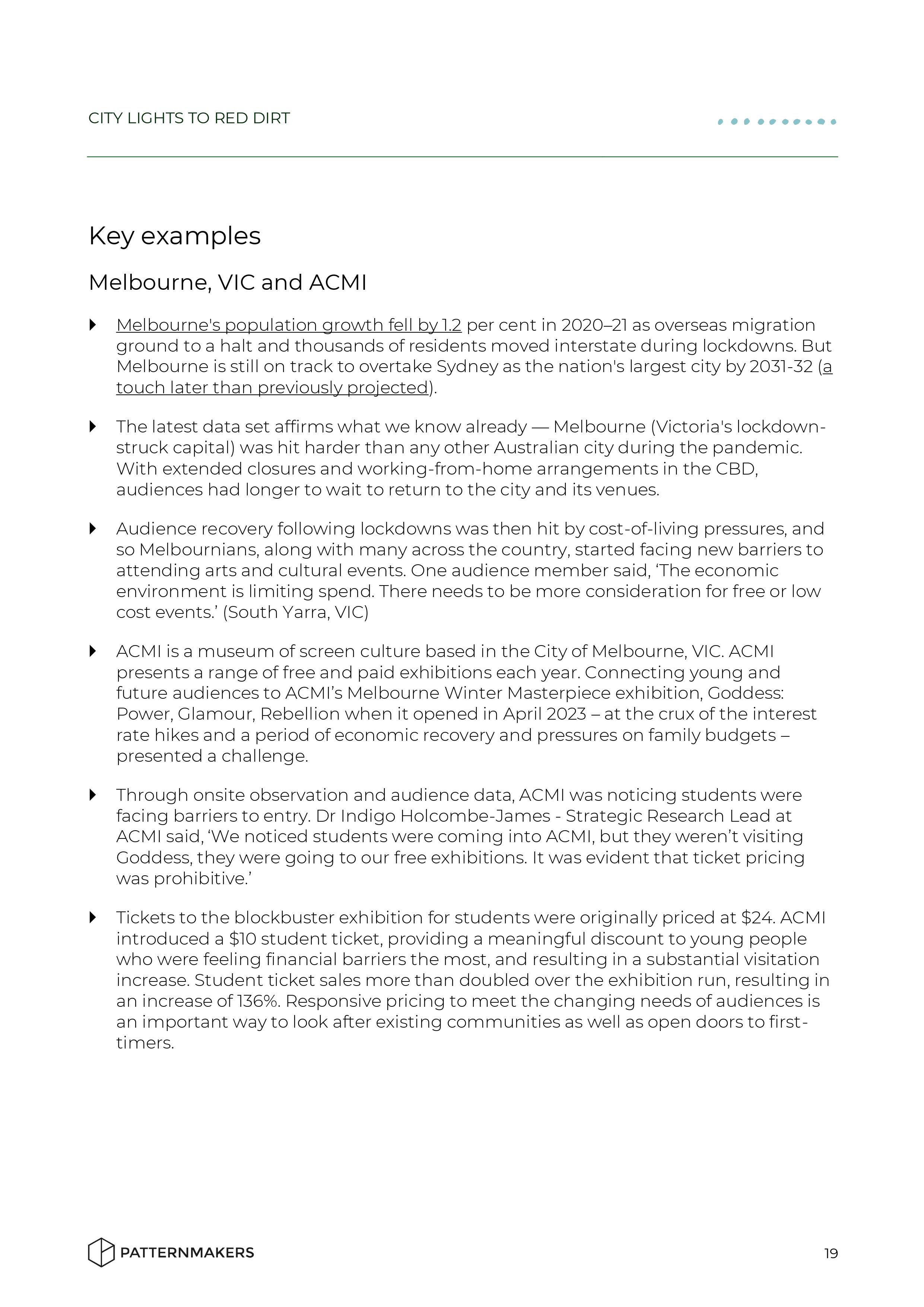
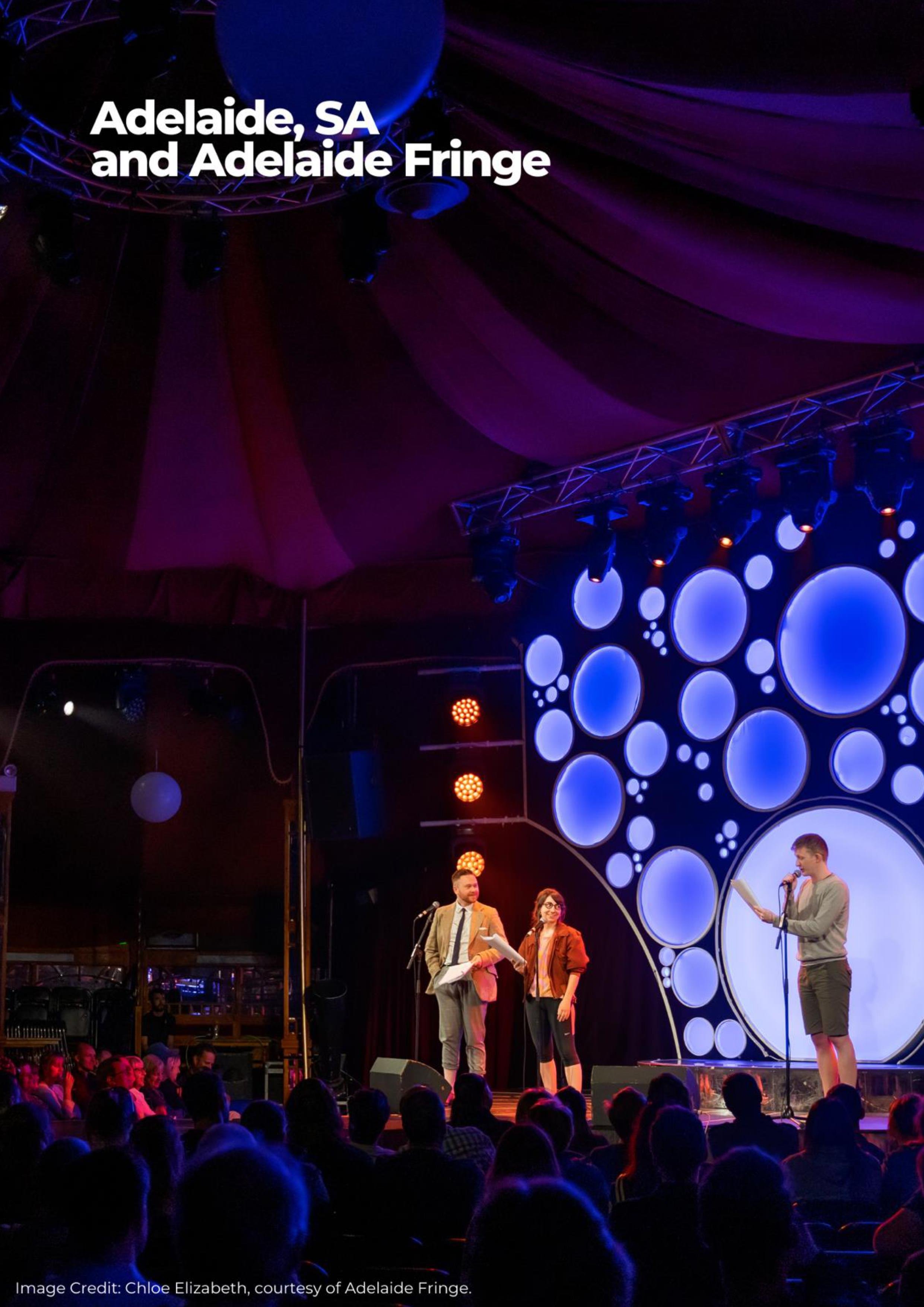


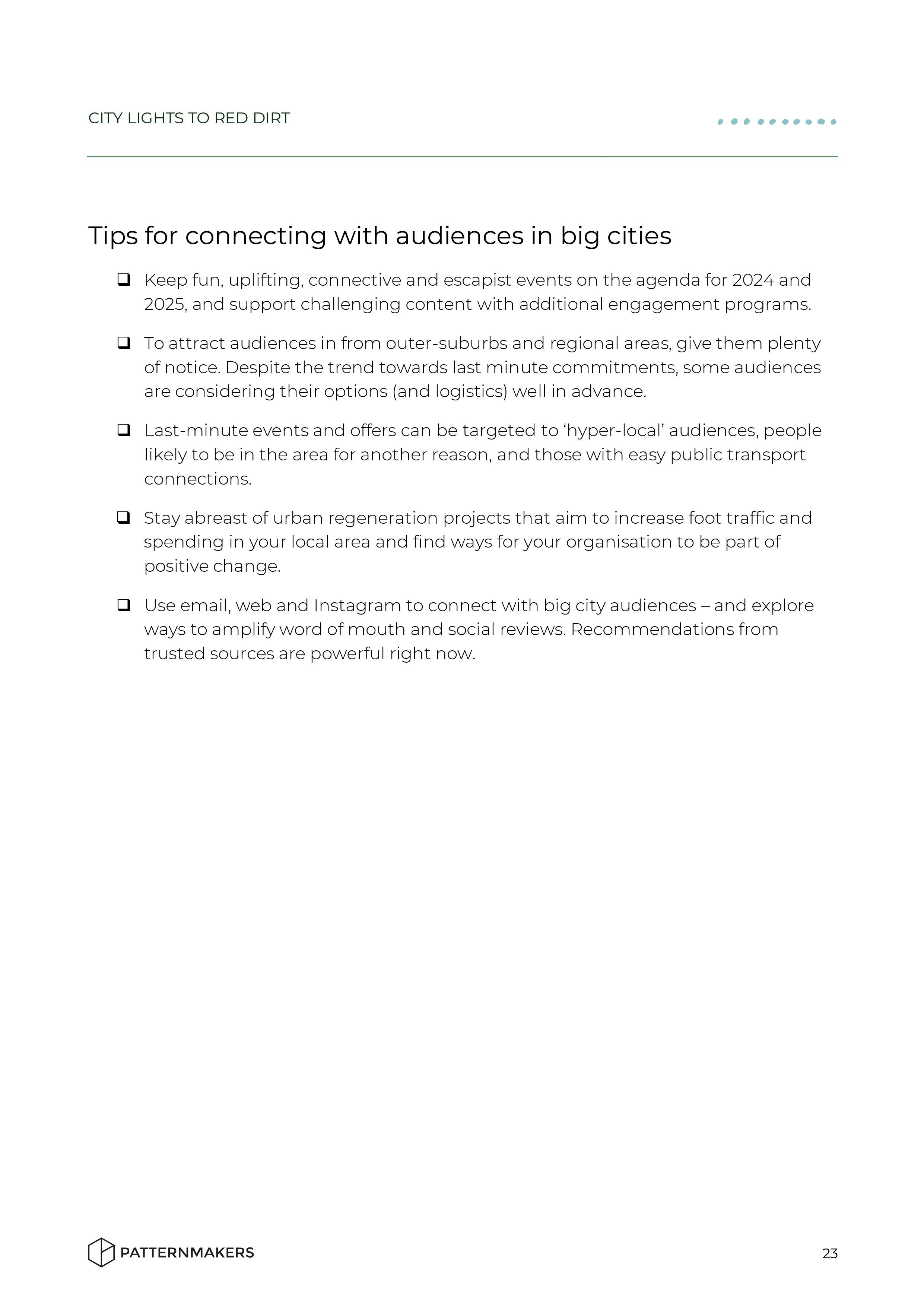

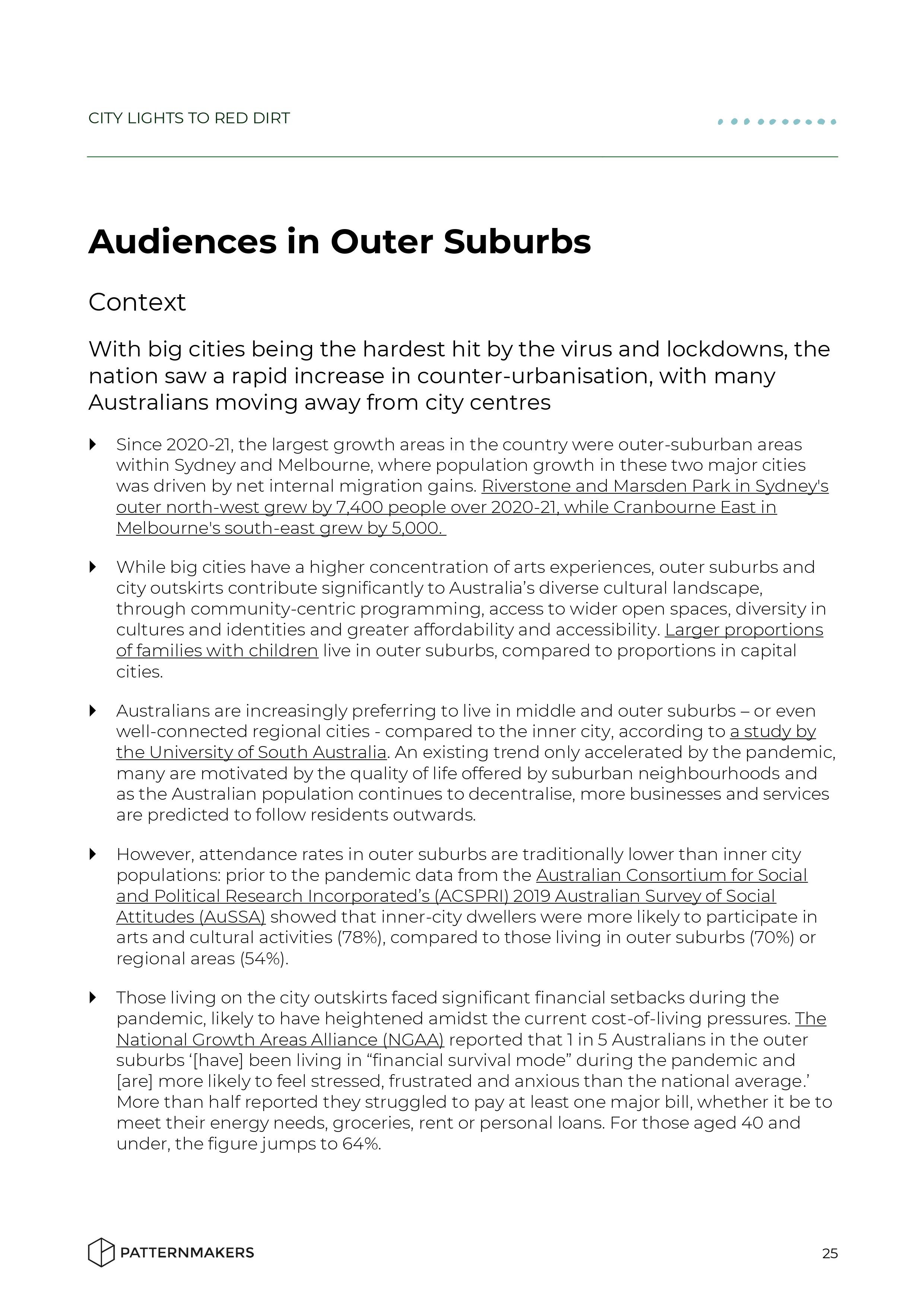
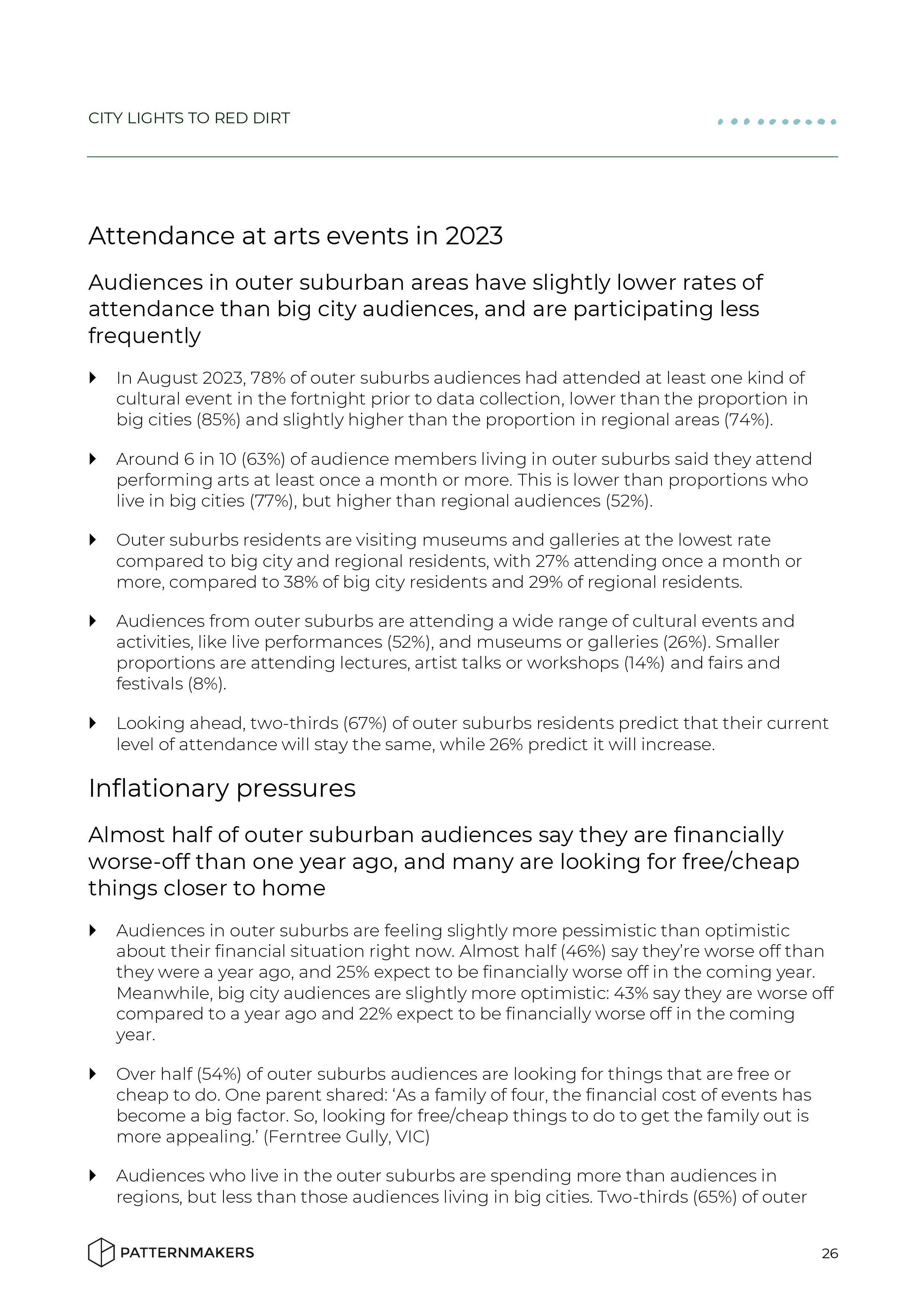
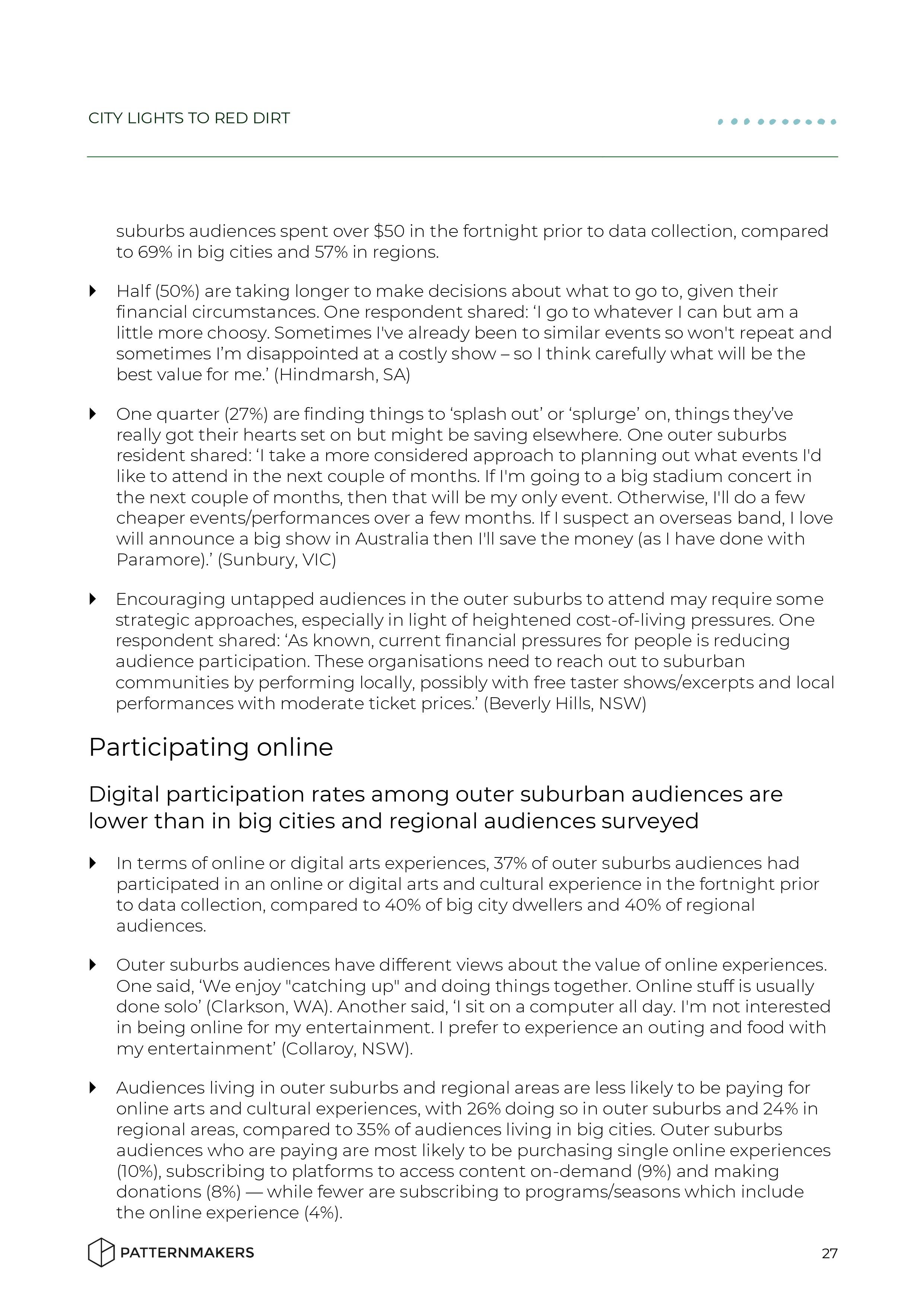
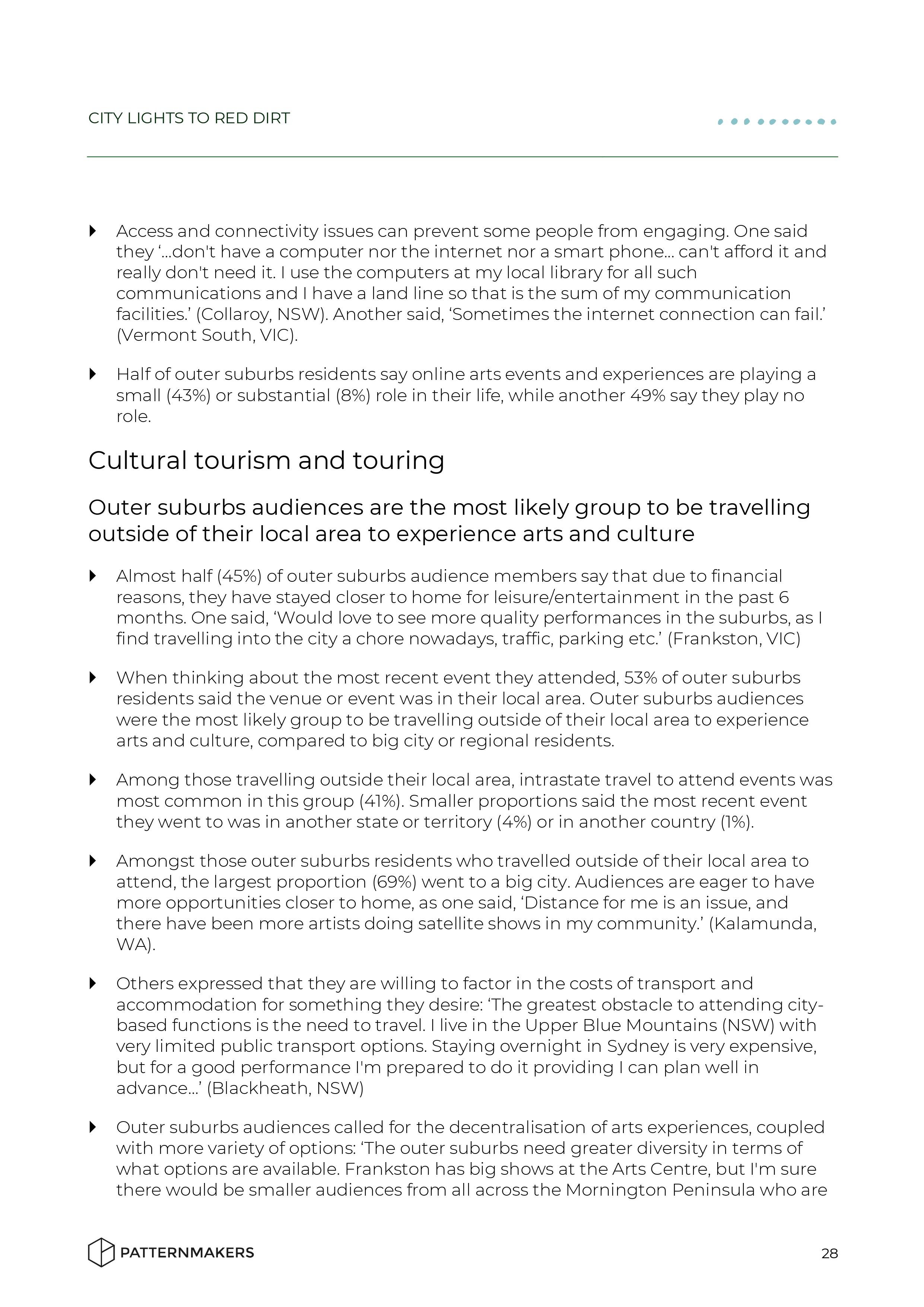


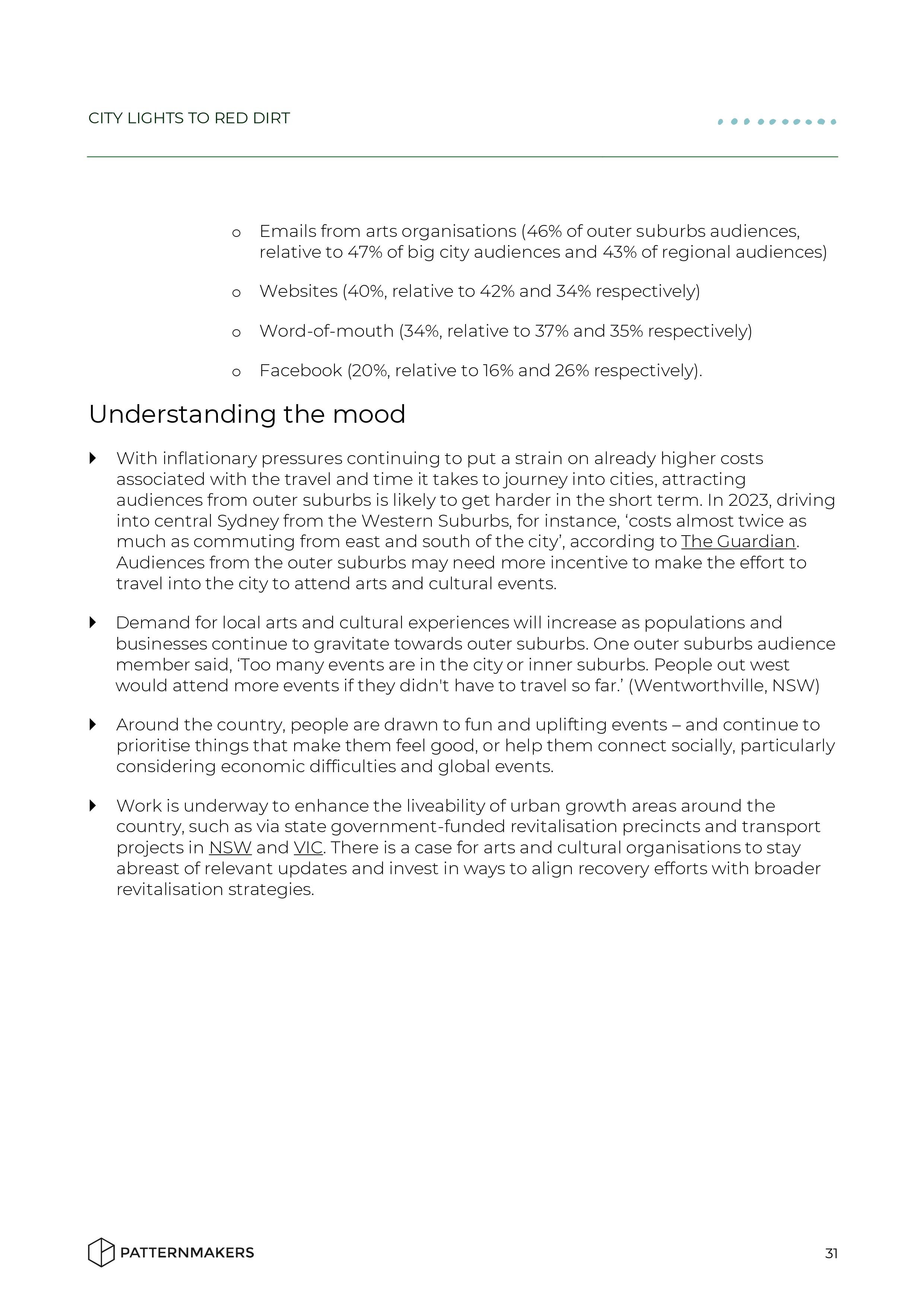
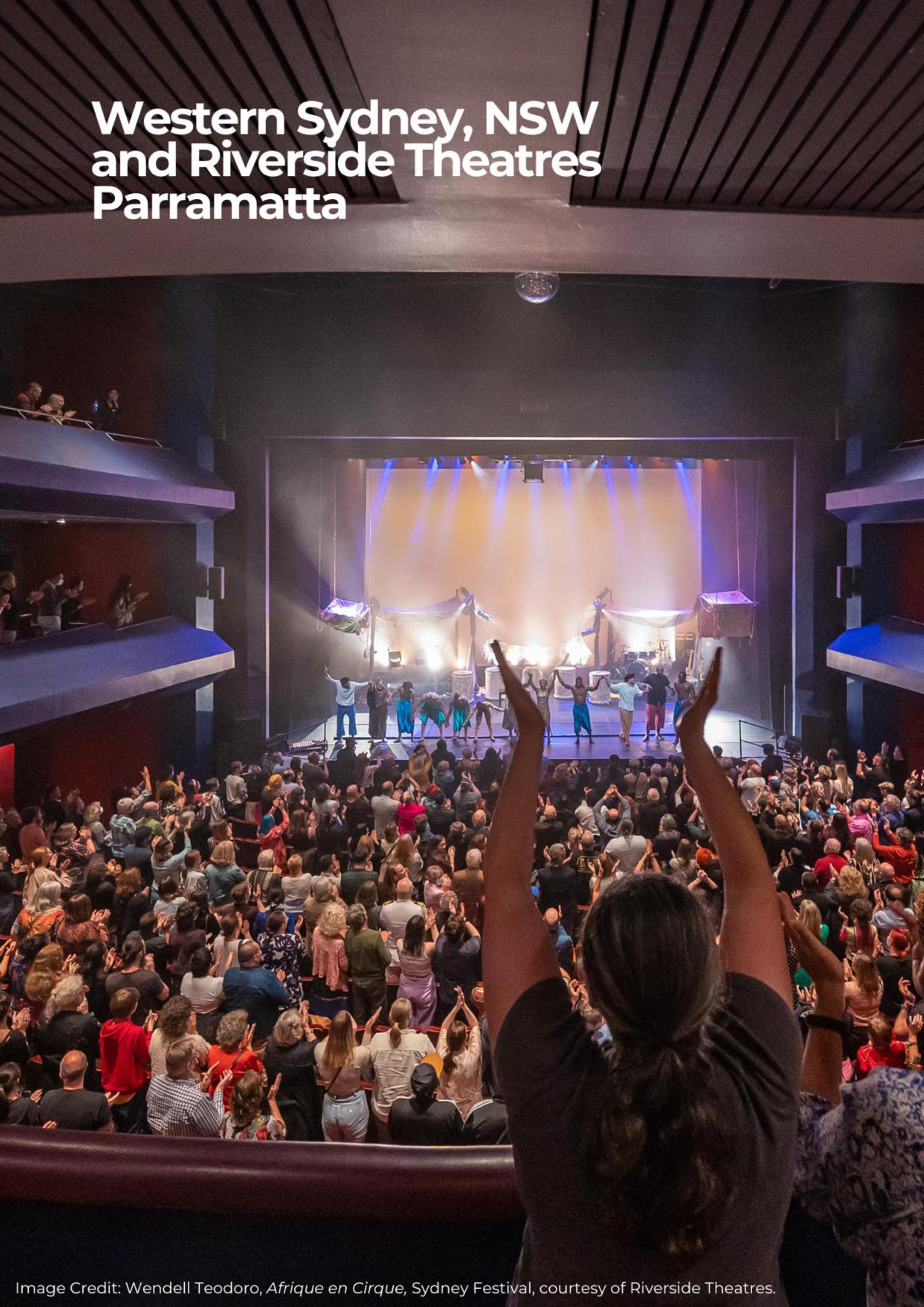
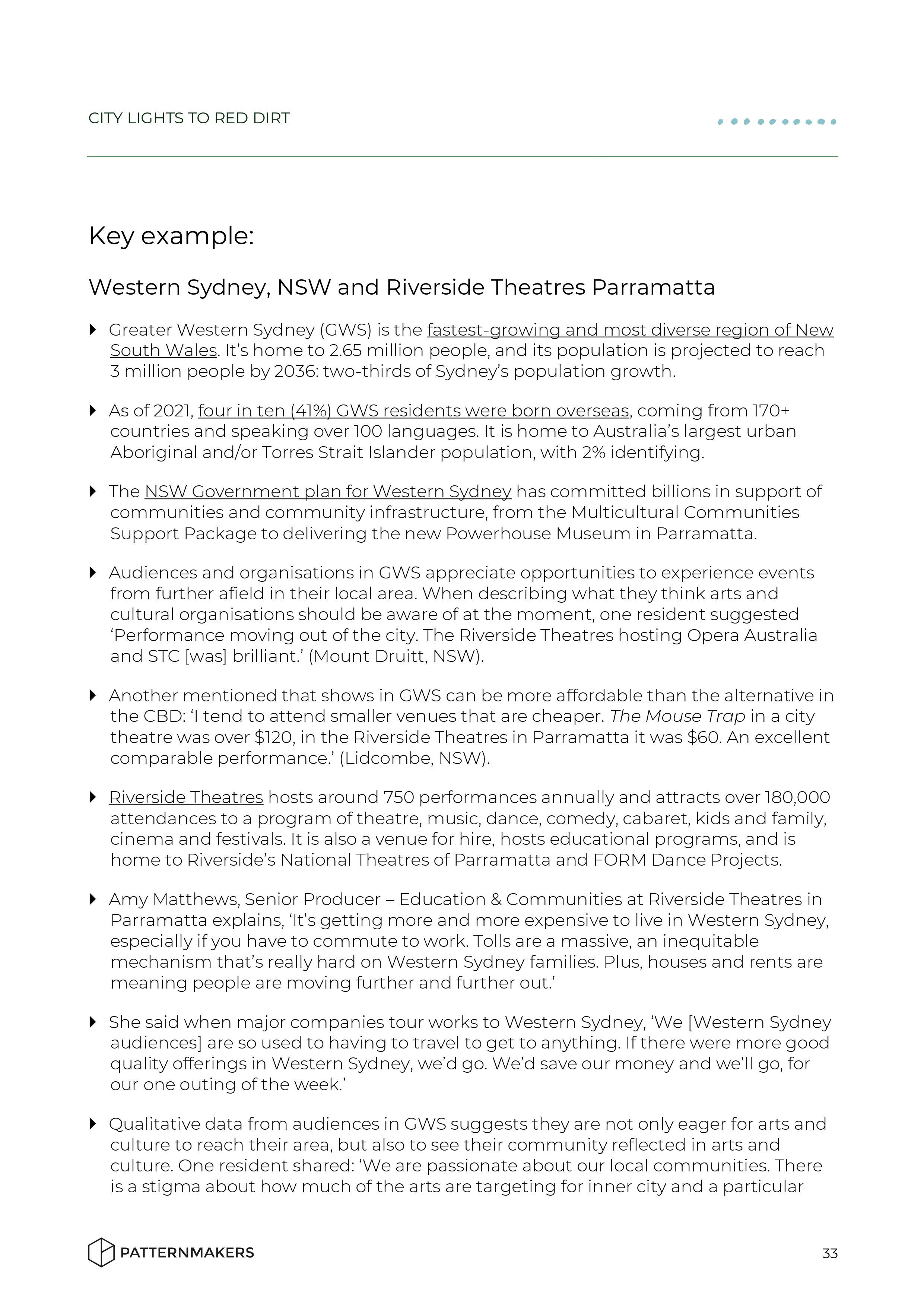



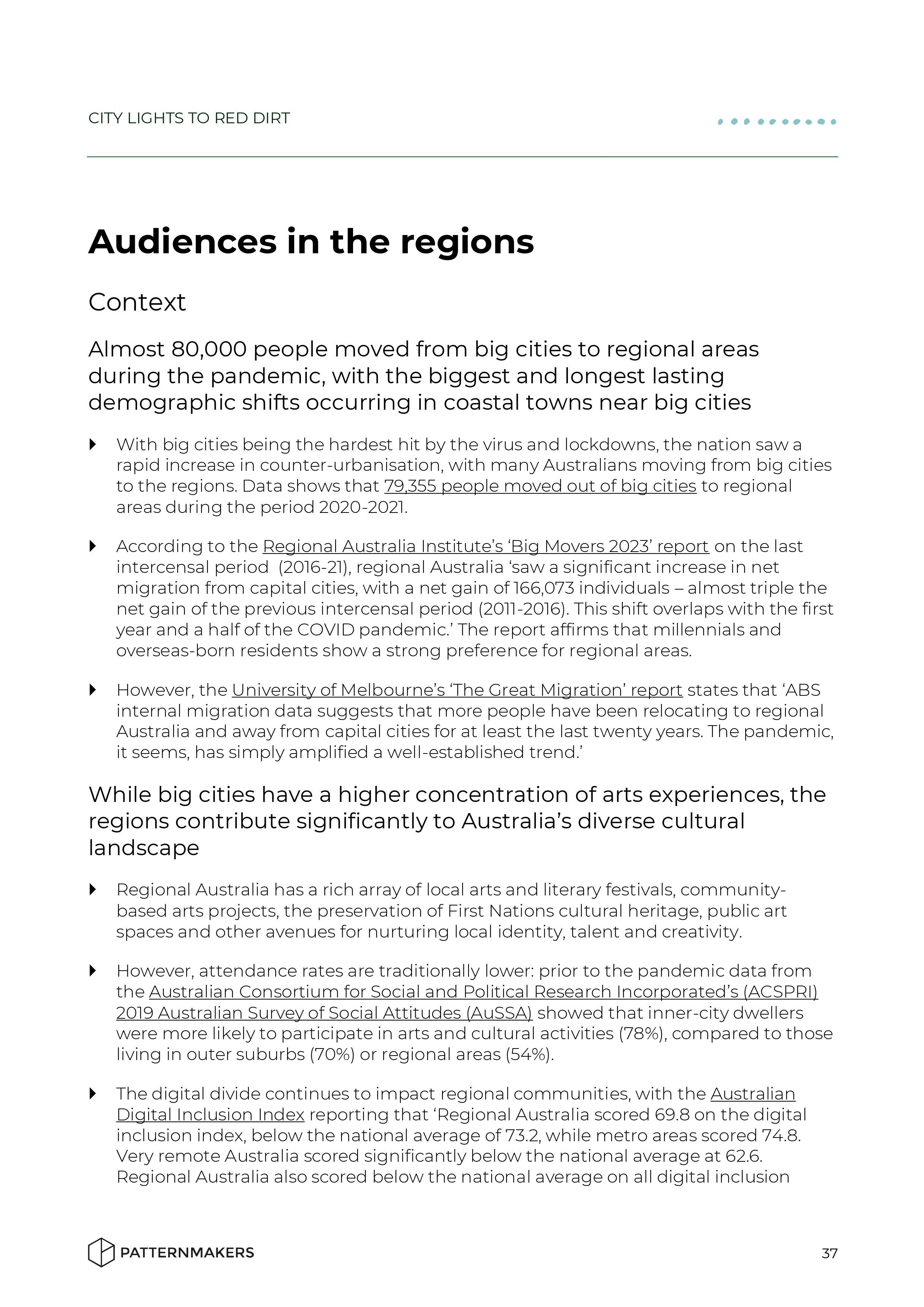
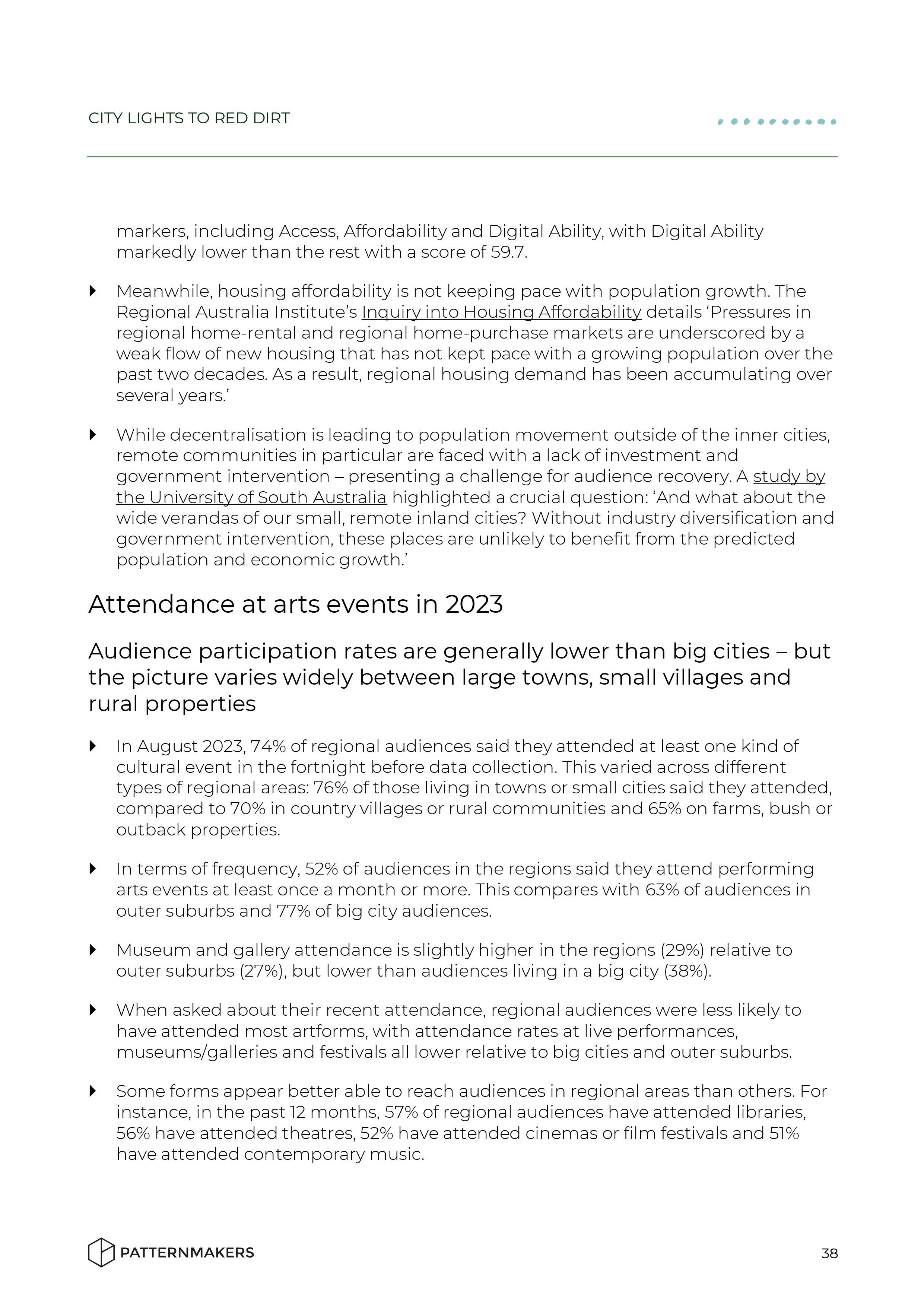
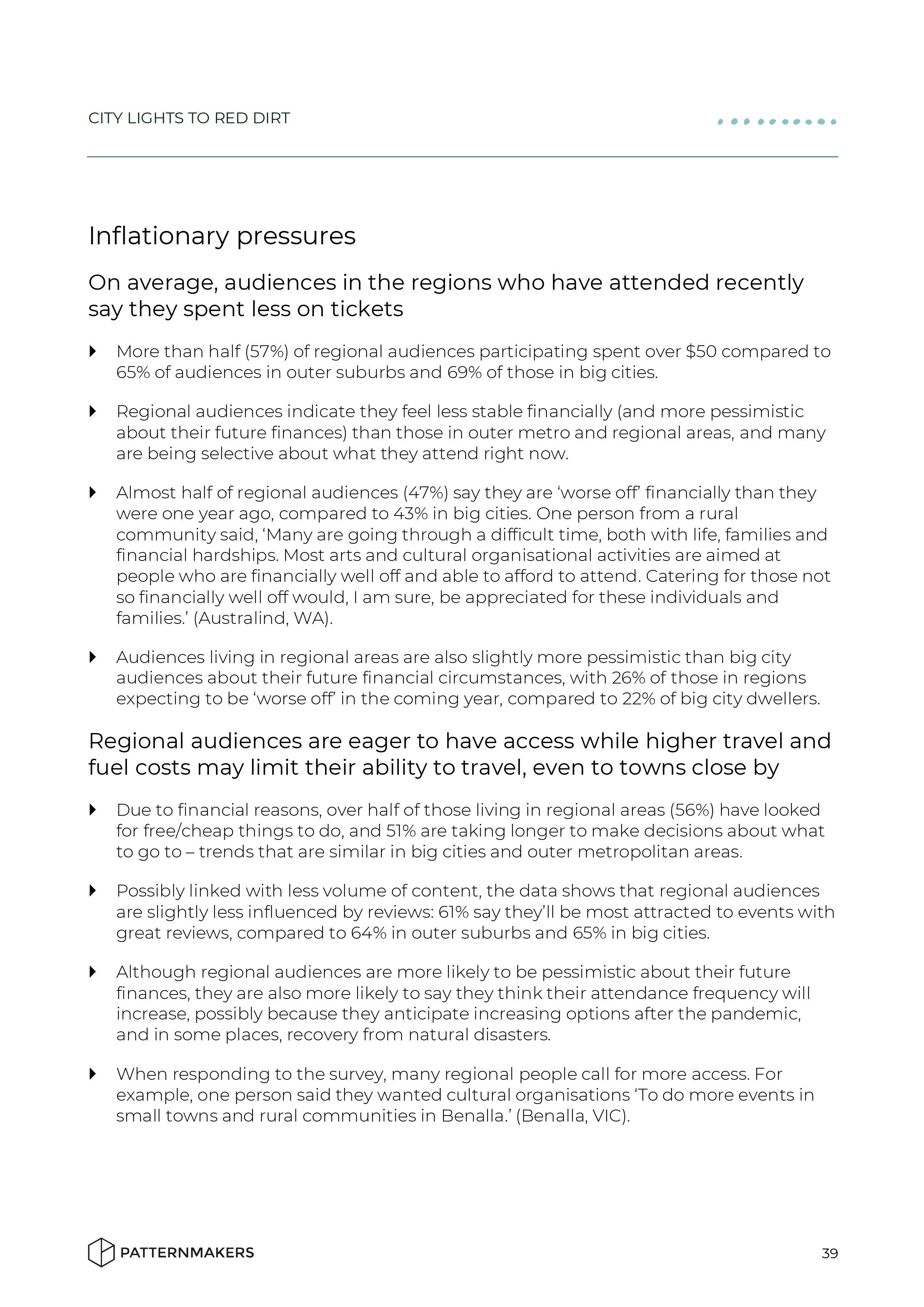
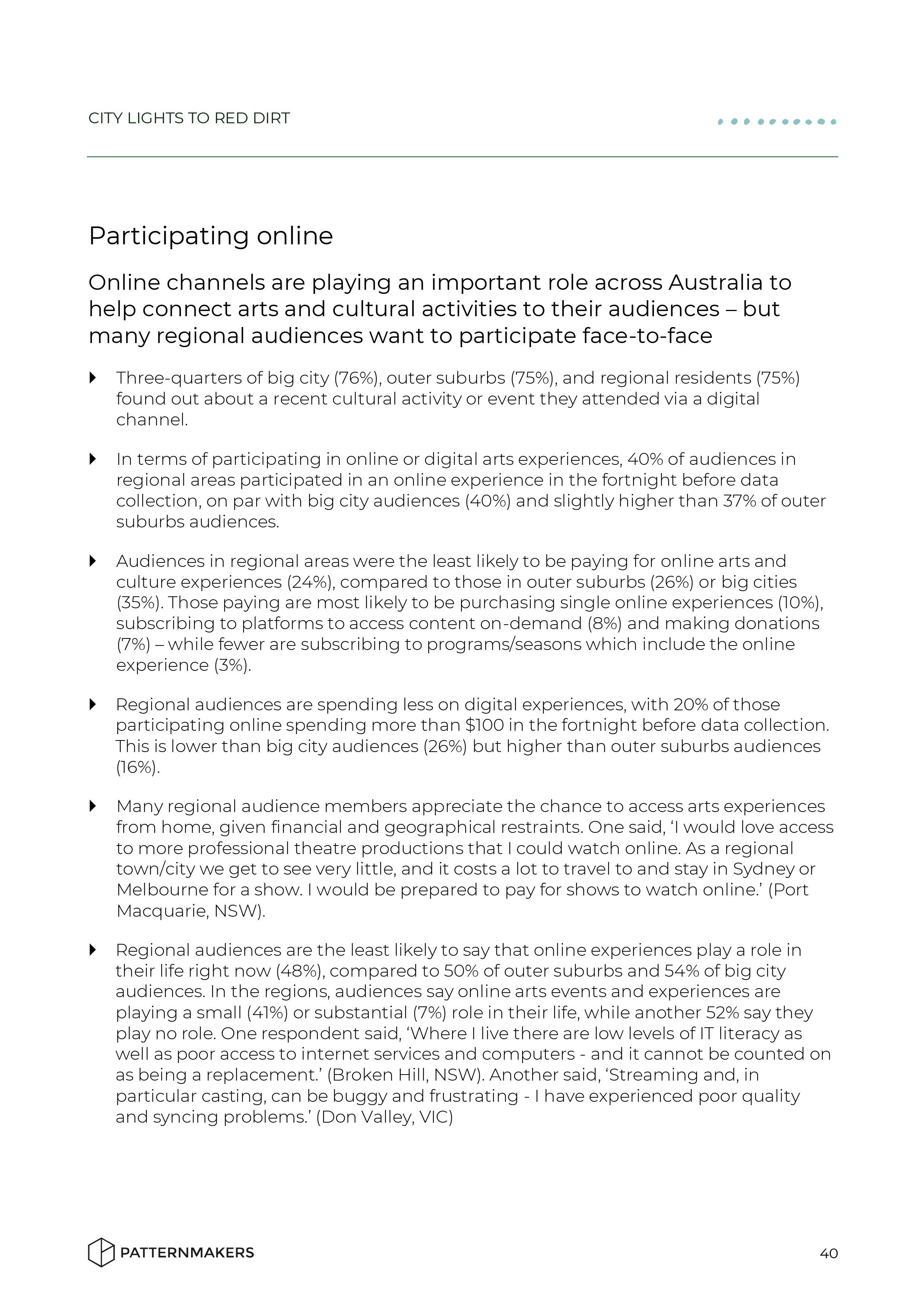
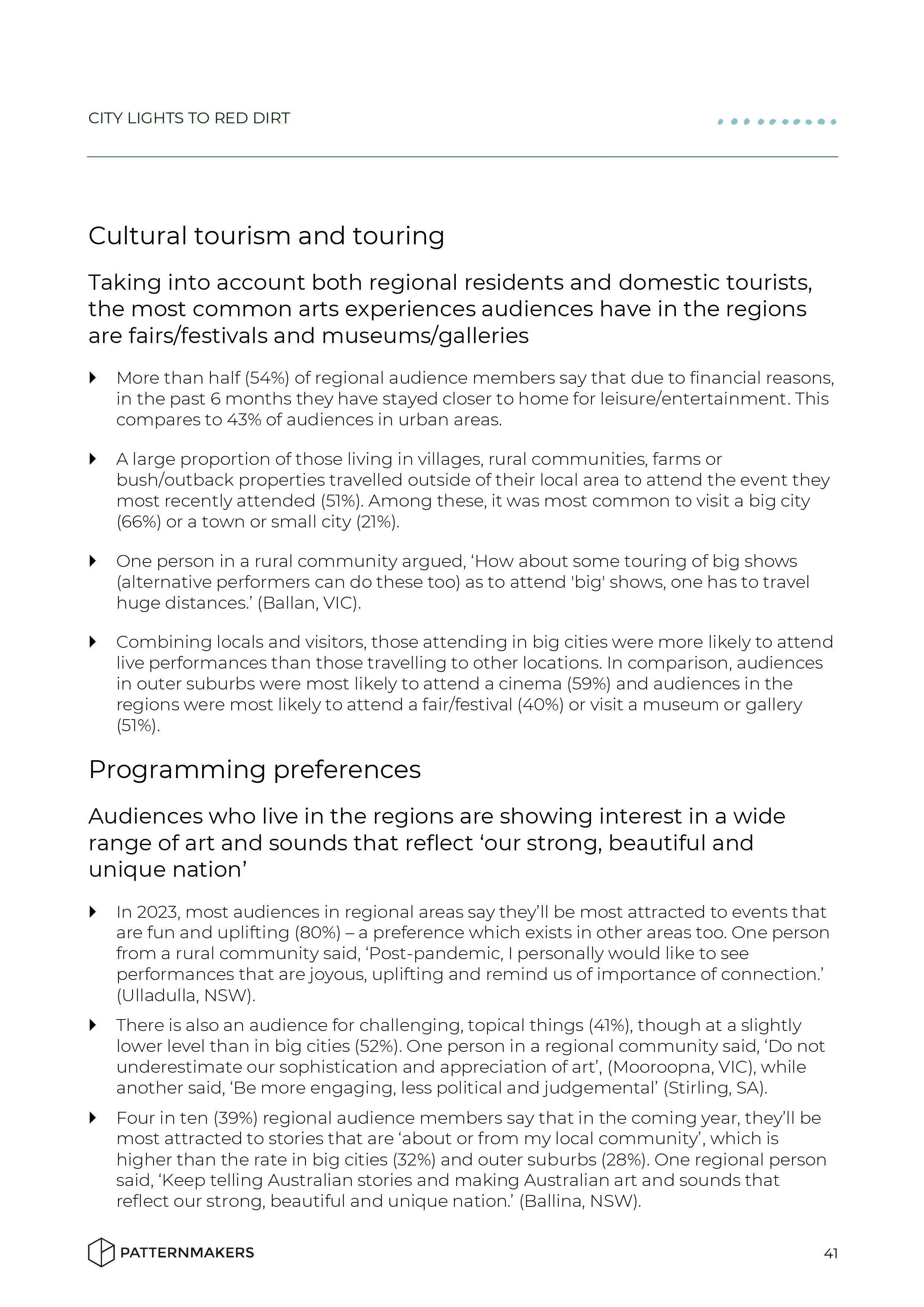
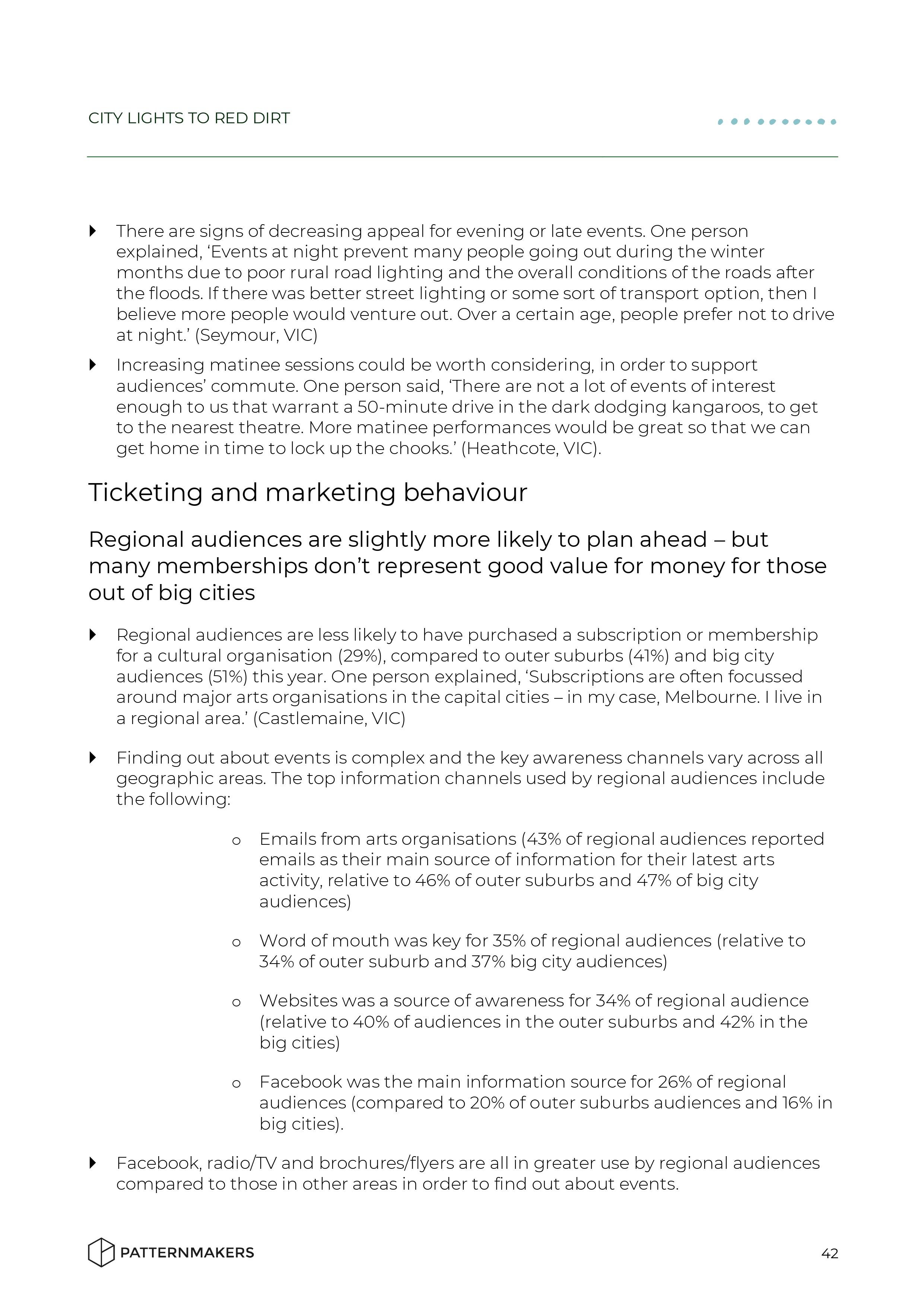
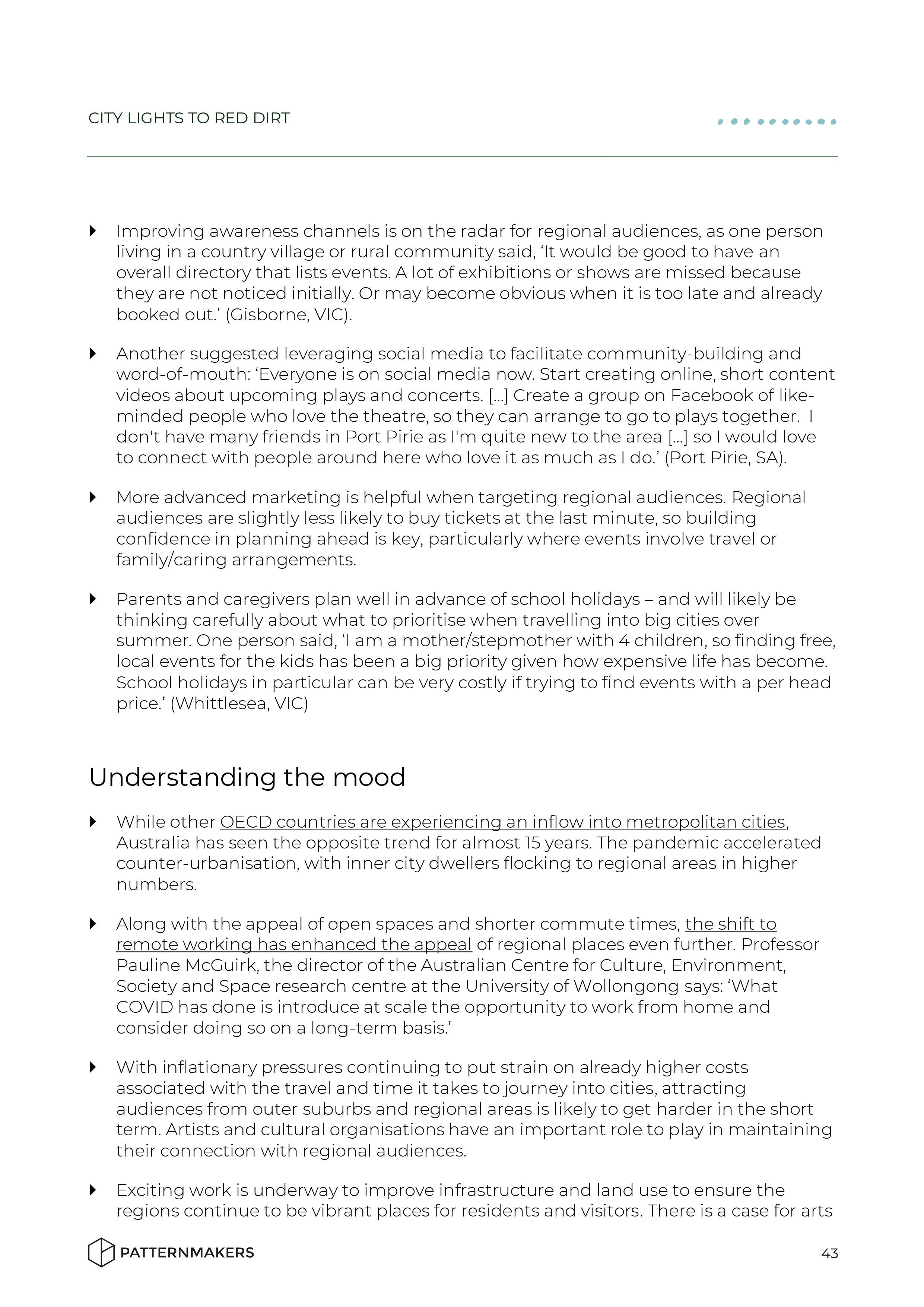


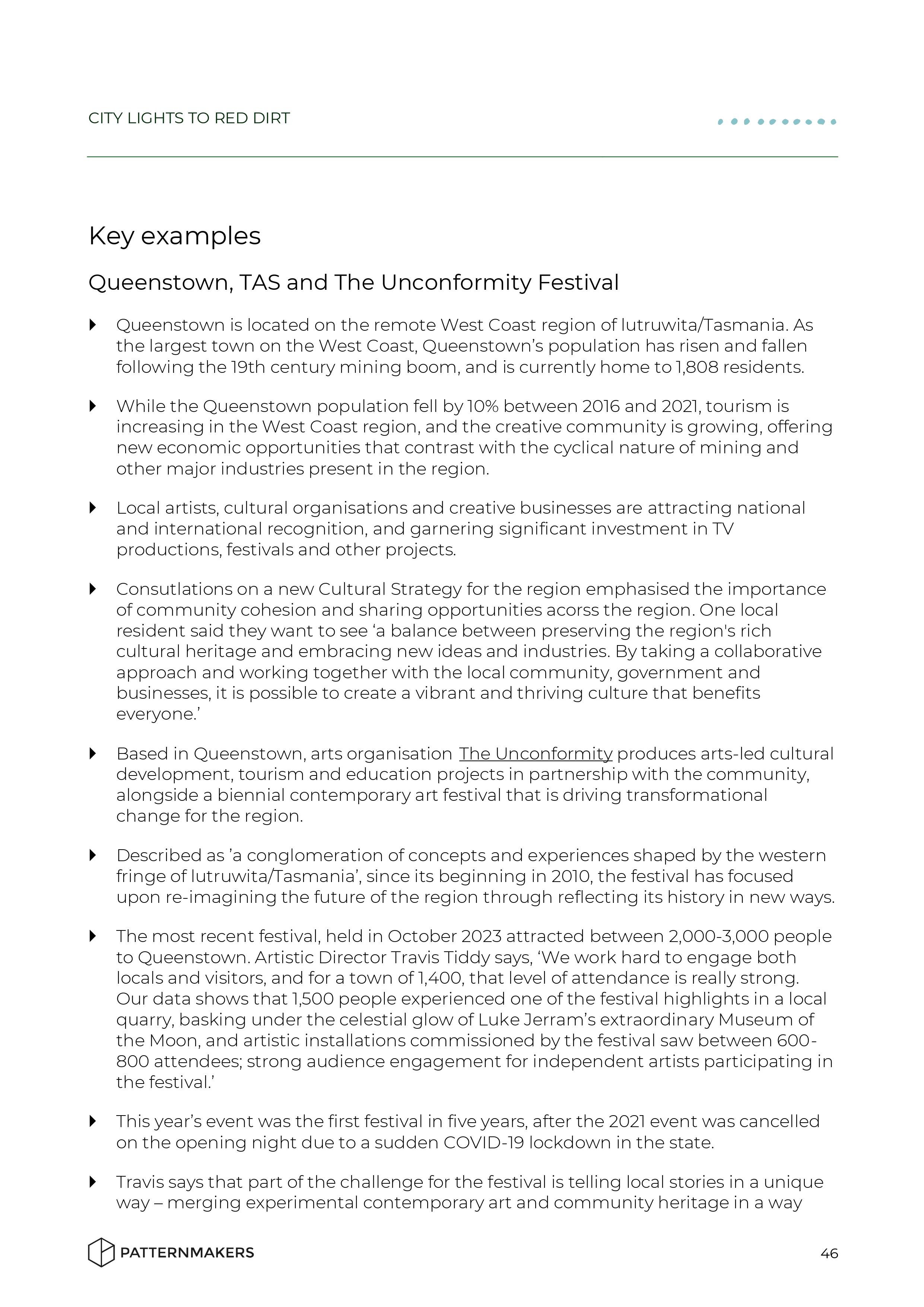
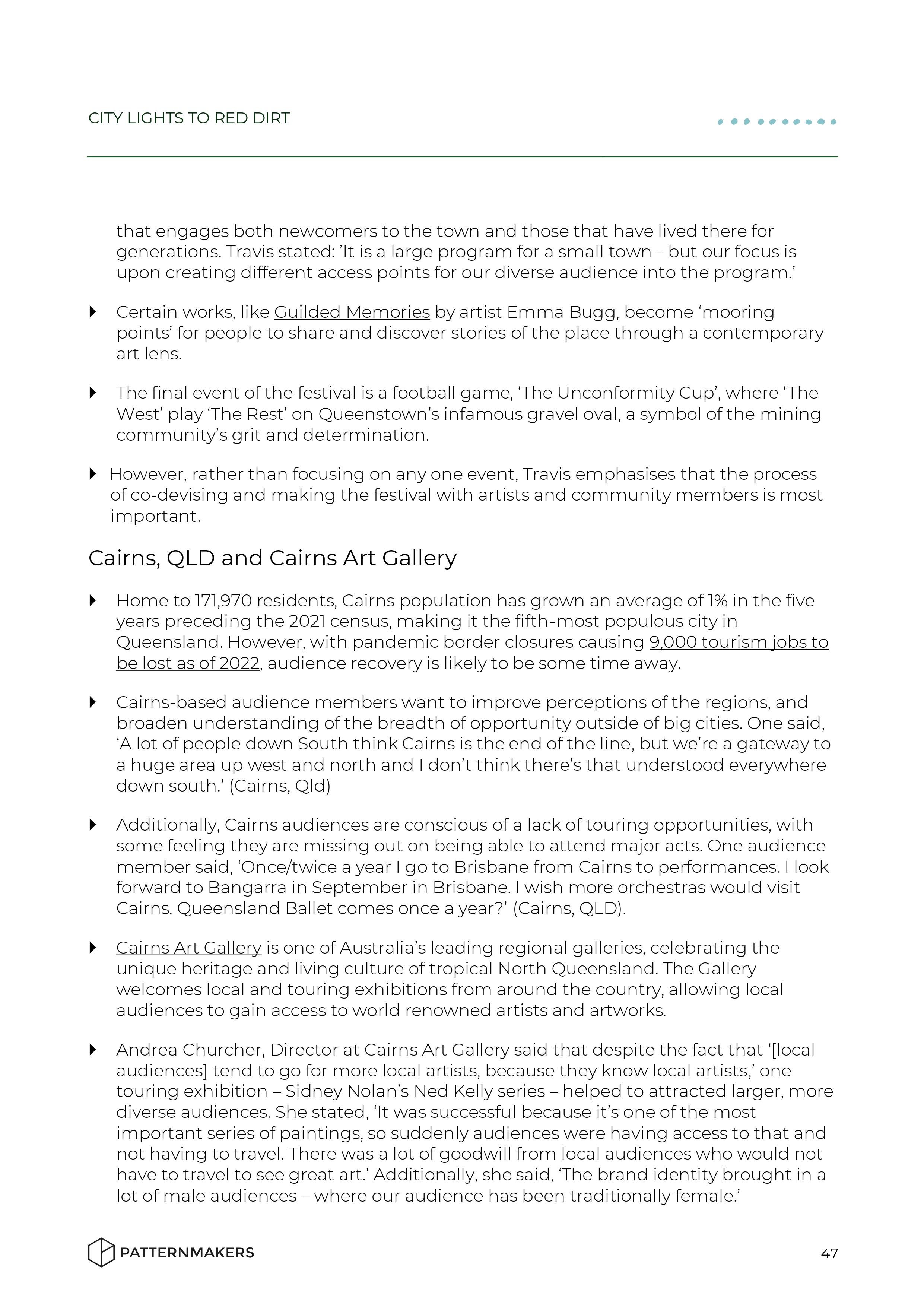
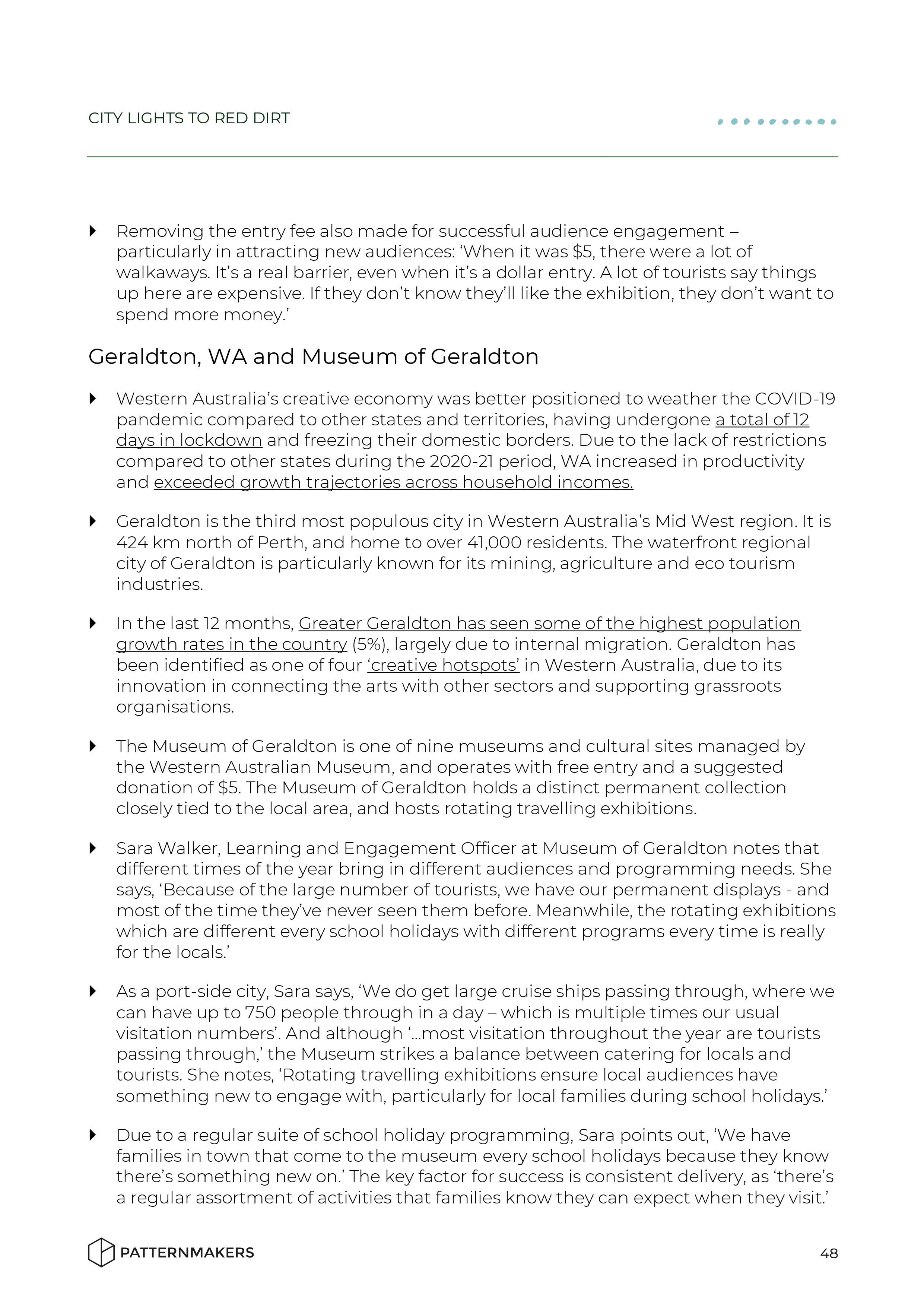
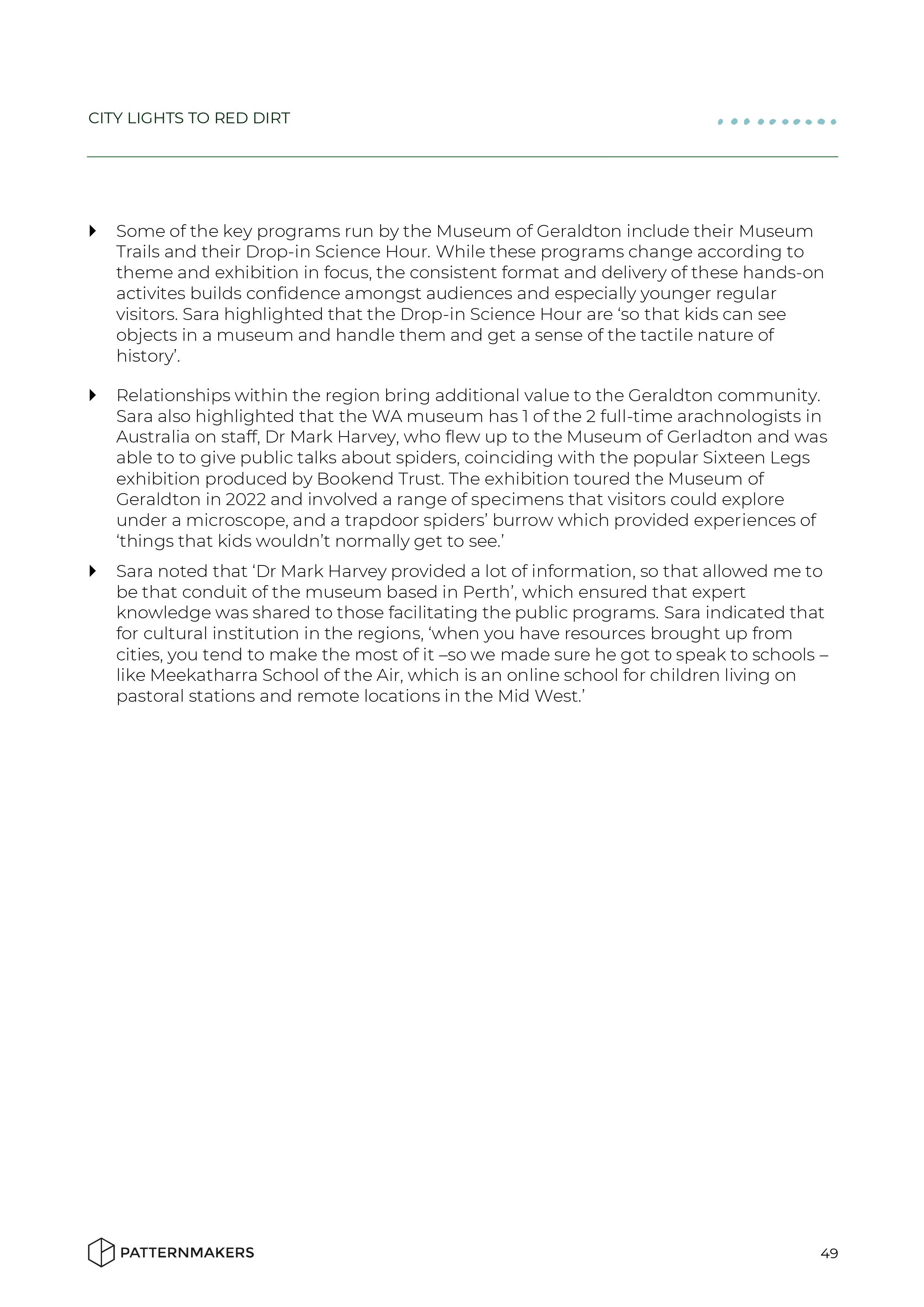
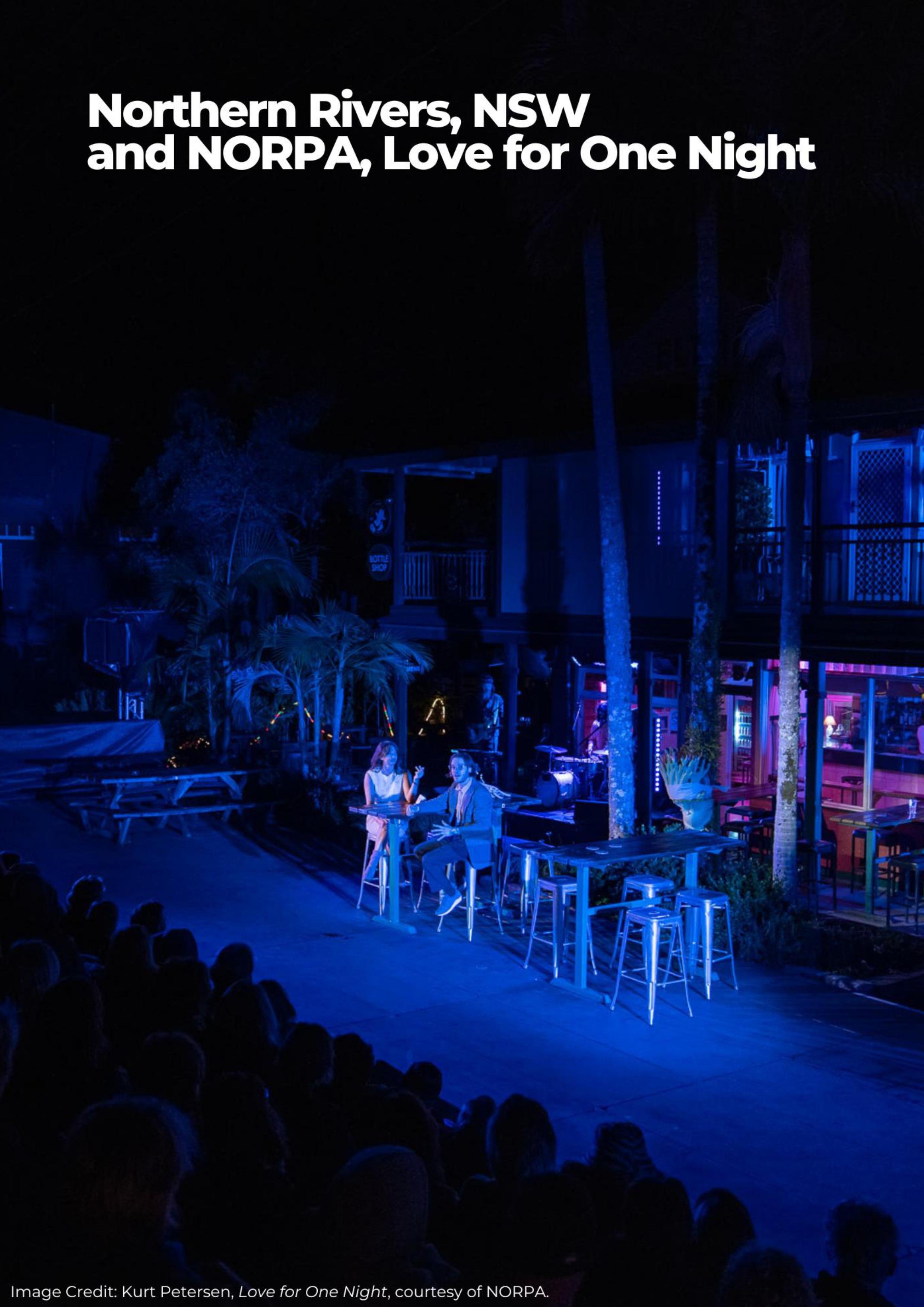
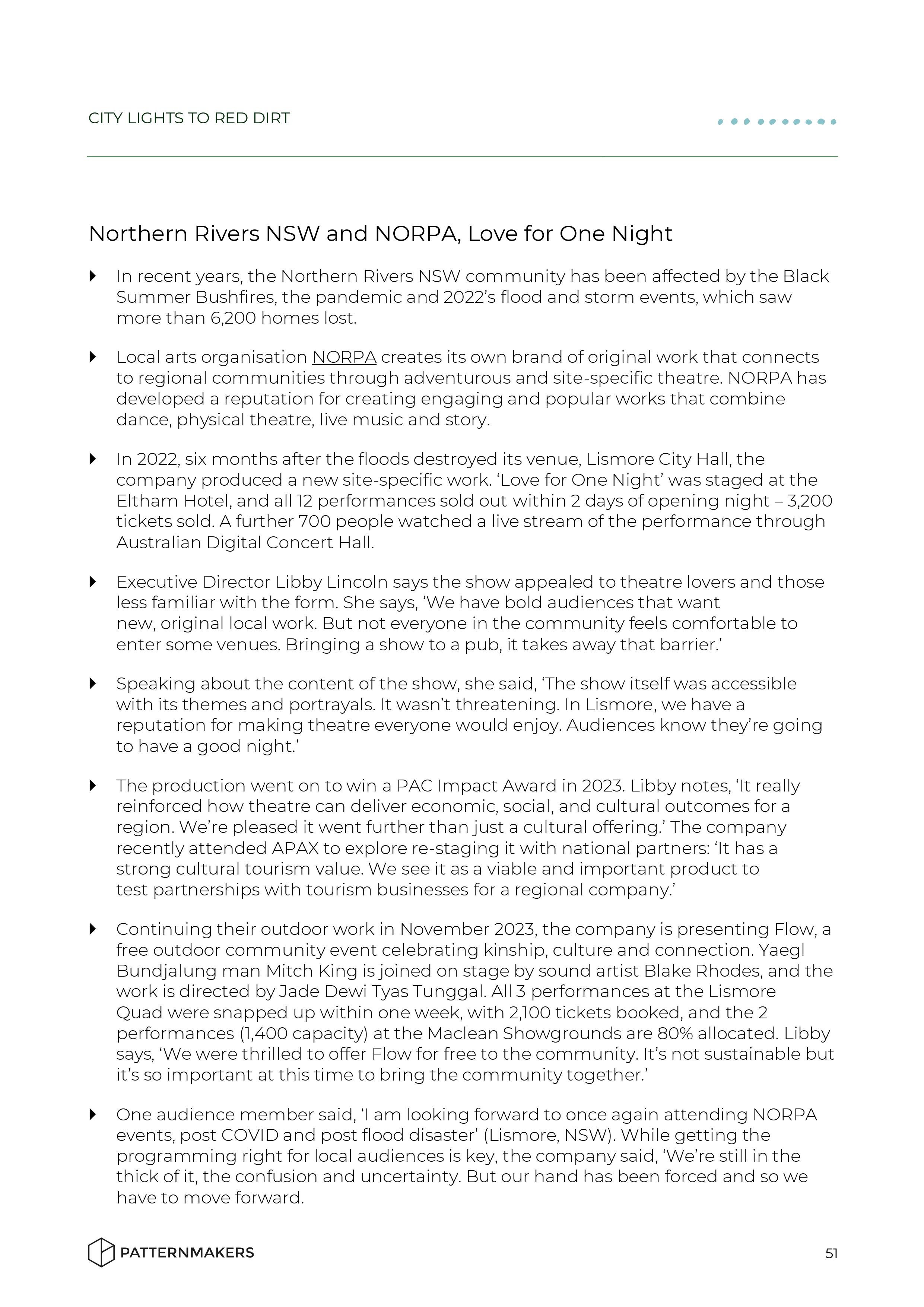

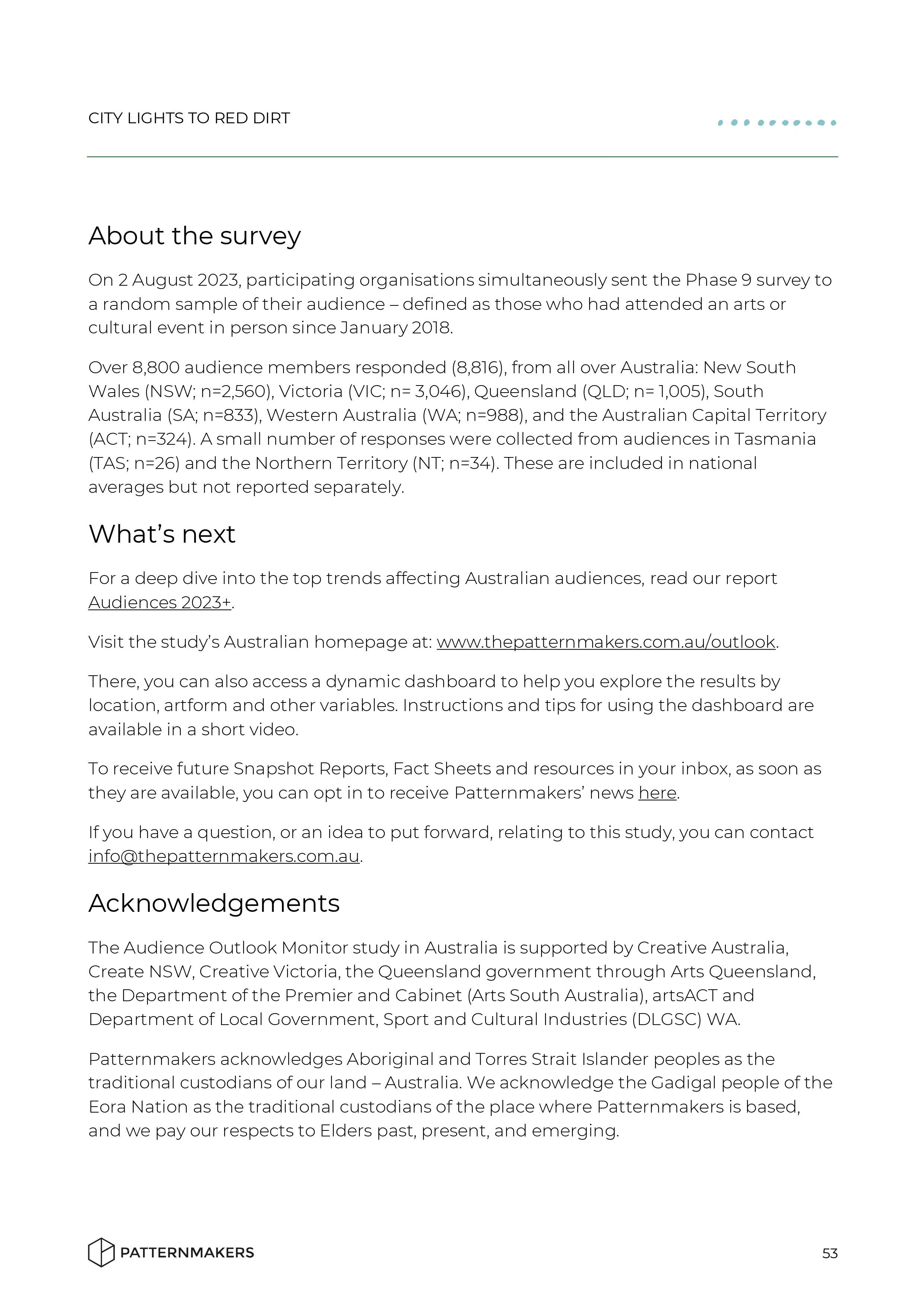

Click the buttons below to download the report, as a PDF or accessible Word version, or read on for more of the findings.
Three chapters, three geographic audience segments
The report compares audiences in three main geographic areas, providing insights for connecting people with culture where they live and the places they visit.
Download the chapters as separate fact sheets below.
Audiences in Big Cities
Arts audiences in big cities are experiencing the arts at high levels, but with market saturation and the shifting dynamics of Australia's CBDs post-pandemic, new challenges have emerged for organisations to cut through.
-
In Australia’s big cities, more people are attending arts events more often, but resident arts organisations are competing in a congested market. The data from past attendees shows that:
85% of big city audiences said they attended at least one kind of cultural event in the fortnight before data collection. Attendance is also more frequent amongst big city arts audiences: 38% attend a gallery or museum at least once a month, compared to outer suburbs (27%) and regional audiences (29%).
Arts audiences living in big cities are spending more on tickets to in-person live events and cultural activities: 7 in 10 spent more than $50 the fortnight before data collection (69%), compared to 65% of outer suburb audiences and 57% of regional audiences.
While most audiences are drawn to fun, uplifting and even escapist content right now, big city audiences are showing a greater appetite for challenging, topical content in the next 12 months (52%), compared to audiences living in outer suburbs and regional areas (both 41%). With more options on offer, they are also more likely to tune into reviews when considering what to attend.
Audiences in Outer Suburbs
Outer suburbs are the biggest growth areas in Australia right now, and have an expanding arts audience looking for more cultural experiences closer to home — but don't yet have enough venues nearby to accommodate.
-
In the outskirts and outer suburbs of big cities, the rate and frequency of attendance are slightly lower than big cities, but the market is growing, as more people move to more affordable areas where families can enjoy different lifestyles. The data from past attendees of events shows:
Audiences in outer suburbs are feeling slightly more pessimistic than optimistic about their financial situation, with almost half (46%) say they’re worse off than they were a year ago, and 25% expect to be financially worse off in the coming year.
Audiences in outer suburbs (combining both residents and visitors) were most likely to attend a cinema locally (59%), whereas big city audiences were comparatively more likely to attend a local live performance. Audiences in the regions were most likely to attend a fair/festival locally (40%) or visit a museum or gallery (51%).
Audiences in outer suburban areas are the least likely to be participating in online events right now. Half of outer suburbs residents say online arts events and experiences are playing a small (43%) or substantial role (8%) in their life, while another 49% say they play no role.
Audiences in the Regions
Across Australia's diverse regions, audiences are experiencing access to arts and culture differently. Factoring in extra time and travel costs means heightened barriers in 2023, but with a decentralising trend, more options could be on the cards.
-
Regional Australia is changing, with demographic shifts seeing some regional places grow dramatically in recent years – but rising costs of travel are leaving some isolated. There are different patterns for large towns, smaller villages and bush or outback areas, but on average, the data shows that:
Regional audiences indicated feeling less stable financially and more pessimistic about their future finances than those in outer suburbs and big cities, and many are being selective about what they attend right now. Almost half (47%) say they are ‘worse off’ financially than they were one year ago, and 26% expect to be ‘worse off’ in the coming year.
Regional audiences have lower levels of access to some types of events, like live performances, and therefore attend less often: 52% of audiences in the regions said they attend performing arts events at least once a month or more, lower than proportions in big cities (77%) and outer suburbs (63%).
Some art forms appear to reach audiences in regional areas better than others. For instance, in the past 12 months, 51% of regional audiences have attended contemporary music and 57% have attended libraries, which are similar to attendance rates in urban areas.
Four in ten regional audience members say that in the coming year, they’ll be most attracted to stories that are ‘about or from my local community’ (39%), slightly higher than the rate in big cities (32%) and outer suburbs (28%).
Get the data at a glance
Click the button below to download our Fast Facts for attendance, inflationary pressures, programming preferences and ticketing and marketing behaviour.
Read the ‘Audiences 2023+’ report
In case you missed it, click the button below for the key insights from the August 2023 National Snapshot.
Use the dashboard to get results for your artform and region
Survey data from Phase 9, which heard from over 8,800 respondents, has been uploaded to the dashboard, which now contains insights from over 100,000 Australian participants.
You can use the dashboard to explore the findings by state/territory, artform and audience segment.
It’s freely available to access, just click the image below and use the login details provided on the dashboard page.
About the Audience Outlook Monitor
The Audience Outlook Monitor provides the results of a study that has tracked audience sentiment over the course of the COVID-19 pandemic.
Data was collected in six phases throughout 2020-2022 and is again being tracked in 2023.
Government agencies across Australia are collaborating with research agencies Patternmakers (Sydney) and WolfBrown (USA) to produce this resource. The dashboard is freely accessible and designed to help artists and cultural organisations of all kinds to make the best possible decisions.
How to find out more
To receive new releases directly into your inbox, as soon as they are available, you can opt in to receive updates below.
If you have a question, or an idea for using this data, please contact Patternmakers at info@thepatternmakers.com.au
Programming, price and planning: What the latest research means for audiences
In this article, we unpack our major Audience Outlook Monitor publication ‘Audiences 2023+’, and offer the key takeaways for audiences themselves.
Unpacking our latest audience research for audiences themselves.
We’ve emerged from some serious analysis, made possible thanks to all 8,816 arts audience members that participated in the latest round of our Audience Outlook Monitor.
If you’re keen to get into the nitty gritty, you can read the full Audiences 2023+ report here. If you’re just looking for the key takeaways, and what the findings mean for audiences just like you, keep reading.
Let’s get into it!
In the mood for fun and uplifting events right now? You’re not alone.
Following the past two years and current cost-of-living pressures, there’s no wonder that most arts audiences are looking for fun and uplifting things (77%), while reviews (63%) and trying new things (55%) are also key drivers.
If you’re not at the stage of email fatigue (and we know many audiences are), it’s worth considering subscribing to your favourite arts venues and organisations – because we found this is really the best way to avoid missing out on programming you’re sure to love.
Arts orgs are a lot more aware of the strain of email marketing than before and are really limiting when they reach out to you – and most are waiting to for the right moment to connect when it’s necessary.
Right now, some audiences are getting their fix without spending big.
Many audiences are looking for free or cheap things to do (55%), and some are keeping it local to enjoy live arts experiences (47%) and staying closer to home to avoid paying the premium of travel and larger productions.
You have likely seen the many reports on Australia’s cost-of-living crisis, especially its impact on young people. Financial pressures are hitting under 35s the most, coming through in our latest Audience Outlook Monitor round, so look out for special concession offers that are likely aimed at the younger age groups.
Financial reasons continue to be the top barrier for audiences to attend arts experiences, affecting 4 in 10 audience members (38%). Keep updated on the ticketing policy changes from your favourite arts organisations, as many are trying to adapt to your changing needs.
Feeling like your plans are getting a bit last minute? Here’s why booking early helps you and the organisations you care about:
Maybe it’s you, your sister or your friend, but audiences are taking longer to make decisions as they weigh up their options. If this sounds like you, you’re likely one of our ‘last-minute bookers’ – 45% of you reported booking in the last 2 weeks before an event and 12% book on the day!
Late booking can mean missing out on tickets, risking schedule clashes with your crew, but also has got the sector a *little* extra under the pump. And the longer audiences wait, the more life gets in the way. Almost a third (30%) of arts audiences said that prioritising other things was a key barrier for them to attend arts and cultural activities.
So, if you really want to go – you should really book it in (it’s a win-win!), and if it’s flexibility you’re after, make sure you’re across the ticketing policies of your favourite venues.
P.S. Opinions matter, so share them!
If you’re curious about the most affordable way to support your favourite arts and cultural organisations - we found that the #1 awareness channel for you arts audiences is…word of mouth! Don’t underestimate the value of talking about your experiences and sharing your thoughts to those around you (and online), because it’s a sure-fire way of supporting the arts.
If you’re interested in exploring how arts audiences are faring in different areas, be sure to keep an eye out on our website for our upcoming report ‘City light to red dirt: Connecting with audiences across Australia’ — launching November 30th.
Thank you to our partners WolfBrown, Creative Australia, and state arts agencies around the country for their support with the Audience Outlook Monitor publications.
Image Credit: Jamie Williams, courtesy of Sydney Writers Festival.
Categories
Archive
- 2023 21
- Dance 3
- Research 99
- Audience development 79
- Arts 73
- COVID-19 70
- Culture 72
- Data culture 69
- Evaluation 75
- Innovation 78
- Thought leadership 16
- About Patternmakers 35
- Privacy 6
- Project updates 25
- Culture Panel 1
- Resources 6
- Toolkit 5
- Beyond the Bio 8
- 2022 23
- Career Advice 9
- Opportunities 4
- Tips & Tricks 13
- 2021 7
- 2024 1
- First Nations 3
- Indigenous 2
- Strategic Planning 5
- Trends 3
- Performing Arts 5
- Manifesto 1
- Education 2
- Capacity building 3
- Digital art 4
- Interviews 3
- Coronavirus 2
- 2020 3
- Tandi Palmer Williams 7
- Theory of Creativity Podcast 1
- 2019 11
- Top 5 2
- 2018 12
- Case Studies 2
- Our services 4
- Postcode Analysis 1
- Accessibility 4
- Touring 3
- Publications 1
- 2017 8
- Data art 2
- 2016 5
Be in the loop
Audiences at the Heart: Key takeaways from the AMA Conference 2023
Our Senior Research Analyst, Bianca Mulet, attended the AMA Conference 2023, with the theme being ‘audiences at the heart’. Read the article for her 4 key insights from the conference.
I recently had the incredible opportunity to attend the 2023 AMA Conference in Leeds, UK. Industry professionals from around the UK gathered for a two-day melting pot of ideas and teabags, delving into this year’s theme: audiences at the heart.
Today I’m sharing just a few of the insights from the jam-packed programme that struck me. As an Aussie in a sea of British accents, I’m grateful for the friendly faces and inspiring speakers I encountered who are paving the way for arts marketers, researchers and comms professionals in all stages of their career.
Scroll on for my highlights from four sessions.
Catching feelings
In “Exploring Emotion and Audience Behaviour”, cultural researcher Dr Ron Evans uncovered the integral role of emotion in the audience experience.
Audiences attend performances with the expectation of having an emotional experience – but only 43% report that they achieved that goal, raising a crucial question for organisations: Are your audiences finding the emotional experiences they seek?
We might get this information from a post-show survey, but this only captures part of it. Over the length of a performance there might be a range of things experienced. So, do you measure the most recent emotion? The strongest?
Dr Evans presented new research in measuring audience emotion during live performance. Participants wore a wristband that collected physiological data over the course of the show, including heart rate, skin conductivity and skin temperature, and at the end they were interviewed about their emotional experience at various points in the performance.
The experiment revealed that there was an increase in physiological reaction during the climax of the performance, most people predominately felt surprise and sadness – and there was crying. Moreover, the tools revealed some valuable insights for arts organisations:
Triggering content has the potential to captivate audiences and spark discussions and reflections about their own life experiences – and we cannot always predict what topics will be sensitive for individuals
Encouraging post-show discussions and feedback through digital or face to face talkbacks can be an effective audience engagement tactic
Organisations can experiment with innovative tools like live word clouds, asking “What do you think the main character was feeling at the end of the first act?”
Monitoring the return of audiences, such as those with access needs, can help organisations tailor their content and offerings.
The future of audiences
The Audience Agency presented the latest findings from the Cultural Participation Monitor (CPM) on what audiences are saying about how they engage with arts and culture. Similarly to our Audience Outlook Monitor, the CPM started out tracking audience sentiment throughout the pandemic and has since evolved to capture further insights around programming preferences, cost-of-living concerns and more.
The recent wave of research shed light on some of the generational differences in audience segments and opportunities look out for when engaging future audiences, as well as insights around the rise of participatory experience and digital/hybrid formats.
The session presented new patterns in values, taste and experiences, underscoring the prevalence of generational and life-stage factors. As the Audience Agency says, “Our future audiences are already here, they’re just younger.”
Here’s what they found about values, tastes and experiences:
Young audiences care about issues like climate change and social justice in a way that people always have – but they’re going to care whether or not the organisations they engage with care about those things (almost double that of older groups - see the British Social Attitudes survey)
Arts organisations should think about how they can transition to being a community resource and a part of the conversations that are already happening
The next generation are shifting from hierarchical traditional artforms to having a more eclectic and unpredictable taste and this is heightened with algorithm-driven content
The experience is going to become more important as we continue to be engulfed in content. Audiences will be more discerning about the ‘how’ than the ‘what’, and there will be emphasis on things worth getting out for.
The post-pandemic era means having a mix of FOMO (fear of missing out) and FOGO (fear of going out). If people are going out it needs to be something different - liveness, presence in a place, intensity: “It’s just a bit harder to get around to doing things. In the past if it was 6.5/10 it would be worth going to – and now it needs to be an 8/10, it has to really grab you”.
What it means for arts organisations:
Don’t shy away from prototyping, testing and experimenting with different audience experience formats, alongside your new content ideas. As the experience takes centre-stage, it’s worthwhile to trial what works for different audience segments.
Become a place of conversation and engage in dialogue with your audiences. Asking “Do you enjoy things that feel and look like this?” instead of “do you like opera?” could reveal more about your audiences habits, desires and interests.
Keep being curious, creative and courageous!
AI: friend, not foe?
AI is demanding our attention, whether we love it or loathe it. Marketing consultant Jo Burnham described how we’re currently in a golden moment to acquaint ourselves with the nuances of AI - even if it's just a few minutes of trialling and testing here and there. Burnham’s session delved into the pragmatic uses of different AI tools to empower arts marketing professionals, along with delving into the crucial aspects of its ethics and challenges.
Burnham asserted that arts marketers hold a distinctive advantage to embolden how we communicate with our audiences in new and captivating ways – and encouraged them to:
Be curious: Most AI tools are free to use – don’t let yourself be sold. A key platform Burnham shared is www.futuretools.io, which collects all the emerging AI software in a user-friendly interface, equipped with categories and audience up-votes. Don’t get deterred by the ‘taboo’ – experiment to build up your own knowledge and even explore how using multiple tools together could empower your work.
Be creative: GPT4, Ask Your PDF, Bing Chat, MidJourney and DALL-E2 are just a few examples of tools that Burnham says arts marketers should be aware of. In terms of what they’re good for, getting a handle on prompt engineering for GPT4, for instance, can assist you with creating social media posts to signpost longform content, critiquing your own copywriting, reducing copy length, directing your own learning and helping you plan marketing outputs.
Be critical: As with any new way of working, it’s important to continually interrogate AI and weigh up its costs and benefits. When traversing this unfamiliar path, some aspects and questions Burnham invited us to start think about include: Is this tool actually producing good content? What’s real and what’s hype? What am I being sold? Data security (when in doubt – don’t!) and systemic bias.
Here are a few reflections from arts marketers shared via Burnham’s presentation:
“These tools are useful for getting keyword and hashtags without paying for an expensive service. It often comes out with answers that are far too verbose. You must be specific.” – Anna Whelan, Head of Marketing and Communications at Tara Theatre
“AI speeds up writing and it sounds more engaging than what I write, but you have to be careful with the accuracy of info and plagiarism.” – Marketing and Communications Manager at a theatre in Wales.
“There is potential that in 10 years’ time, people will look back on his moment and see AI as a transformative event in culture. It feels like there are huge developments happening at phenomenal speed. It feels like a refocusing or a re-framing taking place.” – Steven Franklin, Social Media Manager at the National Archives.
Be Bold; Be Brave
The Conference keynote by Leeds5 – a group of female black and brown cultural leaders – underscored the importance of getting to know your audience before inviting them to buy your tickets.
An analogy by Keranjeet Kaur Virdee, from South Asian Arts and one-fifth of Leeds5, summed it up perfectly: Would you accept an invitation to a wedding if you didn’t know the bride and groom? (Short answer: no.)
It takes time, effort and energy to develop relationships with diverse communities that you want to reach, ensuring you’re conscious of cultural sensitivities requires an on-stage and off-stage approach. Here are some things to consider:
Ditch the familiar: Cultural exchange thrives when we step outside of our comfort zones and reach beyond our safe space. Complacency keeps us tethered to what we know – and hampers our ability to understand the unique needs and perspectives of diverse audiences.
Unlock new perspectives: Kully Thiari of Leeds5 said ‘We know audiences are at the heart, but we continue to make assumptions about them.’ Listening and understanding the community you want to engage with is more than ticking a box – it’s an invitation to take part in real dialogue, absorb diverse experiences and foster meaningful connections.
Solutions over symbols: Leeds5 used the example of Blackout Tuesday to remind us of the importance of moving beyond grand gestures towards concrete actions – and be proactive to foster positive change in our accessibility, inclusivity and sustainability goals.
Despite the challenges of post-pandemic rebuilding and cost-of-living pressures, I left the AMA conference feeling affirmed that the future is as promising as it is dynamic. Armed with inspiration from our colleagues across the pond, I’m excited about how Patternmakers can help shift and shape the landscape of audience research as we look to the next chapter.
Categories
Archive
- 2016 5
- 2017 8
- 2018 12
- 2019 11
- 2020 3
- 2021 7
- 2022 23
- 2023 21
- 2024 1
- About Patternmakers 35
- Accessibility 4
- Arts 73
- Audience development 79
- Beyond the Bio 8
- COVID-19 70
- Capacity building 3
- Career Advice 9
- Case Studies 2
- Coronavirus 2
- Culture 72
- Culture Panel 1
- Dance 3
- Data art 2
- Data culture 69
- Digital art 4
- Education 2
- Evaluation 75
- First Nations 3
- Indigenous 2
- Innovation 78
- Interviews 3
- Manifesto 1
- Opportunities 4
- Our services 4
- Performing Arts 5
- Postcode Analysis 1
- Privacy 6
- Project updates 25
- Publications 1
- Research 99
- Resources 6
- Strategic Planning 5
- Tandi Palmer Williams 7
- Theory of Creativity Podcast 1
- Thought leadership 16
- Tips & Tricks 13
- Toolkit 5
- Top 5 2
- Touring 3
- Trends 3



















































